Student Edition



Unit Opener
Geography Challenge 1 Inquiry Project 4
Lesson 1
Investigating the Past Through Inquiry 6
How do social scientists interpret the past?
Lesson 2
Themes of World History 24
What are the themes of world history?
Lesson 3
Early Hominins 36
What capabilities helped hominins survive?
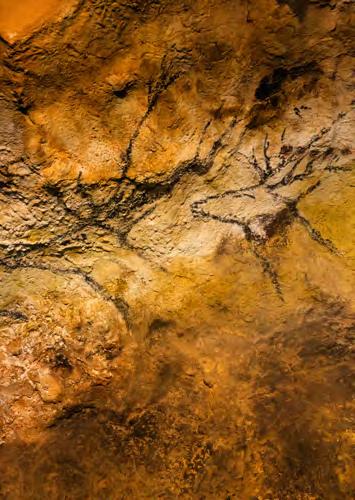
Lesson 4
From Hunters and Gatherers to Farmers 4 6
How did the development of agriculture change daily life in the Neolithic Age?
Unit Closer
Studying Sources 5 4 Timeline
unit 2
Unit Opener
Geography Challenge 60 Inquiry Project 6 4
Lesson 5
The Rise of Sumerian City-States 6 6
How did geographic challenges lead to the rise of city-states in Mesopotamia?
Exploring Biographies – Detecting the Past: Clues from Archaeology
Lesson 6
Ancient Sumer 78
Why do historians classify ancient Sumer as a civilization?
Investigating Primary Sources – How Did the Different Social Classes of Sumer Interact with One Another?
Lesson 7
Exploring Four Empires of Mesopotamia 92
What were the most important achievements of the Mesopotamian empires?
Lesson 8
Ancient Persia and Its Context 102
What can we know about ancient Persia?
Lesson 9
The Achievements of Ancient Persia 122
In what ways did ancient Persians influence the world around them?
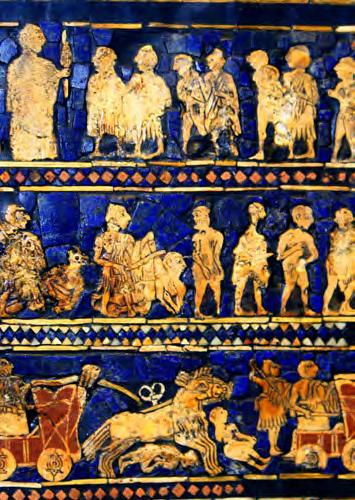
Lesson 10
Early Civilizations in the Americas 148
What do we know about the ancient civilizations in the Americas?
Unit Closer
Studying Sources 164 Timeline Challenge 168

Geography Challenge 170 Inquiry Project 174
Lesson 11
Geography and the Early Settlement of Egypt, Kush, and Canaan 176
How did geography affect early settlement in Egypt, Kush, and Canaan?
Lesson 12
The Ancient Egyptian Pharaohs 184
What did the pharaohs of ancient Egypt accomplish, and how did they do it?
Exploring the Social Sciences – The Egyptian Mummy Project
Lesson 13
Daily Life in Ancient Egypt 196 How did social class affect daily life in ancient Egypt?
Investigating Primary Sources – What Was It Like to Be a Scribe in Ancient Egypt?
Lesson 14
The Kingdom of Kush 214 How did location influence the history of Kush?
Lesson 15
The Origins of Judaism 220 How did Judaism originate and develop?
Lesson 16
Learning About World Religions: Judaism 230
What are the central teachings of Judaism, and why did they survive to modern day?
Unit Closer
Studying Sources 238 Timeline Challenge 24 2
Unit Opener
Geography Challenge 24 4 Inquiry Project 24 8
Lesson 17
Geography and the Early Settlement of India 250
How did geography affect early settlement in India? Exploring Connections to Today – Saving the Ganges
Lesson 18
Unlocking the Secrets of Mohenjodaro 26 4
What can artifacts tell us about daily life in Mohenjodaro?
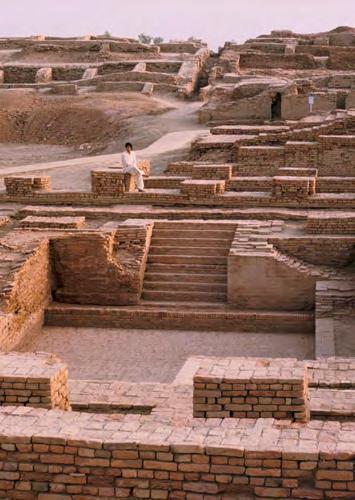
Lesson 19
Learning About World Religions: Hinduism 274
What are the origins and beliefs of Hinduism?
Lesson 20
Learning About World Religions: Buddhism 284
What are the main beliefs and teachings of Buddhism? Investigating Primary Sources – What Are Different Ways Buddhist Principles Were Passed Down?
Lesson 21
The First Unification of India 296
How did Ashoka unify the Mauryan Empire and spread Buddhist values?
Lesson 22
The Achievements of the Gupta Empire 302
Why is the period during the Gupta Empire known as a “golden age”?
Unit Closer
Studying Sources 314 Timeline Challenge 318
Geography Challenge 320 Inquiry Project 324
Lesson 23
Geography and the Early Settlement of China 326
How did geography affect life in ancient China?
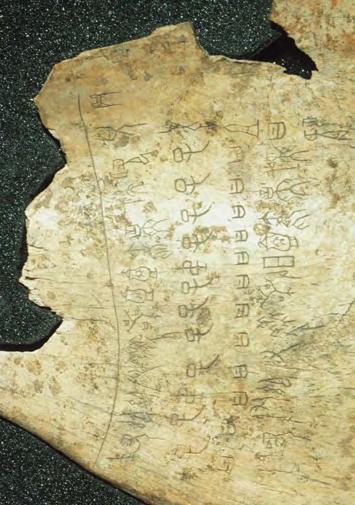
Lesson 24
The Shang Dynasty 338 What do Shang artifacts reveal about this civilization?
Lesson 25
Three Chinese Philosophies 348 How did Confucianism, Daoism, and Legalism influence political rule in ancient China?
Lesson 26
The First Emperor of China 358 Was the Emperor of Qin an effective leader? Exploring Perspectives – China’s Great Walls
Lesson 27
The Han Dynasty 370
In what ways did the Han dynasty improve government and daily life in China?
Lesson 28
The Silk Road 380
How did the Silk Road promote an exchange of goods and ideas?
Investigating Primary Sources – How Did Geography Affect Travelers Along the Silk Road?
Unit Closer
Studying Sources 394 Timeline Challenge 398
Geography Challenge 4 00 Inquiry Project 4 04
Lesson 29
Geography and the Settlement of Greece 4 06
How did geography influence settlement and way of life in ancient Greece?
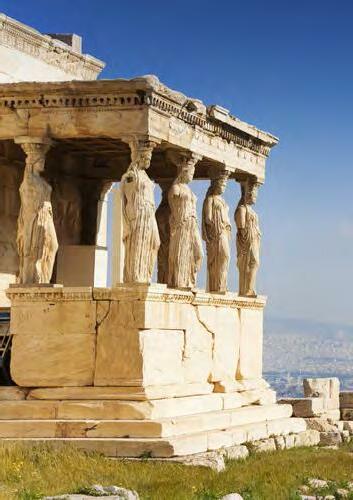
Lesson 30
The Rise of Democracy 412 How did democracy develop in ancient Greece?
Lesson 31
Life in Two City-States: Athens and Sparta 418 What were the major differences between Athens and Sparta?
Lesson 32
Fighting the Greco-Persian Wars 4 30 What factors influenced the outcome of the Greco-Persian Wars?
Lesson 33
The Golden Age of Athens 4 40 What were the major cultural achievements of Athens? Investigating Primary Sources – What Do Dramas of Ancient Greece Reveal About Its Society?
Lesson 34
Alexander the Great and His Empire 4 54 How did Alexander build his empire?
Lesson 35
The Legacy of Ancient Greece 4 62 How did ancient Greece contribute to the modern world? Exploring the Social Sciences – Painting the Gods
Unit Closer
Studying Sources 474
Geography Challenge 4 80 Inquiry Project 4 84
Lesson 36
Geography and the Early Development of Rome 486
How did the Etruscans and Greeks influence the development of Rome?
Lesson 37
The Rise of the Roman Republic 4 94
What were the characteristics of the Roman Republic, and how did they change over time?
Lesson 38
From Republic to Empire 50 0 Did the benefits of Roman expansion outweigh the costs?
Lesson 39
Daily Life in the Roman Empire 512 How did wealth affect daily life in the Roman Empire? Investigating Primary Sources – Why Did Gladiators Fight?
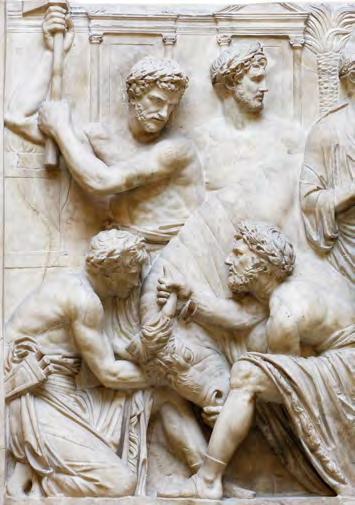
Lesson 40
The Origins and Spread of Christianity 528 How did Christianity originate and spread?
Lesson 41
Learning About World Religions: Christianity 538
How are Christians’ lives shaped by the beliefs and practices of Christianity?
Lesson 42
The Legacy of Rome in the Modern World 5 46
To what extent does ancient Rome influence us today? Exploring Connections to Today – Lessons from Pompeii
Unit Closer
Studying Sources 562
Challenge 566
Geography Challenge Watch a video to explore how geography is a useful tool when studying ancient history. Then use the maps and reading to answer the Geography Challenge questions in your notebook.

Inquiry Project Explore a compelling question of your choosing. Then complete a Student-Directed Inquiry. Gather evidence throughout the activities, reading, and additional research to write an argument that answers the question by the end of the unit.
1 Investigating the Past Through Inquiry Play the role of detectives, interpreting cave paintings and artifacts to discover clues about how prehistoric humans lived.
Key Skills: Making Predictions, Framing Questions to Research, Drawing Sound Conclusions
2 T hemes of World History Analyze images of events in the ancient world. Research one key invention from the ancient world and present your ideas.
Key Skills: Selecting Useful Information, Identifying Frame of Reference and Point of View, Sequencing Events
3 Early Hominins Analyze images of hominin groups and explore how adaptations gave later hominin groups advantages over earlier groups.
Key Skills: Creating a Timeline, Analyzing Cause and Effect, Drawing Sound Conclusions
4 From Hunters and Gatherers to Farmers Create a comic book about two Stone Age characters based on the Neolithic development of agriculture.
Skills: Comparing and Contrasting, Framing Questions to Research, Map Skills
Studying Sources Use these readings as further sources for your Inquiry Project and to deepen your understanding of the content:

• Explore – Library and Information Literacy Skills
• Explore – Piecing Together the Story of Early Hominins
Then look for additional sources online, including Explore, Primary Source, Literature, and Biography readings.
Timeline Challenge Review the key events from this unit by sequencing events on a timeline. Then add your own events that you consider to be important in history.
in to access a video-based
Challenge and Video Activities that explain the main ideas of the text with meaningful visuals.
Maps are useful tools that show where things are on Earth. They can also help you learn about the history of people and places and the interactions between them.
There are a few essential elements that can be found on any map. A map’s title describes the area shown on the map and identifies the main topic of the map.
To indicate directions, mapmakers include a small diagram called a compass rose . The points of the compass rose are
with the cardinal directions— north, south, east, and west. The points in between, such as northeast, are called intermediate directions.
Many maps include a map scale, which tells you how to read distances on the map. For instance, an inch on a map might equal 10 miles, 100 miles, or even 1,000 miles on Earth. Additionally, if symbols are used on a map, they are identified in a box known as the map key
You can begin to study a place by finding its absolute location, or “address” on Earth. Lines of latitude and longitude can pinpoint any place on Earth. Distances between these lines are measured in degrees (°).
The first set of lines, parallels of latitude, run east and west around the globe. The starting point for measuring latitude is the equator at 0° latitude. The other set of lines are called meridians of longitude. They run from the North Pole to the South Pole. Meridians of longitude start from 0° at the prime meridian.
The equator divides Earth into halves called the Northern Hemisphere and the Southern Hemisphere. Similarly, the prime meridian divides Earth into the Western Hemisphere and Eastern Hemisphere. Within these hemispheres sit Earth's seven continents, or large landmasses, and five oceans.
In addition to absolute location, maps also show the relative location of places on Earth. This is the location of one place compared to another place. For example, Africa is southwest of Asia.
Follow the steps below to complete a Student-Directed Inquiry during this unit. Use the activities and disciplinary sources to build your knowledge and gather evidence. Then construct an argument that answers the compelling question.
Developing Questions
Preview the unit. Scan the titles, essential questions, and images. Brainstorm questions that you have about the topics in this unit.
As you complete the readings and activities in the unit, narrow down and revise your list of questions until you have reached one compelling question for the unit. Consider choosing a topic that allows you to investigate social scientific problems—historical or current.
As you write your compelling question, ask yourself:
• Does it express a problem or question that interests you?
• Is it open-ended? Is it complex enough that it’s worth digging into?
• Can you propose an argument that attempts to answer the question?
Using Disciplinary Sources to Build Arguments
[student-generated]
Brainstorm 2–3 supporting questions that will help you explore your compelling question.
Identify sources that might provide evidence to answer your compelling question. Choose different types of sources that are from a variety of perspectives. Consider the reliability of each source:
• Is it a quality source? Is it from a government or educational website or a respected newspaper, magazine, or journal?
• What is the perspective of the source? In what ways might the source be biased?
Record information from the sources that you will be able to use as evidence to support your argument.
Construct an argument that addresses your compelling question. Make sure to:
• Begin with a strong claim, which you then support with at least three pieces of evidence from your research.
• Use reasoning to connect your examples and evidence to your claim.
• Acknowledge the strengths and weaknesses of your argument.
Extension Use an alternative method to present your argument. You could create a poster, a podcast, or a digital presentation.
Brainstorm ways that the information you learned connects to your school, community, or state.
For example, think about the challenges people faced and actions they took to address issues at different times and places during the unit.
What did you learn that inspires you to help others around you?
Brainstorm ways that you could use the information you learned to improve your school, community, or state.
Some options:
• Record a podcast
• Create a poster or a digital presentation
• Conduct a discussion with your classmates or family
• Research opposing views; refine your own argument
• Create or join a social media group
• Make a video or public service announcement
Brainstorm ways that you could get engaged. How can you be a leader to enact change?
Some options:
• Volunteer your time
• Donate money
• Organize a fundraiser
• Start a charity
• Help others follow a current law
• Advocate to adjust a law or policy
• Organize a rally
• Speak at a school or community event
• Contact local, state, or national legislators
Inquiry Project Go online to complete the activities, readings, and tasks. Fill out the corresponding prompts for each step in your print or online notebook.
Classroom Activity
how
role of
past
and interpret
about how social scientists investigate the past through a video covering the main ideas of

Activity
an online activity to show what you’ve learned.
lesson
your online or print Interactive Student Notebook to bring meaning to the reading you’ve completed.
Text with Notes
Welcome to the world of ancient history. Studying history involves investigating what happened in the past and why. Ancient history concerns the distant past, from the earliest humans through the first great civilizations.
How can we learn about events that happened so long ago? People who study history are a lot like detectives conducting an investigation. They ask questions, study the evidence for clues, and form hypotheses (educated guesses based on evidence).
Our investigation of the ancient past starts near the very beginning of human history. What was life like long, long ago?
One amazing clue about life long ago was discovered at Lascaux (lah-SKOH), France, by four teenagers. On September 12, 1940, the boys found a cave. Covering the walls and ceiling of the cave were what appeared to be very old paintings of animals. Some of the figures look similar to modern-day animals, such as horses or bulls. Who had created these large paintings? When were they composed, and what did they mean?
How would you solve a mystery like this one? The clues are millennia old, and the witnesses are long gone. You might need the help of an expert detective, but who would that be?
In this lesson, you’ll meet three kinds of experts who study the past. You will discover how they analyze and interpret clues left throughout history. Then you will look at some fascinating examples of cave art to see what this evidence can teach us about life long ago.
Scholars study cave paintings, like this one found in Lascaux, France, to learn how humans lived long ago and study clues about their cultures.
Social Studies Vocabulary archaeologist argument artifact bias compelling question geographer historian inquiry prehistoric primary source public policy ritual secondary source supporting question
archaeologist an expert who studies the past by examining objects that people have left behind historian an expert who studies and records the past
geographer an expert who studies and creates maps of Earth’s natural and humanmade features
artifact an object made or used by people in the past prehistoric before written history
Scholars who study human society are called social scientists. Many social scientists can help us study the past. Among these “history detectives” are archaeologists, historians, and geographers.
Archaeologists: Digging Up the Past Archaeologists study the past by examining objects, or artifacts, that people have left behind. These artifacts are anything made or used by humans, such as clothing, tools, weapons, and coins. When archaeologists uncover a place that has artifacts, they ask questions like these: Who lived in this place? When did they live here? What were they like? Then archaeologists study the artifacts for clues.
Archaeologists use tools to delicately retrieve artifacts, which give them clues about the past. A grid system is often used to organize where on a site each artifact was found.

Historians: Recording the Past Historians are the recorders of the past. Human beings have been around for such a long time that historians tend to focus mostly on the last few thousand years, when people began leaving written records. Historians want to answer this question: What happened in the past? To find out, they study all kinds of artifacts and documents, including diaries and letters. Besides asking what happened in the past, historians try to understand why events happened the way they did.
Geographers: Mapping the Past Geographers study the natural features of Earth, such as water, landforms, plants, and animals. They also look at human-made features, such as towns, roads, bridges, and dams. These scientists help us answer such questions as: Where did people live? How did they use their environment to survive? Geographers often create maps to show what they have learned.
Social scientists who study prehistoric his tory face a unique challenge—a lack of evidence from this period. In fact, huge gaps of time have no evidence at all. Therefore, scientists may come up with different answers or theories about how humans came to be.
Cave paintings like those at Lascaux, France, provide clues about what life was like in prehistoric times, before writing was invented. Caves with paintings that are thousands of years old have been discovered all over the world. Some paintings show what kinds of animals roamed the Earth and what methods people used to hunt them. Often, the paintings provide hints about people’s beliefs.
Many of the rooms decorated with paintings are deep inside the caves. Scientists believe that cave artists used torches to work in these dark places. Some paintings are very large in size and taller than a person’s height. Some paintings are found on high ceilings. Scientists think that prehistoric artists built scaffolding, or planks raised above the floor, to reach the highest places.
Caves have also provided information in the form of artifacts. Scientists have found lamps for burning animal fat and tools for painting and engraving. Cave paintings and artifacts are amazing treasures that can help answer many questions about how humans lived in ancient times. But, as you will see, these treasures also raise new questions for scientists to puzzle over.
Cave painters developed a variety of methods for applying paint to walls of a cave. This artistic rendition shows a number of these techniques. Can you identify any?
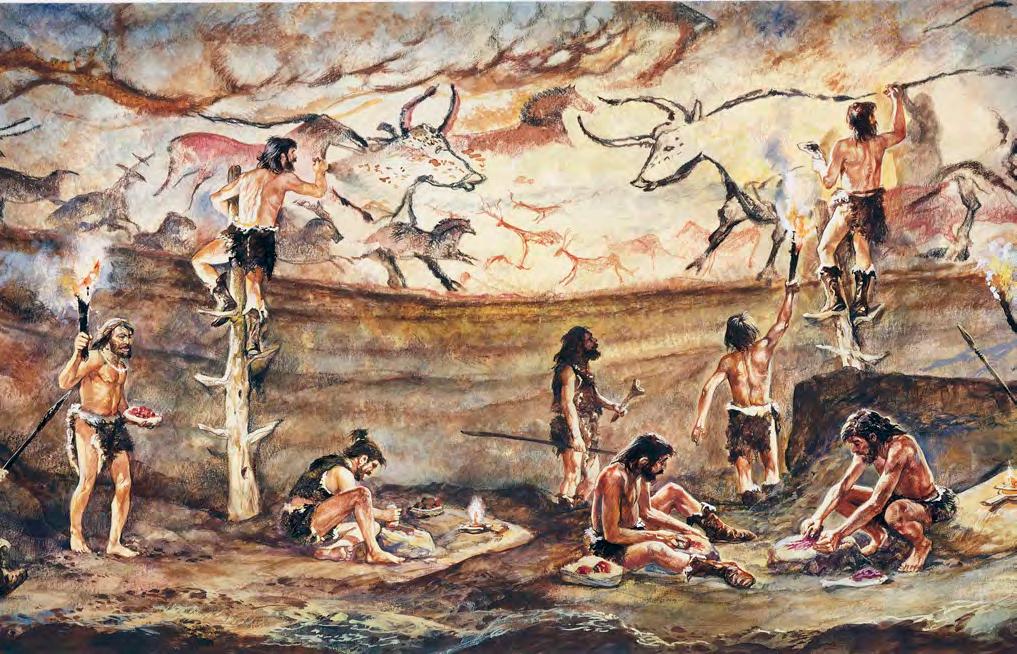
This hunting scene possibly shows items used in special ceremonies. Notice the weaponry the hunters are holding.

This painting was found inside a cave at the Bhimbetka rock shelters in India. It was painted between 4,000 and about 10,000 years ago. The painting shows a scene from a hunt in which riders on the backs of animals are holding a weapon. This weapon is a spear, which was typically hurled with a spear thrower. The animals resemble a horse or similar species. The legs of the animals make them appear in motion.
Paintings of humans are less common in cave art. Notice the simple drawing of the hunters, each in the same body position. The animals are much more realistic with their ears and tails.
Many social scientists suppose this painting was created as part of a hunting ritual. The artist may have been asking for a successful hunt. It is also possible that the painting is a record of an actual event, or it may simply be a decoration.
This painting, found at Lascaux, was created more than 17,000 years ago. It shows many prehistoric animals, such as bulls, elk, and horses. But the public cannot view all of the animals at Lascaux. Parts of the cave have been closed in order to protect the art.
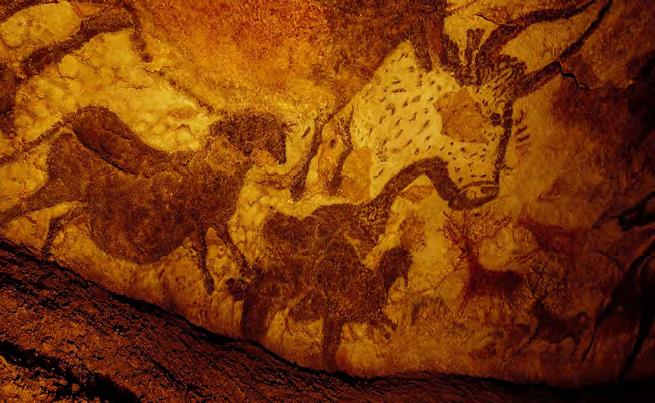
ritual relating to a ceremony, such as a religious ceremony
The painters used the cave’s uneven walls as part of their composition. In the bottom left of the image, a ledge juts out from the wall. The artists painted the bulls to look as though they were standing on top of it.
Scientists have many ideas about why animal paintings were created, such as that the artists were trying to capture the “magical powers” of certain animals. Another theory is that the painters believed in the spirit world and were creating art to honor or influence their gods. Some scientists speculate that caves were places of worship and that paintings were used in rituals or ceremonies.
Historians still wonder why these animal paintings were created. Perhaps the difference in coloring among the animals provides a clue. What do you think?
The handprints seen in this cave painting are very small. Prehistoric people were probably smaller in size than people are today.
This painting is in a cave called the Cueva de las Manos, or Cave of Hands, in Argentina. It shows a circular shape, multiple animals, and several handprints.
Paintings of shapes and handprints are fairly common in cave art. Many scientists suggest that handprints were a way for artists to sign their paintings. Some scientists think that geometric shapes had special meanings in rituals.

Researchers tried singing inside one painted cave in France. They discovered that the sound was loudest in the painted areas, and therefore supposed those areas were probably used for special gatherings.
In prehistoric times, spears were often lodged inside a spear thrower, which would release the weapon faster than when normally thrown. This image shows the top of one type of spear thrower that has broken away from the rest of the device. Found in France, it was made from a reindeer antler bone about 15,000 years ago. It now measures 12.4 centimeters long but would be much longer if it was fully intact.
This spear thrower top depicts a mammoth. The artist engraved, or carved, the eyes and legs to show details in the animal. The artist must have cared a great deal about decorating this important hunting tool.
Some scientists think that the artist carved the mammoth as decoration for a spear thrower, but the carving may have been a good-luck charm to protect the hunter or make them more successful. It also could have some relation to the hunter’s name, or even been a way of identifying the clan or group that the hunter belonged to.
This sculpture of a mammoth is the only known spear thrower to have holes for eyes. Historians believe that this shows an advance in prehistoric tools and a very skilled artist.

This clay sculpture may offer clues about the people who made it and why. Historians suggest it was a significant part of a coming-of-age ceremony.
This clay sculpture of a bison was found in a low room, deep inside a cave in France. It was made about 10,000 to 14,000 years ago and measures about 24 inches in length. The artist sculpted it from goldcolored clay. Carved lines show details such as the animal’s face, coat markings, and the fringe of fur below its powerful neck.
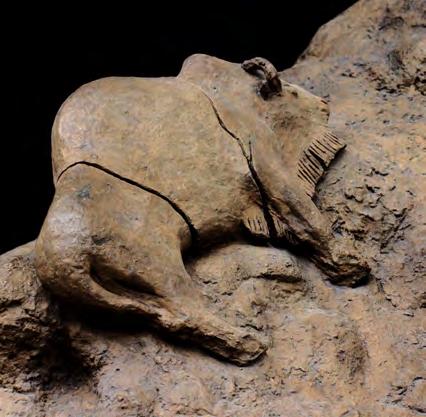
Scientists have two main ideas about why this sculpture was created, one of which is that the sculpture was meant to show that the cave belonged to a certain clan. The other idea is that the sculpture was used in an important ceremony held deep inside the cave. Perhaps it was a coming-of-age ceremony to show that a person had passed from childhood to adulthood. One clue that supports this idea is the footprints of young people that have been found near the sculpture.
Prehistoric tools included engraving tools, grinding stones, and scrapers. Scientists study tools like these and try to guess how they were used.
For example, scientists think that cave artists made paints by grinding colored minerals into powder on grinding stones. The artists then probably mixed the powder with animal fat or vegetable oil to create various colors. When the artists wanted to include the color white in their paintings, they used scrapers to remove the top layer of rock to reveal a white layer.
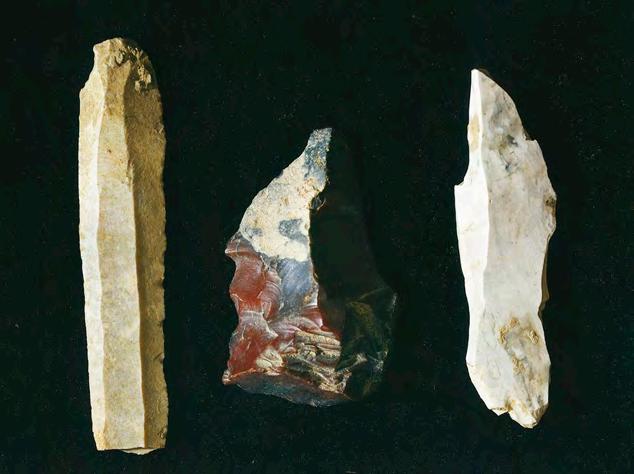
You’ve already seen how prehistoric artists engraved some of their art. For painting, they may have used brushes made of moss, fur, or human hair. They may even have blown paint through hollow tubes to create softer textures, such as shaggy winter coats on horses.
Cave artists used tools made of sharpened stones to grind minerals for paints. Other stone tools were also used to sculpt and engrave objects and cave walls.
Historians and archaeologists have collected evidence of how prehistoric humans lived. They put that evidence into a story of past events that is accurate and meaningful. To carry out their work, they follow certain methods to help them understand information. French poet and author Jacques Yonnet compared the work of a historian to that of a detective.
Modern historians follow professional standards. Unfortunately, these standards were not clearly established in the past. For example, in the early days of archaeology, scientific procedures were not laid out well. Nearly anyone with the money, the time, and the interest could select a promising site and start digging in search of history.
This led to many problems. In a lot of cases, the early archaeologists were foreigners. Yet they collected ancient statues, pottery, and other things from tombs and burial sites and sent them to other countries. Today, many countries are demanding the return of these artifacts.
Another problem was that amateur historians often destroyed what did not interest them in order to find the flashy treasures they were after. This has made the later work of serious historians much more difficult. But it has also caused them to re-evaluate their priorities. Today, they try to carefully consider what might be destroyed as they excavate a site.
Finally, historians today realize that they must be honest about what they plan to do with their findings. For example, if DNA was collected from a particular ethnic group for a specific reason, the DNA cannot be used for another reason.
Suppose that DNA was collected to discover whether an Indigenous community had a pattern of diabetes. The commu nity agreed to this. Other researchers, however, would not later be able to use that DNA for other research, such as discovering whether this community shared DNA with Indigenous groups in South America. They would first need to gain permission for this new research. Public policy like this helps to protect the privacy of regular people and makes sure the collection of data is fair and focused.
The tomb of the pharaoh Tutankhamun was discovered by British archaeologist Howard Carter. Most of the artifacts found in this tomb remain in a museum in Cairo, Egypt, the country it was found in. However, there are concerns that many valuable artifacts were removed from the country. It will probably never be known for certain what was stolen.
public policy the laws and regulations that determine how problems can be solved in response to social issues
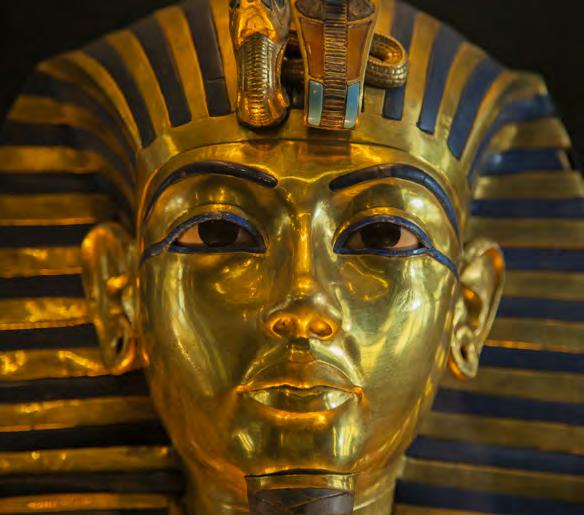
inquiry in history, the process of exploring the answers to questions about a certain time and place
primary source a document or other record of past events created by someone who was present during the events or the time period in which they occurred secondary source a document or other record of past events created by someone who was not present during the events or the time period in which they occurred
History Begins with a Question or Problem Historians usually begin their work by finding a question they hope to answer or a problem they wish to solve. These questions often focus on how or why an event happened, rather than simply asking what occurred.
Historians first have to make an observation about the real world. A historian studying ancient China might note that many religions spread across Asia during the period of the ancient Silk Road. This is an early step in the process of inquiry.
Historians then use their observations to form their ques tions. One example question might be, How did the ancient Silk Road trade routes help spread religious ideas across Asia? With this question in mind, a historian will come up with a possible explanation that they believe answers this question. This expla nation is called a hypothesis.
Historians Select and Weigh Evidence Next, they col lect facts and information related to the question. This material becomes the evidence, or information that can be used to prove a statement or support a conclusion.
Photographs are visual primary sources that show what life was like in the past.

Historical evidence comes in multiple forms. It might be an old letter, a manuscript, or an artifact. Sometimes public policy may limit how or where artifacts may be dug up or stored. Evidence can also be found in photographs, music, and movies. Additionally, it can be found in books, newspapers, and in interviews with experts or historical figures.
Historians call these various forms of information sources. There are two basic types of sources typically relied on when writing history. A primary source is a document or other record of past events created by people who were present during those events or during that period. The journal of a Silk Road traveler would be a primary source.
A secondary source, in contrast, is a document created later in time, often by experts. Examples include a book or accounts from someone who was not present at the events in question or perhaps not even alive during that period. Many secondary sources are created decades or even centuries after the events in question. A modern history book that includes information about the Silk Road would be a secondary source.
Sometimes a source contains information or conclusions that show a clear point of view. Although this is not necessarily bad, his torians are watchful for signs of bias when analyzing evidence. Bias takes many forms, ranging from a simple friendship or preference for someone to an unfair dislike of a person or group. Regardless of its form, bias can make a source less than trustworthy.
All historical evidence must be critically evaluated. Historians carefully examine each source for the creator’s point of view, perspective, or outlook on events. This outlook may be influenced by multiple factors, such as the person’s age, gender, religion, occupation, or political views. For example, a historian would expect that a Chinese Buddhist pilgrim traveling along the Silk Road would have had a point of view different from that of a European merchant.

Historians Interpret Their Findings Once their evidence is selected and evaluated, historians begin to reconstruct what happened. They often begin by establishing a chronology, or sequence of events in time. Once historians are certain of the correct order of events, they are better able to make connections among those events, like identifying causes and effects. However, the more challenging part of a historian’s task is to interpret the past—to weave together the evidence and help readers under stand and draw meaning from history.
The process of finding the meaning or significance of histori cal events is called historical interpretation. By interpreting history, historians combine their analysis of events with the facts they have validated in order to create a general theory about what happened in the past. This theory often includes what hap pened, how and why it happened, what effect it had on the people involved, and how it may have shaped the world today. Each historian brings a particular point of view to this task. However, historians try to ensure that their interpretations are faithful to the facts of history and are supported by the evidence.
History Is Never Finished Much of history is still open to interpretation. In fact, historians often make opposing arguments regarding the past. Because historians have different backgrounds and points of view, their interpretations will often differ. They publish their work with the understanding that it will be reviewed, and often criticized, by other historians. In this way, history continues to be debated and revised.
bias a personal leaning or a preference for a particular outlook argument the position that researchers take about a particular topic, based on the evidence that they have gathered Discoveries may change understandings of the past as new artifacts or sites are explored, such as newly found objects or tombs from ancient Egypt.
compelling question a question that does not have a simple or direct answer and requires some thought and investigation to answer
There’s no better way to understand the process historians go through than to conduct your own inquiry into history. An easy way to do this is to investigate something about your own community. As we review the steps in a historical inquiry, we will take a closer look at some historical investigations that will give you additional tips on what to do and what to avoid.
Begin by brainstorming to arrive at a compelling question. You might start with a list such as this one:
• Who were the first people in your area?
• What are the town’s origins? How did it get its name? Who were the town’s founders? What are some of the famous or key events that have happened?
• What are some natural landmarks (for example, the oldest tree)? What are some long-standing businesses, which may have supported a large part of the community or been a local favorite, such as a barber shop?
• What are some legends or stories about your town?
■ Ask a Compelling Question
W hat do you want to know about an event or topic?
■ Ask Supporting Questions
How can you better understand an event or topic? What facts can be uncovered?
■ Apply Social Studies Concepts
How do your questions connect to related areas such as civics, economics, geography, and history?
A re your sources mostly primary or secondary? Are they reliable?
Discuss with other students and your teachers. How could you share your conclusions with your community?
Did your research uncover a problem? Is there a way to make the his tory you learned about more relevant to your school or community?
Today we can study Minoan clay figures ourselves. We can ask who these figurines represent. But we should use only evidence to find our answers, and not imagine the answers.
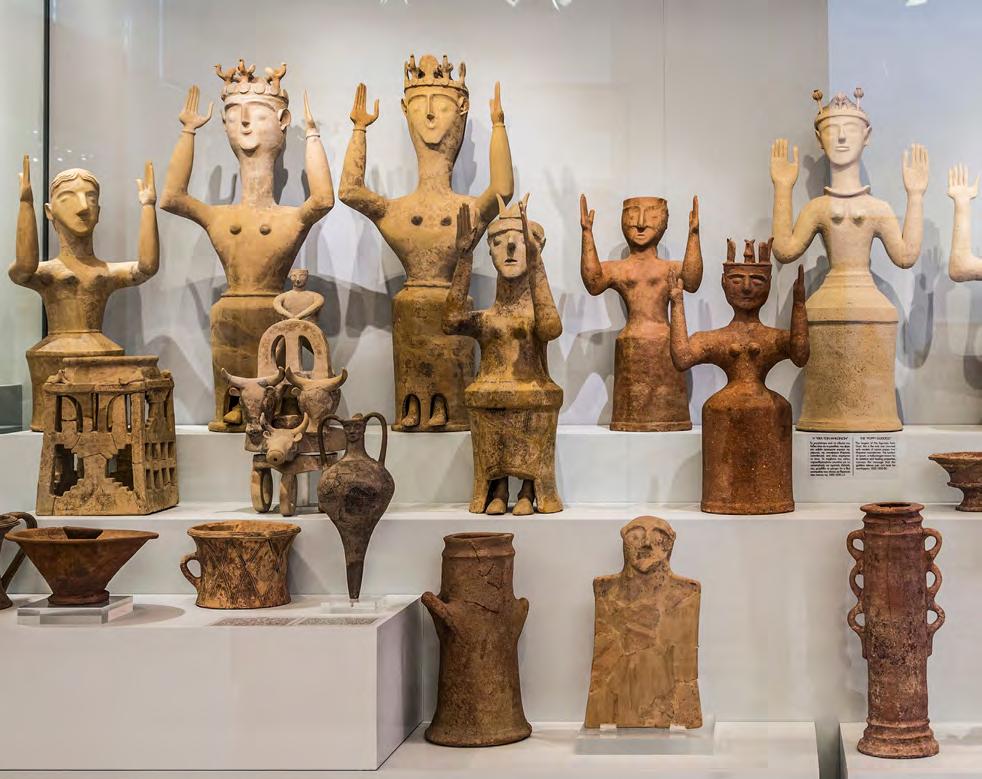
Before 20th century research standards for archaeology were established, the field often attracted well-to-do amateurs who had the wealth to pursue their hobbies in these fields.
Sir Arthur Evans knew a great deal about ancient Mediterranean cultures, pos sibly more than many in his field. He funded his excava
tions of Crete, which led to knowledge of an entire new world. But was the world he discovered accurate? Evans imagined a woman-oriented society. When he discovered parts of small female statues, he already had a clearly imagined idea of what that culture would look like. When the statues he found did not meet his
imagination, he pieced together statues from the ruins to fit his idea.
Evans had a compelling question: What was the Minoan culture like? But he made the mistake of answer ing his compelling question before carefully weighing the evidence.
Most strong research begins with a compelling question. This compelling question may lead to a very clear line of research. However, it might also create new and interesting questions around an event or topic.

Inquiry in Action After reviewing the brainstorming questions in a group session, Erika, a sixth-grade student in Maryland, is interested in the question of legends about her town. She lives in a suburb, but the older kids have always told stories about the unusual mansion at the edge of their neighbor hood. It sits on a low ridge surrounded by trees. It is nothing like the rest of their homes that all look so similar. One Halloween, a high school girl told everyone nearby that the mansion used to be an important stop on the Underground Railroad that helped escaped enslaved people travel from the South up to Canada.
Erika decided that her compelling question was: Did that mansion participate in the Underground Railroad?
Barry, another middle school student in Colorado, had a similar assignment. His older sister who was in college had just spent days talking to the family about how exciting it would be if their town re-opened their railroad station. “People need to be able to travel without getting into a car!” she argued.
He mentioned this in a classroom discussion. His teacher pointed out that their town had once been a popular stop on a regional stagecoach route during the 19th century. “We were prosperous back then too,” he added.
It takes Barry a while to work out his compelling question, to connect the dots. But he finally decides on his question: Are towns more prosperous if they are a part of a strong transporta tion system?
Both Erika and Barry have started with yes/no questions, which they will learn are good starting points, but sometimes may be difficult to answer. We also have to add the questions of When? Who? Where? Why? How?
Local history experts can often help students conduct an inquiry into history.

Supporting Questions
In addition to asking the basic W-Questions, strong supporting questions consider what sources and evidence may be available.
Erika may not be able to answer her question if neither primary nor secondary sources that she finds mention the house she is interested in.
Barry, on the other hand, is asking a question that is too broad. He needs to scale back from what makes all towns pros perous and focus more closely on just his town’s history.
Both Erika and Barry also need to review whether any answers to their supporting questions may be open to interpreta tion. Both of them may benefit from feedback from members of their community who have studied their local history. But even if Erika learns that many others have heard the same legend, she has not yet come across any hard evidence. The things that people tell one another, whether true or not, is sometimes called hearsay. We do not consider something to be evidence just because it has been repeated a lot.
However, if she found someone whose grandparents had worked in that house, she would be closer to an example of primary evidence.
Applying Social Studies Concepts History has many cousins. We learn more about our past from the many fields that also go far back such as art, music, architecture, literature, and philosophy. In the social sciences, historians are also interested in how their compelling questions relate to civics and the way prior civilizations were governed. How do their questions relate to economics and the way people traded and how goods and resources were exchanged? How do their questions relate to geography—the way that the physical landscape impacted a time and place?
supporting question a question that has a concrete answer based on factual information that can be researched and proven; supporting questions will help answer compelling questions
For the last hundred years, scholars have been at work deciphering and interpreting the discovery of over 20,000 letters hammered out in stone. This treasure of evidence was found in what is today Kanesh, Turkey. When the letters were written, Kanesh was a trading town within the Assyrian empire, which existed 4,000 years ago. The Assyrians ruled an area that stretched from present-day Iran through Iraq, Syria, and Turkey.

As historians gradually made their way through this vast new evidence of 20,000 letters, they learned much about how the society functioned, its laws, and government. They learned about the trade network that brought goods from distant lands and places.
Recently, a French historian focused on tablets that were written by women. Cécile Michel’s work showed that women in this civilization were literate, that they were engaged in the family business. And that they could appeal to the social norms to help them.
“I have nothing else apart from these funds,” one woman wrote her brother in cuneiform script. “Take care to act so that I will not be ruined!”
It has taken a lot of time for historians to work through the many letters dis covered at Kanesh. Here and elsewhere, historians continue to ask questions about how ancient societies worked. But it took just one woman to ask the compelling question: In what way were women involved in this civilization?
The Assyrian tablets written in cuneiform script from Kanesh, Turkey, have taken many decades to study and fully understand.
Students can conduct an inquiry process individually or with others. Discussing with others may lead students to uncover a source or question they had not considered.

Both Erika and Barry’s inquiries stretch across civics, economics, and geography. People escaping slavery were break ing the law and so were those helping them. The law was set to protect the economic value that those escaping enslaved people had to their enslavers. And geography mattered enormously. Three days or three steps north and you were free.
As you dive into your inquiry, look closely into the ways civics, economics, and geography relate to the topic you are investigating. By doing so, your findings are likely to become richer and more interesting too, telling a more complete story of the past.
Like the histori ans examining the 20,000 cuneiform letters discovered in Kanesh, Turkey, Barry had given himself a lot of homework. Not only were there hundreds of articles to read in the town’s newspaper, Barry did not believe that he was very good at deciding which were promising. Luckily, his teacher announced that the class could now shift from their individual inquiries and collaborate on the group inquiries of their choice. Three of his classmates joined his inquiry. As a team, they not only cut down the workload, but they brainstormed together and motivated one another.
Leon came to one of their research sessions with a handful of old tourism books his aunt had given him. “It’s not a reliable source, but it may give us some ideas.” In fact, the history section of the tourist guides gave them wonderful ideas on what to search as they plowed through the newspaper archives.
Mai kept them focused. “Remember, we are looking for information to support our claim that prosperity declined after the stagecoach left our town in 1895.”
Routes used by people working the Underground Railroad could take people escaping enslavement over land or sea. Small groups would travel by foot, horse, or wagon to reach safety.
Communicating Conclusions and Taking Appropriate Action Research is carried out in order to contribute to our understanding of our past. After all, if we do not know what our future will bring, we can at least study our past. The lessons there may help us navigate our future as individuals and as a society.
Historians and scientists publish their findings so that other scholars in their field can check their thinking, their evidence, and their conclusions. Sometimes they may meet to discuss find ings. Such close examination of the evidence, this close degree of fact checking, is helpful. It is one more way to guard against bias, bad research collection, and misunderstanding.
Erika discovered through a member of her community who was in her eighties that the mansion had never been a regular stop on the Underground Railroad. Word of Erika’s project had spread, and a friend of a friend of Erika’s mother had come forward. The woman said her grandfather had worked at the old mansion. She had never heard from him that it had assisted people escaping slavery. “I sure wish it had though.”
Erika and her sources resisted Sir Evans’ temptation to write the history that they wanted to hear. Instead, Erika’s research led her to create a map of the homes in her county that had helped the Underground Railroad. After her map was fact-checked by her school, local libraries began to display it on their walls. Because she finds the topic so interesting, Erika is still research ing her question, long after she got an A on her project.
Barry’s team discovered that their town had been one of the most important crossroads when the stagecoach came daily. Digging deep into the records of property sales, they were able to chart how businesses, homes, and farms declined in value when the stagecoach left. In turn, the town’s population also declined.
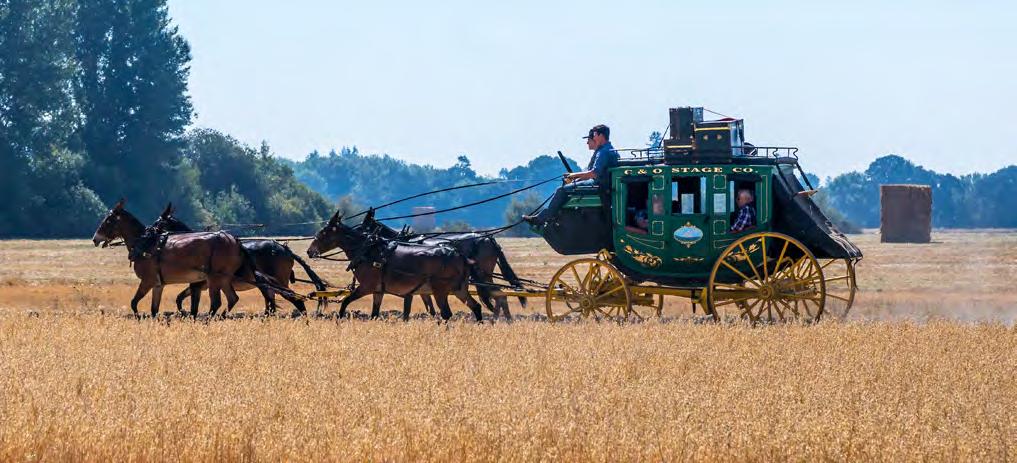
Barry and his sister understood that many years had passed since the stagecoach stop had helped to make their town prosperous. However, they also thought evidence of their town’s past prosperity due to the increased stagecoach traffic might be an indicator for their town’s future prospects as well.
They transferred their data onto a graph. Then Barry’s sister took it to the town council to help make her argument that her idea for a new improved railway stop could improve her town’s future. She hoped that the lawmakers might make decisions for the future of their town and work to bring public transportation back. This move had the possibility of being both environmentally friendly and also economically beneficial for her town. Barry’s sister was using evidence from the past to try to improve the future.
Historians use statistics gathered during their research to draw conclusions regarding their compelling questions.
In this lesson, you’ve learned how social scientists investigate the past by using clues they find to form hypotheses.
Detectives Who Study the Past Social scientists include archaeologists who examine artifacts that people have made and left behind, historians who study the written records that people began to leave in the last few thousand years, or geographers who look at the natural and humanmade features of Earth.
Cave Art Caves have provided clues to the past for social scientists. Cave paintings and sculptures thousands of years old have been found all over the world. Artifacts also have been discovered in caves. The art and artifacts provide information about how people lived long ago.
Cave Art Tools Cave artists used sharp stones to grind colored minerals into powder. They mixed the powder with animal fat to create paint. They may have used moss, fur, hollow reeds, or their own hair as paintbrushes.
How to Study the Past Modern historians follow professional methods to arrive at a picture of the past that is as accurate as possible. They carefully select, weigh, and interpret the evidence available, taking care to avoid bias.
Planning Your Own Inquiry By following the steps of the inquiry process, students can learn more about how historians discover the past and use evidence to draw conclusions.
Classroom Activity
images of events in the ancient world. Research one key invention from the ancient world and present your ideas.
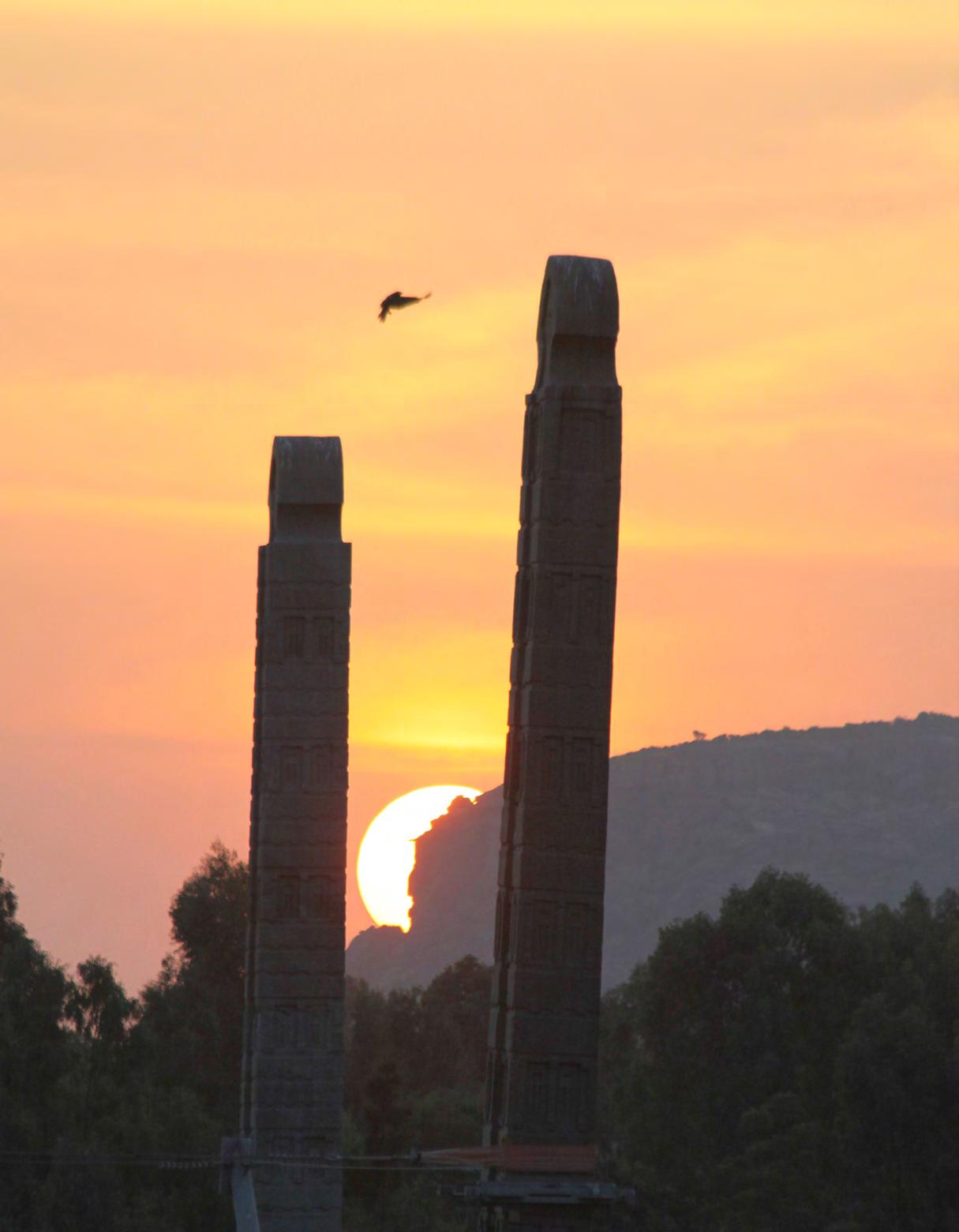
Video Activity Investigate the common themes of world history through a video covering the main ideas of the lesson and complete an online activity to show what you’ve learned.
Text with Notes Use your online or print Interactive Student Notebook to bring meaning to the reading you’ve completed.
In this lesson you will learn about the way we interpret civilizations that have existed in unique locations all across the globe. Each of these groups arose in different places and at differ ent times. But there are many common themes among them.
These similarities include the settlement of people based on geography and climate as well as the development of social structures. Also, you’ll learn about the birth of arts, architecture, writing, government, politics, and religion within these civiliza tions. You will also read about how webs of vast, complex trade routes connected these ancient peoples and brought them new ideas and products. Finally, you’ll discover how huge empires rose from rural and urban societies as well as why they failed.
Of course, world history is more than the rise and fall of civilizations. It’s also about the themes that we find in each of the civilizations. In addition, they might share similar characteristics or traits. How people interact with their environment, how and what they believe, and the way they govern all come from somewhere in the past in some way. Learning the ways that people once lived helps us understand the themes of our own world and time because many of these ancient ways still exist.
While studying history, you’ll learn about each of these civilizations based on their location in the world. But first, let’s explore them based on their common themes. Keep these pat terns in mind as you explore the wonders of the ancient world.
These obelisks at Aksum in present-day Ethiopia were probably built in the 4th century c.e. An ancient practice in the region was to build obelisks to mark burial sites.
Social Studies
Vocabulary
gender roles kinship pastoral nomad
Civilizations and kingdoms that arose in ancient Egypt demonstrate each of the six key themes.
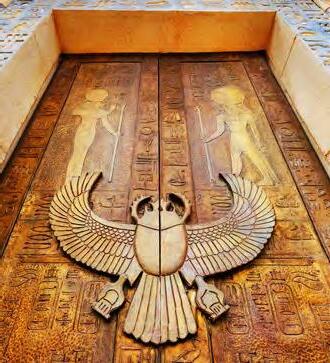
Historians use themes to identify patterns in history. Many possible themes can apply to historical events. Two broad themes are continuity and change, that is, the way things have stayed the same or changed over time. Two other broad themes are integra tion and difference. Integration refers to ways in which the peoples of the world have been drawn together by historical factors. Difference concerns how they have remained distinct and diverse.
Historians often highlight six themes in world history: human-environment interaction, rise of civilizations, growth and changes in societies, development of political institutions and ideas, belief systems, and interconnectedness of societies. Studying history with these themes in mind will help you make connections among events and interpret the past.
Human-Environment Interaction The interaction between humans and the environment is the first theme. The environment has been a key factor in human activity throughout history. It has affected how and where people live and how they support themselves. At the same time, human actions have also changed the environment in many ways. This theme covers topics such as disease, population growth, migration, and patterns of human settlement.
The way in which civilizations rose is another important theme. As early humans learned the advantages of cooperating with one another, they began to form communities and societies across the ancient world. Many of these communities developed into early cities called city-states, and eventually formed civilizations. Not all civilizations devel oped in the same way, however. Some civilizations developed writing but a few did not. Even between similar civilizations, there were major differences. For example, some built massive cities with trade networks. Others had complex trade networks, but without large or fully permanent cities. Today, evidence remains of the success of these civilizations.
This theme covers a wide range of topics. Some examples are:
• the development of trade networks
• the improvement of the written language
• artistic and architectural advancements
• the unification of smaller states
• the prominence of patriarchal societies
The organization of societies is also a key theme. In prehistoric times, people formed social groups to meet their need for food, shelter, and security. Over time, social groups banded together to form societies. Although social structures varied from culture to culture, they also had many things in common. By examining and comparing these structures, we can get a better understanding of human life.
Among the topics covered by this theme are gender roles and relations, including the place of women in society. Other topics include customs relating to family and kinship, racial and ethnic differences and their impact on society, and divisions of social and economic class.
Another key theme is the creation of political systems and forms of government. World history has often been presented as a series of one ruler or government after another. It is much more than that. Nevertheless, political structures are an important aspect of history and a key element in the growth of civiliza tion. Some civilizations have favored complex governments and systems, while others might prefer less complex ways of organizing society. The way in which people have organized and governed themselves says a great deal about human society.
Various topics fall under the theme of development of politi cal institutions and ideas. Forms of government, how city-states and civilizations grow, and the ways political revolts and revolu tions happen are examples of these topics.
gender roles customs relating to the position of men and women in society
kinship family relationship, either by birth, marriage, or adoption
Belief Systems
An additional key theme is the creation and development of belief systems. As ideas continued to develop throughout the ancient world, new philosophies and religions began to emerge. These belief systems often brought great social and political change
A number of topics fall under the theme of belief systems. Here are some examples:
• the perseverance of Jews under Roman persecution
• social changes in India as Hinduism gained followers
• the cultural impact Buddhism had on Indian empires
• the impact of three philosophies on Chinese societies and order
• the birth of Jesus Christ and his effect on ancient cultures
• the spread of Islam and its impact on the world
Cave paintings, or carvings like this one, reveal interesting details about ancient peoples as well as their inventions and cultures. This carving from Newspaper Rock in present-day Utah shows ancient Indigenous art.
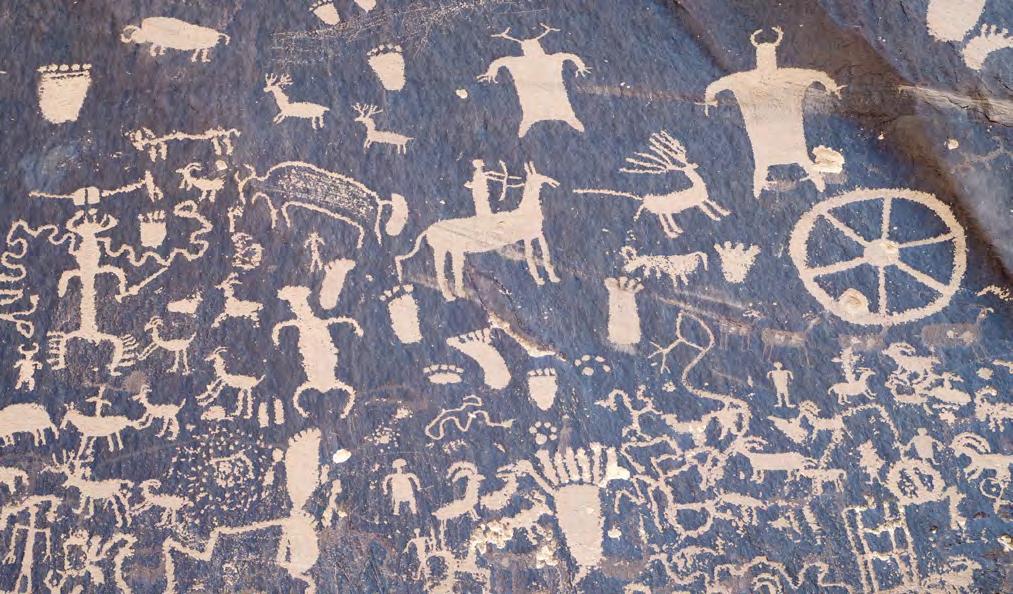
The last theme you’ll learn about is the interconnectedness of societies. The new ideas, products, and advancements that were developed in one part of the ancient world eventually reached other parts of it. Large networks of trade routes throughout the world connected the groups you’ll learn about, resulting in the combining of cultures.
Various topics fall under the theme of interconnectedness of societies. Some examples are:
• the exchange of inventions and products
• the spread of religions and arts
• the migration of people to new locations
• the practice of diplomacy among societies
About 25 million years ago, a primate group called the Great Ape family split into apes and monkeys. Both groups thrived in trees, but they had some differences between them. While apes used their arms for locomotion by swinging in trees, monkeys primarily used their four legs for travel. As apes developed strong vision, monkeys developed a better sense of smell. Apes later split up into two other groups: today’s apes (chimpanzees, bonobos, and gorillas) and hominins. Some of these hominins went on to become modern humans.
Even though there are many ideas regarding the evolution of these hominins, many scholars agree that hominins of the Homo genus developed about 2.5 million years ago. Like our closest non-hominin relative the chimpanzees, Homo sapiens walked on two feet at least some of the time and appeared around 6 million years ago. Eventually they evolved and could walk upright.
Evolution of Homo sapiens outpaced the other hominin groups about 70,000 years ago as its brain growth continued, which required larger food intake. These larger brains made great social and technological advances such as pair-bonding, sharing of knowledge and technical skill, the ability to imagine and plan, and the creation of cultures and myths. Pair-bonding, or having a single mate, allowed for more extensive child rearing and contributed to survival success.
The ability of early humans to adapt to their environments proved crucial to their survival when Africa’s climate got worse about 160,000 years ago, making it unlivable. Many of our early ancestors died during this time, but others migrated to the southern coast where they found food and resources. The larger brains of early humans also let them talk and work with one another. The cognitive, social, and technological advances of these early humans allowed them to better exploit and defend their territories. For these early humans, territory that was rich in natural resources was worth defending from invaders because access to resources led to increased probability of survival.
Early humans moved across the Earth and most continents about two million years ago, driven by population gains and increased competition for food. Additionally, they began to farm, which led to new inventions and innovations. These included the herding of animals, smelting of metals, the plough, twisted rope, musical instruments, religious worship, and complex boats. Earlier breakthroughs were the discovery of fire, cooking, and development of tools. With these discoveries and farming, larger communities and complex urban societies grew.
As you read on, consider these questions:
• Why did some humans start to plan and harvest crops?
• Why did some humans live in crowded villages and later build cities?
• Why did later humans accept the rule of monarchs, or kings and queens, and pay taxes?
• Why did the pace of historical change in certain parts of the world begin to speed up?
Eventually, prehistoric humans began building structures. These structures became more permanent and complex as farming increased, which led to the creation of villages and towns.

Ancient Babylonian architecture remains notable for its designs. This reconstructed detail of a city wall can be seen today in Berlin’s Pergamon Museum.

As civilizations rose and interacted, technical and intellectual innovations occurred. Many of these advances appeared in dense agricultural areas like the Nile River valley of Africa, Indus River valley civilizations of India, the lands around the Aegean Sea, and China. Advances also occurred in rural areas of the Middle East like Mesopotamia, Syria, Anatolia, and Persia. Around 2000 b.c.e., civilizations that rose in the Americas like the Olmec in Mesoamerica and the Chavín in South America also added to this kind of development.
The inventions and ideas created between 4000 and 1000 b.c.e. were very important for further development. These included the wheel, writing, complex metallurgy (metal working), codes of law, mathematics, and astronomy.
New ideas about social structures also occurred during this time. As the global population grew, powerful leaders rose up and combined smaller tribes into larger city-states with governments. These city-states were often ruled by kings, and sometimes queens, who said gods gave them power that could be passed down throughout their family.
With the support of political elites, these rulers taxed people from both cities and rural areas to pay for bureaucracies, armies, irrigation works, and architecture. Writing was further improved to record the actions of these governments and leaders. This allowed for ideas about governments, religion, science, and literature to be shared with others over larger distances. In addition, early writings from Hinduism and Judaism set the stage for some later religions.
As city-states kept growing, some farmers migrated into more rural areas of Africa, Southeast Asia, North and South America, and Europe. They also moved to the steppes of Central Asia to start a new way of farm life. There, people called pastoral nomads lived off the livestock they herded and often came into their local city-state to trade. Pastoral nomadism allowed humans to adapt to climate in large numbers by relocating when farmland was poor and to graze their herds over vast areas.
Sometimes wars broke out between urban and rural societ ies, which often gave the city-states power over farmers. These warring societies were sometimes ruled by monarchies that had vastly expanded their control over agricultural regions. Those who were not ruled by these monarchies may have remained in small villages or lived as hunter-gatherers or pastoral nomads.
pastoral nomad a person who migrates and depends on the livestock they raise
The Chinese made many inventions that improved agricultural methods for farming.
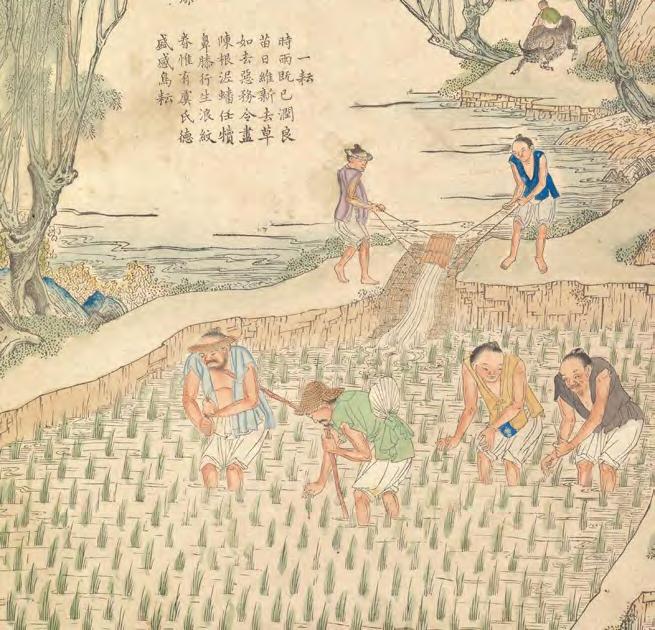
The Pantheon was built during the Roman Empire, one of the largest empires to ever exist. Originally a pagan temple, the Pantheon was converted into a Christian church.
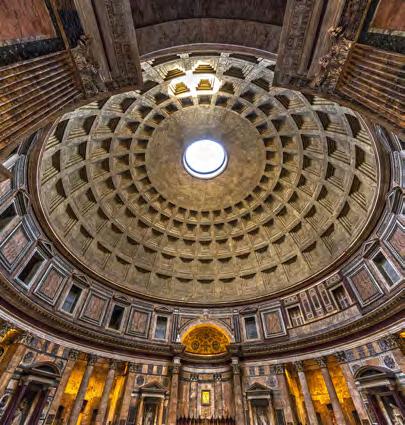















1000 b.c.e.–300 c.e.
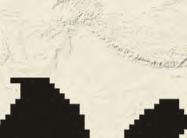
As the number of cities grew, a new and larger form of state developed: the empire. During this age of empires, the same patterns of change from the previous era continued—but at an accelerated rate. These complex new empires became much more efficient at controlling people’s lives and habits and gathering taxes.
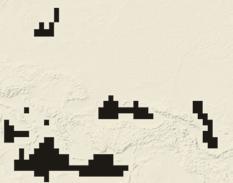
There were many large empires in the ancient world. In Mesopotamia, the Assyrian and Babylonian empires thrived. Persia was home to the Achaemenid, Parthian, and Sasanian empires. The Kushan Empire in Central Asia, the Maurya Empire in India, and the kingdom of Kush in the upper Nile River valley each made unique contributions to the ancient world and its people.
The largest empires were the Roman Empire and the Chinese Han Empire. At one point, the Romans controlled the entire Mediterranean Sea area and much of Europe. While they did not rule a large part of the Earth’s land, these two empires accounted for about half of the world’s people.
The goods and ideas that were created within all of these empires soon interacted. The Silk Road’s land and sea routes created a huge web of trade routes that connected empires across the Eastern Hemisphere. Similar routes existed in Mesoamerica and along South America’s Andean mountain range in the Western Hemisphere.
Along the Silk Road, merchants traveled long distances to get to their rural and urban destinations. The Silk Road allowed the trade of goods and ideas, which is how religions from across the globe were able to reach different peoples. Hinduism, Judaism, Buddhism, Christianity, Greek thought, and the philosophy of Confucianism were all spread along this route and changed based on the social orders within each society.
The land and sea routes of the Silk Road played a critical role in fostering cultural diffusion among various empires of the ancient world.



The creation of metal money also helped interactions among ancient peoples. After spreading throughout the ancient world around the 6th or 5th century b.c.e., metal money was used in Greece, Egypt, Persia, Phoenicia, Carthage, India, China, and Rome.
In the 300s c.e., the Romans were facing trouble. By 476, the Western Roman Empire collapsed and a number of small kingdoms took its place. At the same time, Christianity spread rapidly across Europe. The Eastern Roman Empire survived as the Byzantine Empire until 1453. For centuries, Western Europe would become locked in decline and struggle with itself and its neighbors.
Some of those neighbors included Arabs, who began to spread Islam from the Middle East across North Africa and into Spain in the 600s. It eventually arrived in Asia. The rise of Islam created some conflict with other religions. However, it also led to a golden age throughout the Islamic world. Later thinkers would use the discoveries uncovered or rediscovered by Islamic artists, scientists, and writers.
This carving at Dazu in China was created during the Song dynasty. It shows a remarkable combination of Buddhist, Confucian, and Daoist styles and figures.

The Aztecs created long-lasting works of art and had a thriving culture. This calendar stone was excavated in Mexico City.

Around the same time, other areas were also experiencing growth. The Tang and Song dynasties in China restored the Han style of government, engaged in trade, and made significant cultural developments. In Africa, the empires of Mali and Ghana developed trade and complex economies. Islam was adopted throughout West Africa, and Arabic became widely used in some areas.
As civilizations across the world continued to develop, Europe experienced its own renaissance in the 15th to 16th centuries. European thinkers made significant developments in science and art. Europeans then set out to shorten trade routes with China and India. Their desire to explore led to their encounters with Indigenous people of the Americas beginning in the 15th century.
Some Indigenous civilizations of North and South America had built cities with monuments and complex societies. Although they did not have highly developed writing systems, powerful groups like the Aztec and Inca built complex systems, cities, and advanced infrastructure to help their populations survive and grow.
However, many of these groups faced disease, starvation, war, and enslavement after Europeans arrived. The desire by European countries to build new colonies in these lands also resulted in Africans being enslaved and sent to the Americas.
In the 17th and 18th centuries, Europeans began developing new ideas about government, society, and science. This period is known as the Enlightenment, a time when thought and society became more secular, or non-religious.
The major changes that took place across the world from 300 to 1750 c.e. were not just isolated to each region. Over time, they spread to other places around the entire globe. This period was notable for how places exchanged ideas and goods through trade. However, it was also marked by the spread of devastating war and enslavement across continents. Along with the development of the Enlightenment, these events, ideas, and other ways of understanding the past continue to have an impact around the world today.
Six themes for analyzing world history are human-environment interaction, rise of civilizations, growth and changes in societies, development of political institutions and ideas, belief systems, and interconnectedness of societies.
Beginnings to 4000 b.c.e. Hominins adapted to their environments and created inventions that helped them survive. Modern humans evolved from a hominin group called Homo sapiens. After humans discovered how to farm, communities and civilizations began to emerge.
Kingdoms and Innovations: 4000 b.c.e.–1000 b.c.e. As cities grew, kings took power and taxed the kingdom’s people to pay for certain public works. During this time, many important inventions were created and writing was heavily improved.
An Age of Empires and Interactions: 1000 b.c.e.–300 c.e. A ll across the ancient world, power ful empires rose from cities. These empires interacted along a web of trade routes. Both goods and ideas were shared along the trade routes connecting these places.
A World of Changes: 300–1750 c.e. Though some areas declined, others grew at a more rapid pace. The expansion of trade, culture, science, and even violence spread across oceans and continents through the centuries.
The ancient Greeks built the Parthenon and dedicated it to their goddess Athena. The ancient Greeks are famous for their religion, government, and Olympic games.

Gather evidence by studying these sources—along with the other sources listed in the Unit Inquiry Project—as you prepare to write an argument answering the unit’s compelling question.
Knowing how to access, evaluate, and analyze materials available in your school’s library or media center is a key skill. Here are some ideas to help you navigate the resources that are available to you.

1. Carefully review the assignment and define your research topic. The important thing at the start of your research is to know exactly what you’re expected to do. In selecting topics, you may want to begin by browsing in general works like a textbook or encyclopedia. These sources will help you identify topics for which a lot of information is available.
2. Identify many possible sources. Spend some time browsing in the database or identifying books that might be helpful. Remember that you may find your topic in books about a broader subject. Using the internet will also help in your search. Bookmark the most promising sites to refer back to.
3. Identify the best sources. Once you’ve listed possible sources, select those that will best help with your research task. Use newer books and articles when possible. Generally, newer sources are more likely than older ones to reflect current research. Of course, this does not apply to primary sources.
4. Gather information from your sources. Once you have identified your sources, it is time to compile the information you need. Be sure to go back to the project requirements as you gather information. Think of these two questions: (1) Which pieces of information will help you complete the research task? (2) What is the best way to organize the information? Also write down bibliography information as you research. This will save time at the end of your project.
5. Create the product. Keep in mind who your audience is. Strive to create a product that meets the needs of the audience. Add visuals such as pictures, graphs, maps, timelines, and artifacts to add interest to your presentation.
6. Reflect on what you have done. When your project is complete, stop and reflect. What did you learn about researching a topic and presenting the results? What went well? How would you tackle the same task in the future? What would you do differently?
There are many kinds of sources you can use. A primary source is direct or firsthand evidence about an event, person, or object. Primary sources can be speeches, letters, artifacts, and more. A secondary source describes, analyzes, and discusses a primary source. Secondary sources can be in books, articles, or newspapers. A secondary source can also contain a primary source. For example, a book that talks about Lincoln’s speech is a secondary source. The book could also have a copy of Lincoln’s speech inside.
When citing a book in a bibliography, follow the order: author, title of book, city of publication, publisher’s name, year of publication.
Example: Arburn, Michael. Learning History: An Adventure. New York: Random House, 2022.
When citing an article in a bibliography, follow the order: author, article title, magazine or newspaper, date of publication, page numbers of the article.
Example: Adams, Steve. “Finding a Great Hotel in Paris.”
Travel Magazine, July 2023: 38–42.
The internet is an amazing research tool. However, it’s important to remember that anybody can create a website and post information on it. Some sites are reliable. Others are not. Here are some ideas on picking the best sites.
When evaluating websites, think about three questions:
1. Is the information from a reliable source?
• Ideally, you are looking for information from an expert source. An expert source is an authority on the subject you are researching.
• Websites that end in .gov are related to government bodies. The information found on these sites can be some of the most reliable on the internet.
• Websites that end in .edu are related to a school or college and can be very reliable, since they are often created by researchers or scholars. On the other hand, schools may allow or encourage all students to post information on a school-related website. Such material may or may not be accurate. Try to identify the qualifications of the author before you use the information.
2. Is the information biased?
• A source is biased if the author has a certain opinion or prejudice that he or she wants to promote. It is very important to develop the ability to detect bias.
• Social scientists call research that is free of bias “objective.” For most research projects, you will want to find objective information. If the author is careful to separate opinion from facts, your job is easier. Be on the lookout for opinions that are disguised as facts.
• Ask yourself what person or organization prepared the information. Why did they post it on the internet? What is their purpose? Are they trying to convince you of something?
3. Is the information accurate?
• To find this out, ask yourself these questions: Is the information repeated on other sites or in other sources you are using? Is the information based on recent research, or is it old and possibly outdated? Does the writer reveal where he or she got the information? (Those who do not reveal their sources may not want their sources checked. This can be a sign of bad scholarship.)
Have you ever put together a jigsaw puzzle? You start with a picture that shows what the completed puzzle will look like. Then you fit the pieces together until they make up that picture.
Suppose, though, that you didn’t have a picture to work with, but only the pieces? Even worse, what if most of the pieces were missing? How hard would the puzzle be then?
That’s the situation facing anthropologists who study early hominins. These social scientists are trying to understand how and when early hominins developed. The puzzle pieces they work with are bits of bone that are millions of years old. Anthropologists know that they have only some of the pieces. Each new find gives them another clue to work with.
Gradually, the overall shape of the picture becomes a bit clearer. For instance, scientists today agree that hominins first appeared in Africa. But only 60 years ago, even this much of the picture was unclear. It took many finds to discover that Africa was the birthplace of early hominins.
Each of these finds was the result of hard, patient work. Here you will learn about some other important pieces of the hominin puzzle—and the people who found them.
In 1924, an anthropologist named Raymond Dart examined an ancient skull that had been found in a quarry in Taung, South Africa. The skull belonged to a young, apelike creature. It became known as the Taung Child. Dart gave the fossil a more scientific name: Australopithecus africanus. This name is Latin for “southern ape from Africa.”
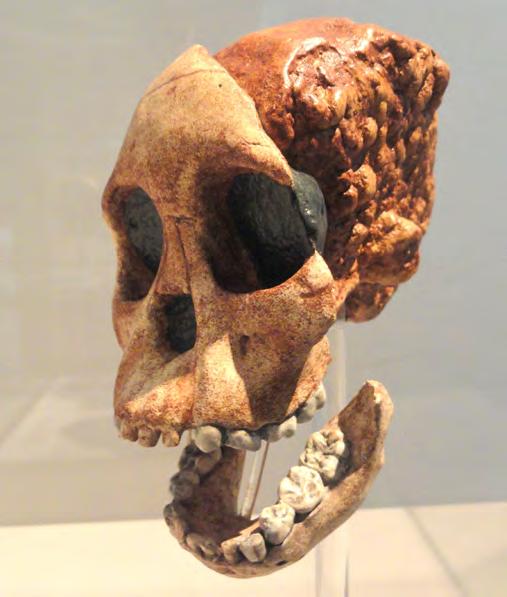
The Taung Child was the first Australopithecus fossil ever found. It is 2 to 3 million years old. Dart was thrilled by the discovery. He thought it showed that the earliest hominins appeared in Africa. Other scientists disagreed. At that time, many of them believed that hominins first appeared in Asia. Over the next 20 years, a Scottish anthropologist, Robert Broom, collected more and more Australopithecus fossils in Africa. By the 1940s, most scientists had to agree that Dart was right.
Far to the north, Mary Leakey found more puzzle pieces at Olduvai Gorge in modern-day Tanzania. Mary and her husband, Louis, had spent 30 years searching the gorge for hominin remains. In 1959, Mary found hundreds of bits of bone. When she pieced them together, they made up the skull of a previously unknown type of hominin. The fossil was nicknamed Nutcracker Man for its large jaw. Today it is called Australopithecus boisei. It is more than 1.7 million years old.
More evidence was found by Mary and Louis’s son, Richard Leakey. Richard found his first fossil when he was just six years old—a part of an extinct pig. As a young man, he began leading expeditions in East Africa.
Richard made many important finds, including skulls and other bones of Homo habilis and Homo erectus. In 1970, he found another Nutcracker Man fossil.
Richard’s most famous discovery came in 1984, near Lake Turkana in Kenya. Most hominin fossils are small parts of the body. The new find was a nearly complete Homo erectus skeleton. Known as the Turkana Boy, it is about 1.6 million years old.
Richard’s wife, Meave, has also hunted fossils in Africa. Among her finds are still more species of early hominins. Richard and Meave’s daughter, Louise, has worked with Meave on field expeditions, continuing the proud Leakey tradition.
Mary Leakey made many finds during her long career. The one that excited her the most was a truly fantastic discovery: hominin footprints that were more than 3.5 million years old!
This ancient skull is a reconstruction of Homo erectus, the Upright Man.
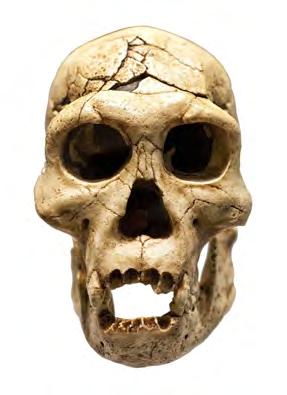
Mary’s team spotted the footprints in 1976 at Laetoli in Tanzania. This site is about 30 miles south of Olduvai Gorge. The footprints were found in a layer of volcanic ash. Scientists think that a volcano erupted shortly after the footprints were made. When the ash hardened, it preserved the footprints.
Besides being amazingly old, the footprints were important for another reason. The creatures that made them had walked upright on two feet. The footprints were even older than the famous fossil nicknamed Lucy. They showed that hominins were walking upright at a very early date.
Tim White, an American anthropologist, helped excavate the Laetoli footprints. He also worked with Donald Johanson, who found Lucy. White’s own teams have made a number of other finds. One of them pushed hominin history even farther back in time.
In 1994, White was working in Ethiopia. An African member of his team discovered hominin fossils that proved to be 4.4 million years old. The fossils had a very ancient combination of apelike and humanlike features. White and his co-workers called the new species Ardipithecus ramidus. The word ramid means “root” in the Afar language of Ethiopia. The researchers thought that the fossil was very close to the root of the hominin family tree.
These discoveries, and many more like them, are helping scientists to piece together the story of early hominins. Scientists often argue about exactly how the pieces fit together and what the big picture looks like. Meanwhile, they keep on looking. They know that there are many more pieces of the puzzle scattered around Africa, and other parts of the world, waiting to be found.
View these complete sources and answer the questions in these lessons online: Investigating the Past Through Inquiry (Explore) and Early Hominins (Explore).
Look for additional sources online labeled as Explore, Primary Source, Literature, and Biography throughout the lessons.
8000–3000 b.c.e.
Unit 1: Foundations of History


develop new skills and come up with more complex ways of finding and preparing food. Humanity discovers an important advancement with the development of agriculture during the Neolithic Age.
1750 b c e.–220
Unit 5: Ancient China
Early Chinese farmers settle the North China Plain. The growth of China and its dynasties lead to innovations in culture and technology. The Silk Road opens during the Han dynasty.

3500 b.c.e.–800 c.e.
Unit 2: The Rise of Civilization
Over thousands of years, humans establish settlements around the world, including in the Western Hemisphere. In the Mesopotamian and Persian regions, cultural innovations spread across empires.
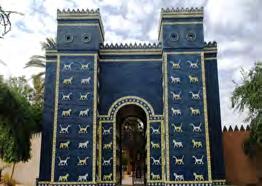
1000 b c e –323 b c e
Unit 6: Ancient Greece
Athens leads the development of democracy, highlighting the differences between it and other Greek city-states. Following a series of wars with ancient Persia and between the city-states, Alexander the Great unites Greece and creates an empire.
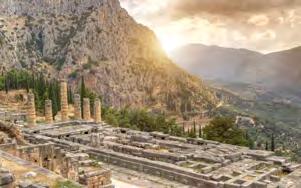
3100 b.c.e.–350 c.e.
Unit 3: Ancient Egypt and the Middle East Complex cultures and urban societies develop across Meso potamia, Egypt, and Kush. They flourish in the fertile environments of Africa and the Middle East.
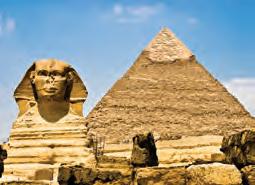
753 b c e.–476 c e
Unit 7: Ancient Rome
The Roman Republic rises from being a small city-state to an empire covering much of the Mediterranean coast. Rome experiences many changes resulting in citizen rebellions, large expansions of territory, the end of republican government, and the adoption of a new religion, Christianity.

Geography Challenge Watch a video to explore how geography affected the development of the first human civilizations. Then use the maps and reading to answer the Geography Challenge questions in your notebook.
Inquiry Project Explore the unit’s compelling question: How much are we able to know about the first human civilizations? Then complete a Structured Inquiry. Gather evidence throughout the activities, reading, and additional research to write an argument that answers the question by the end of the unit.
5 The Rise of Sumerian City-States Take on the role of ancient Mesopotamians facing a series of issues. Propose and debate solutions, and then find out how Mesopota mians actually responded.
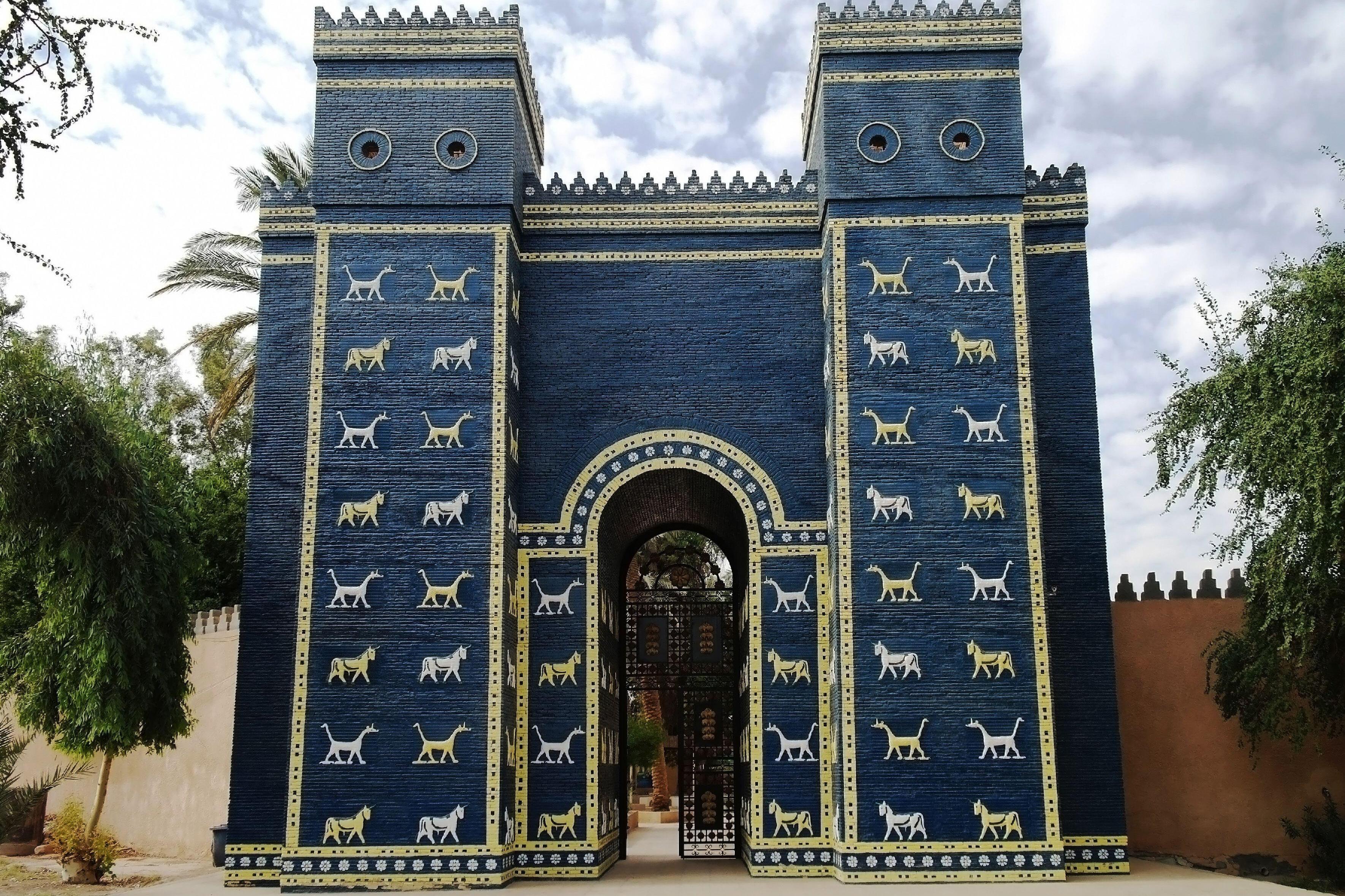
Exploring Biographies – Detecting the Past: Clues from Archaeology Key Skills: Sequencing Events, Analyzing Cause and Effect, Conducting a Cost-Benefit Analysis
6 Ancient Sumer Analyze artifacts to find evidence of the characteristics of civilization in ancient Sumer.
Investigating Primary Sources – How Did the Different Social Classes of Sumer Interact with One Another?
Key Skills: Framing Questions to Research, Selecting Useful Information, Selecting Credible Sources: Primary Sources
7 Exploring Four Empires of Mesopotamia Create "mechanical dioramas" that illustrate major achievements of the Akkadian, Babylonian, Assyrian, and Neo-Babylonian empires.
Key Skills: Comparing and Contrasting; Identifying Frame of Reference and Point of View; Recognizing the Role of Chance, Error, and Oversight in History
8 Ancient Persia and Its Context
Sort and analyze artifacts to draw conclusions about the history of ancient Persia.
Key Skills: Selecting Useful Information, Drawing Sound Conclusions, Sequencing Events
9 The Achievements of Ancient Persia Explore life in ancient Persia, such as trade, social structure, sports, and technology, and then analyze the legacy of the ancient Persians.
Key Skills: Making Predictions, Analyzing Cause and Effect, Identifying Frame of Reference and Point of View
10 Early Civilizations in the Americas
Trace the development of the first societies in the Western Hemisphere to discover their cultures and achievements.
Key Skills: Sequencing Events, Selecting Credible Sources: Primary Sources, Map Skills
Studying Sources Use these readings as further sources for your Inquiry Project and to deepen your understanding of the content:
• Literature – Enheduanna: The First Poet
• Primary Source – What is Justice? A View from the Code of Hammurabi

• Primary Source – Darius’s Right to Rule
Then look for additional sources online, including Explore, Primary Source, Literature, and Biography readings.
Timeline Challenge Review the key events from this unit by sequencing events on a timeline. Then add your own events that you consider to be important in history.
explain
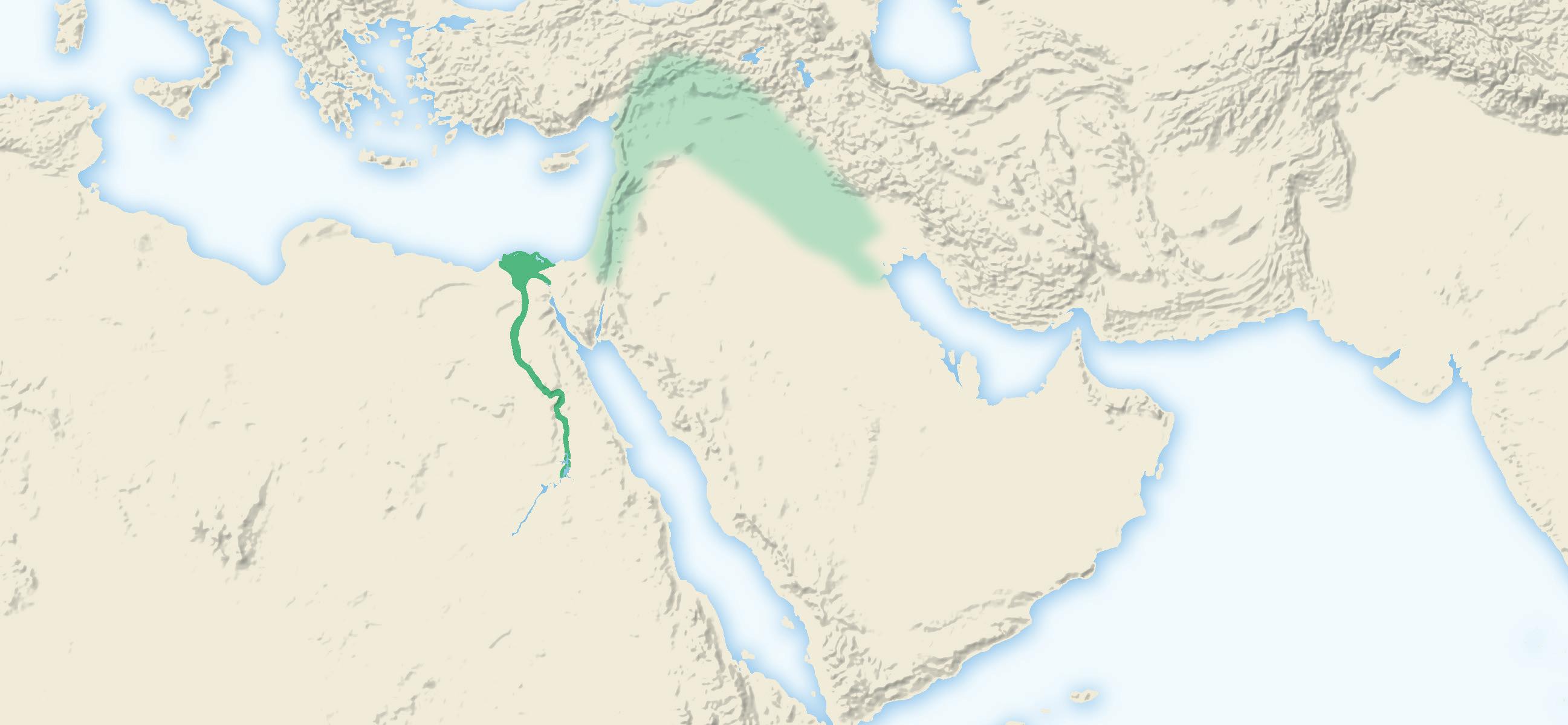

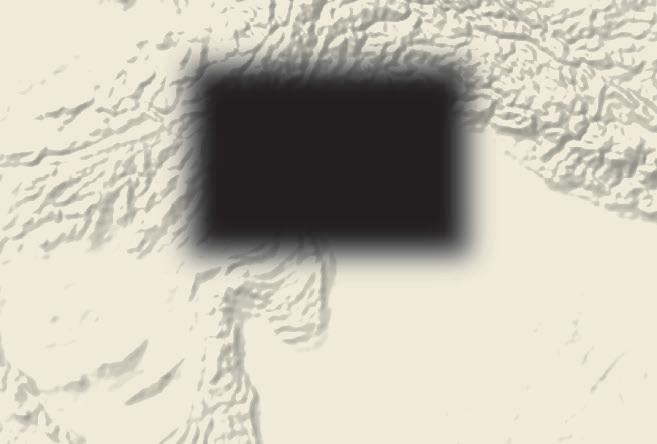






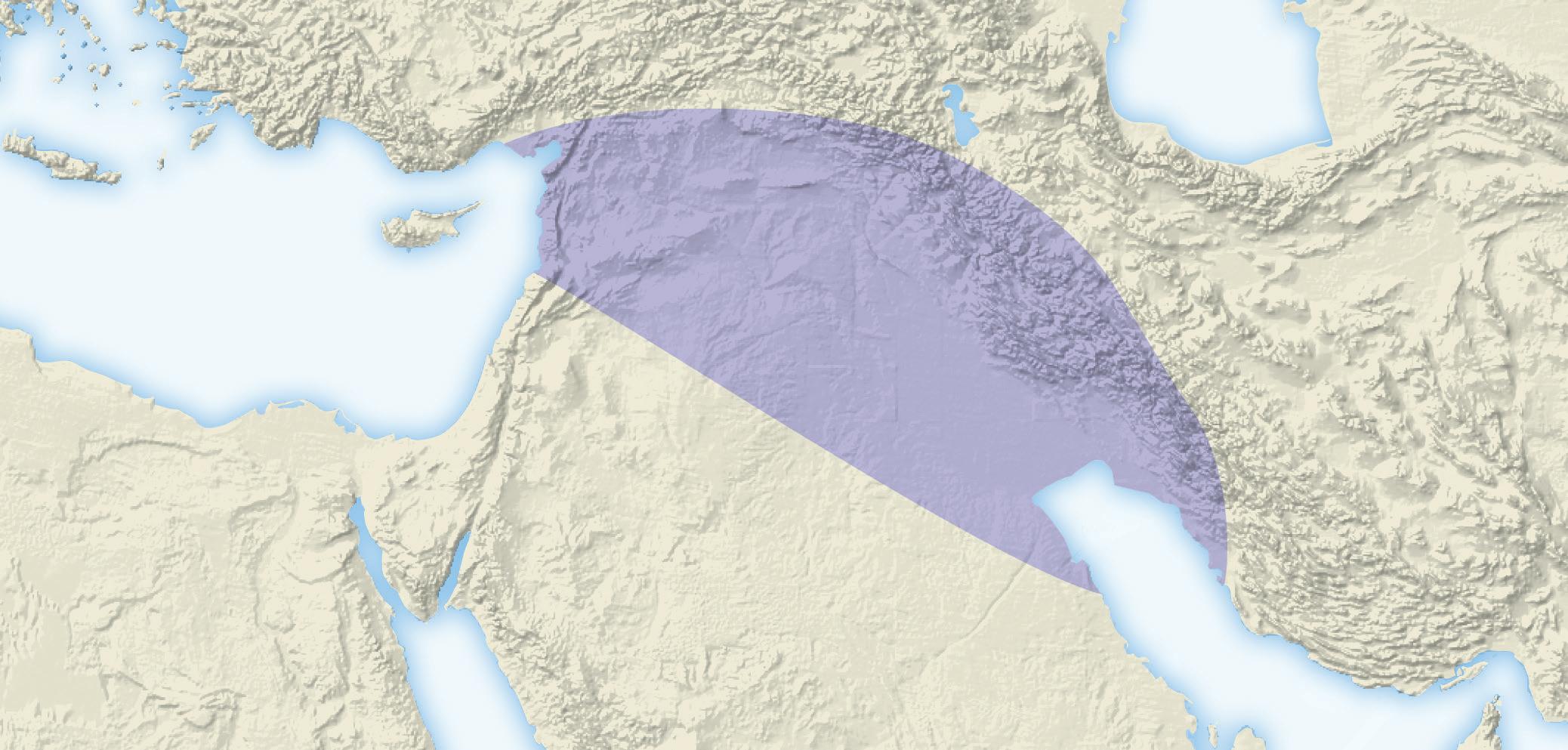

The first human civilizations developed in regions where people found the resources they needed to survive. One of these regions, in North Africa, is mostly desert. Through the desert flows the Nile River, which is the longest river in the world. The Nile had an enormous impact on the development of civilization. The Nile River begins in East Africa and flows north, emptying into the Mediterranean Sea. Along the way, the Nile picks up a lot of rich, dark soil. Each year, the river overflows its banks, flooding the land around it. Beginning in ancient times, the floodwaters left behind soil that was perfect for growing crops. This factor greatly influenced early human settlement in the Nile River valley.
Another region in which ancient people settled was in an area of land stretching from the Persian Gulf to the Mediterranean Sea. This region is known as the Fertile Crescent because of its rich (fertile) soil and its curved (crescent) shape when drawn on a map.
Ancient people living in the Fertile Crescent
were able to grow plenty of wheat and barley, eliminating the need to move constantly in search of food. Also, people could settle down and build communities. Permanent shelters and a dependable food supply allowed people to advance in important ways. They learned to make stone and metal tools; raise animals such as cows, sheep, and pigs; and develop a system of writing. Eventually, settlements began trading with nearby groups. An exchange of people, goods, and ideas blossomed as the first civilizations had begun.
Empires, large territories ruled by a single government, also began to form. You will learn about the Akkadian Empire—and many subsequent empires—that ruled lands around the Fertile Crescent.
During your study of ancient history, you’ll discover that people learned to farm in many different places around the world. Early civilizations grew and flourished throughout Africa, Asia, Europe, and the Americas.

Follow the steps below to complete a Structured Inquiry during this unit. Use the activities and disciplinary sources to build your knowledge and gather evidence. Then construct an argument that answers the compelling question.
Developing Questions
How much are we able to know about the first human civilizations?
Choose an item on or near you. What does the item say about you? How might someone living a thousand years in the future interpret this item?
Using Disciplinary Sources to Build Arguments
What are ways that we can learn about the past?
Lesson: The Rise of Sumerian City-States
Propose and debate solutions to a series of problems faced by ancient Mesopotamians. (Classroom Activity)
Source A: "Detecting the Past: Clues from Archaeology" (Reading - Exploring Biographies)
Analyze artifacts through the lens of an archaeologist living 500 years in the future. (NotebookExploring Biographies)
How do social scientists use artifacts to draw conclusions about ancient civilizations?
Lesson: Ancient Sumer
Analyze artifacts to find evidence of the characteristics of civilization in ancient Sumer. (Classroom Activity)
Source A: "How Did the Different Social Classes of Sumer Interact with One Another?" (Reading - Investigating Primary Sources )
Source B: "The Hero of Sumer: King Gilgamesh of Uruk" (Online Reading - Literature)
Write a paragraph explaining how artifacts help explain ways that social classes in ancient Sumer interacted with each other. (Notebook - Investigating Primary Sources)
What limitations do social scientists face when analyzing artifacts about ancient civilizations?
Lesson: Ancient Persia and Its Context
Play a game based on the experience of archaeologists studying ancient Persia. (Classroom Activity)
Source A: "Archaeological Dig and Administrative Records" (Handouts A–E)
Source B: "Ancient Persia and Its Context" (Reading - Sections 2–3)
Source C: "Darius’s Right to Rule" (Online Reading - Primary Source)
Fill in a table analyzing the various ways we can know about ancient Persia and the strengths and limitations of each one. (Notebook - Processing)
Construct an argument with evidence that addresses the compelling question: How much are we able to know about the first human civilizations?
Extension Find or draw contemporary artifacts as evidence of civilization today. Describe to what extent future historians might be able to draw conclusions about our civilization today based on these artifacts. What limitations might they face?
Research a place today where human or natural causes are threatening artifacts.
Brainstorm solutions for how artifacts in this location could be saved.
Create an ad (video, audio, or poster) that explains the need to protect artifacts (locally or globally).
Inquiry Project Go online to complete the activities, readings, and tasks. Fill out the corresponding prompts for each step in your print or online notebook.
Classroom Activity
and
the role of
Mesopotamians
then
Video Activity
a series
out how Mesopotamians
more about the rise of city-states in ancient Mesopotamia

a video covering the main ideas of
an online
Reading and Notes
print notebook
lesson and reveal what you’ve learned by
you complete the reading,
make sense of the content.
to questions in your online
Early people who lived in the Fertile Crescent began farming and living in small villages. But over time, small Neolithic villages grew into large, complex cities.
These villages were located in a land of rolling hills and low plains called Mesopotamia (meh-suh-puh-TAY-mee-uh), in modern-day Iraq. Mesopotamia is a Greek word that means the “land between the rivers.” The two main rivers of the Fertile Crescent are the Tigris (TIE-gruhs) River and the Euphrates (yuh-FRAY-teez) River.
Cities first appeared in the southern region of this land with the earliest dating back to about 3500 b.c.e. These were similar to small, independent countries. Each had their own ruler, as well as their own farmland to provide food. Suppose that you were visiting one of these early cities. You would see a walled settlement surrounded by farmland used to supply food for the city, as well as strong city walls constructed with sunbaked bricks. Moats, or ditches filled with water, would surround these walls and help keep out enemies. During an attack, people living outside the city walls would flee inside for protection.
As you gazed at the city, you might wonder how it came to be built. Why didn’t people in Mesopotamia go on living in small villages, as their ancestors had done for thousands of years? Why did large city-states thrive in the “land between the rivers”? In this lesson, you’ll learn the answers to these questions.
These ruins in the Syrian Desert reveal an ancient Sumerian walled city. The walls kept enemies out of the city-state contained within.
Euphrates River irrigation levee
Mesopotamia silt Sumer
Tigris River
Mesopotamia in ancient times, the geographic area located between the Tigris and Euphrates rivers

Tigris River one of the two largest rivers in Southwest Asia that flow from the mountains in Turkey to the Persian Gulf
Euphrates River one of the two largest rivers in Southwest Asia that flow from the mountains in Turkey to the Persian Gulf
It was not easy to live in the part of the Fertile Crescent called Mesopotamia. The northern part was hilly and received rain. The southern part had low plains, or flat land. The sun beat down fiercely on the plains between the Tigris River and the Euphrates River. There was little rain. The people here were farmers, and their farms needed water. The rivers overflowed onto the plains during flood season, but for most of the year the soil was hard and dry because of the arid climate.
On the plains, building materials were difficult to find. There were plenty of reeds, which are weeds that grow near rivers. But there were few trees to provide wood, and even stones were scarce. And there were few natural barriers to keep out enemies.
Mesopotamians faced four major problems as they attempted to survive in this environment:
• food shortages in the hills
• an uncontrolled water supply on the plains

• difficulties in building and maintaining systems that provided water across village boundaries
Both geographic features and the climate affected where people settled in Mesopotamia. People generally tried to live in the most fertile and safest areas possible.
• attacks by neighboring communities
Over time, they found solutions to these four problems. Let’s explore how their solutions led to the building of some of the world’s first cities.
In Neolithic times, people in some areas of the world began farming. One of the areas that had good conditions for growing crops was the rolling foothills of the Zagros (ZAH-grihs) Mountains in northern Mesopotamia.
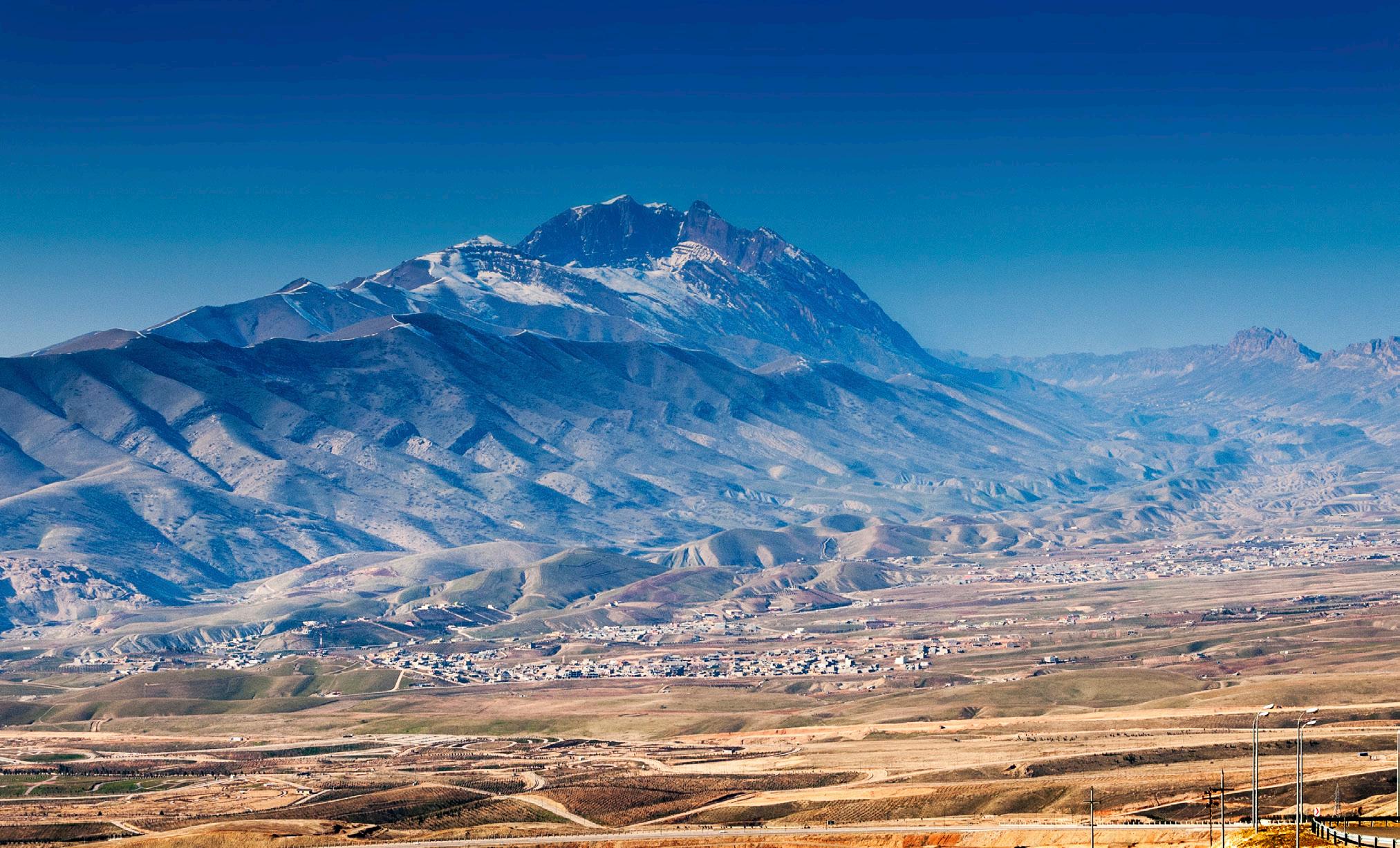
Mild weather and plentiful rains made the foothills a good place to farm. The nearby wooded hills provided timber for building shelters, and plenty of stones for toolmaking. Over several thousand years, these good conditions allowed the number of people in Mesopotamia to grow dramatically.
Then problems arose. Some historians think that by 5000 b.c.e., farmers in the Zagros foothills did not have enough land to grow food for the increasing population. As a result, villages began to suffer from food shortages.
Below the foothills and to the south, the Euphrates and Tigris rivers ran through flat plains. The plains covered a large area of land, and few people lived there. During most of the year, the land was very hard and dry. The plains lacked trees and stones for making shelters and tools.
Yet, they still held promise. In the spring, both of the rivers flooded, bringing precious water and fertile soil to the land. Perhaps farms could be successful there.
Driven by the need to grow food, people moved out of the foothills and onto the plains. This region became known as Sumer (SOO-mer), and its people, the Sumerians.
The Zagros foothills below the mountains were an ideal place to farm. Many people still live in this fertile area today.
Sumer an area in southern Mesopotamia where cities first appeared
The Euphrates is the longest river in Southwest Asia. It flows southeast across present-day Syria and Iraq.
The farmers who moved to Sumer faced many challenges. One of the biggest problems was the uncontrolled water supply.
During the spring, rain and melted snow from the mountains flowed into the Tigris and Euphrates rivers, causing them to flood across the plains. Unfortunately, no one could be sure exactly when the floods would come. If it happened after farmers planted their crops, the young seedlings would be washed away.
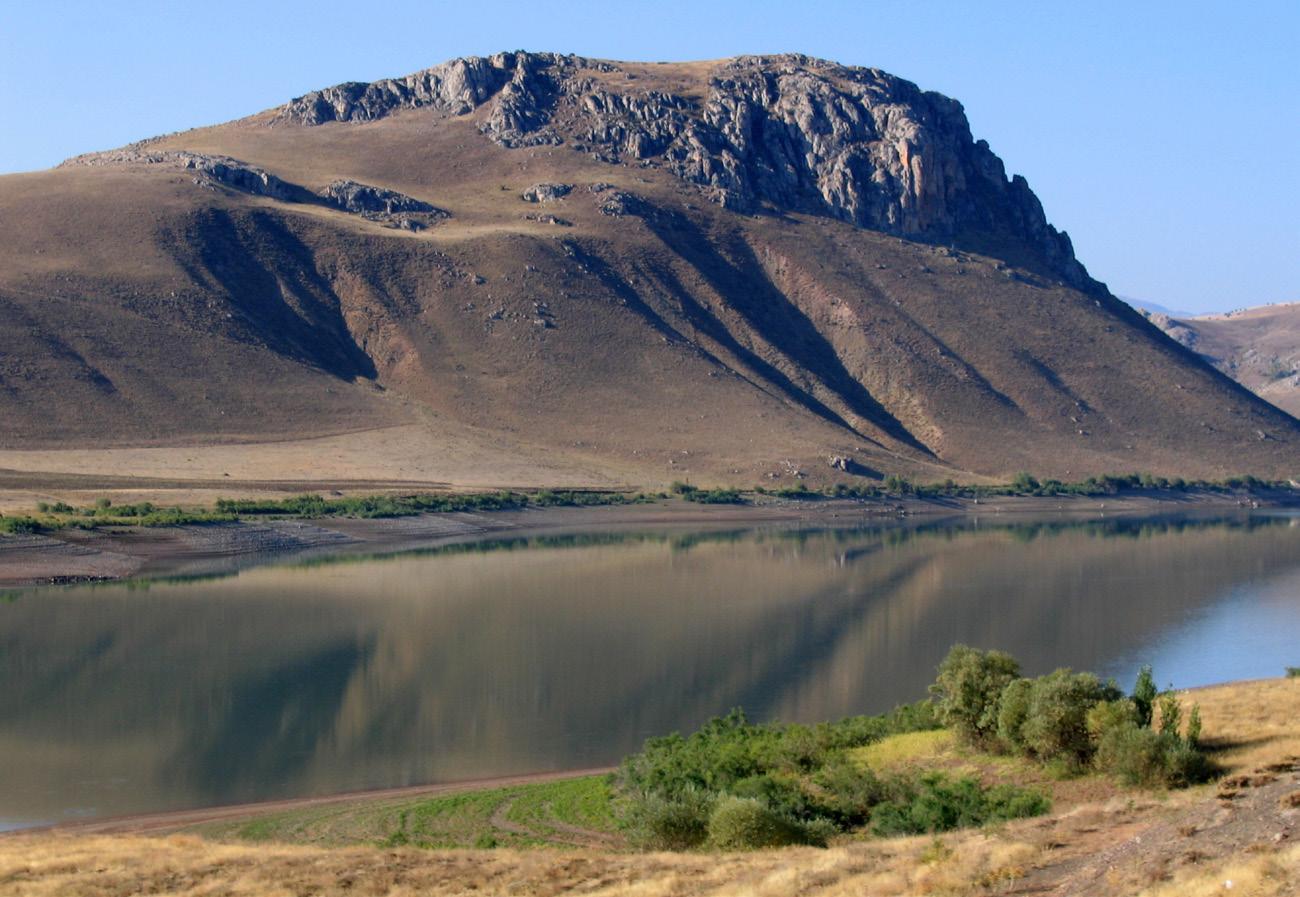
For much of the rest of the year, Sumer’s sunbaked soil was dry and hard as stone. Hot, strong winds blew thick layers of dust across the ground.
Faced with such dramatic seasonal changes, farmers were constantly struggling to raise crops with either too little or too much water. In order to grow food, they needed a way to control the water so they would have a reliable water supply throughout the entire year.
irrigation a means of supplying land with water levee a wall of earth built to prevent a river from flooding its banks
Therefore, Sumerian farmers began creating irrigation systems for their fields. They built levees along the sides of the river to prevent flooding. When the land was dry, the farmers poked holes in the levees, allowing the water to flow through the holes and into the thirsty fields.
Over time, the Sumerians learned other ways to control the supply of water. They dug canals to shape the paths the water flowed. They also constructed dams along the river to block the water and force it to collect in pools they had built so that they could store the water for later use.
Irrigation systems provided enough water for Sumerian farmers to grow plenty of food. But a new problem arose: how to maintain the irrigation system across village boundaries.
The irrigation system passed through a number of villages as it carried water from the river to the fields. The system needed constant care and repair. Canals became clogged with silt, so farmers had to clean them regularly. One clogged canal could disrupt the entire system.
Because villages were connected for miles around by these canals, farmers could no longer live apart, or in small groups. They had to work together for the common good.
Gradually, villages came to depend on one another to build and maintain this complex irrigation system. People who lived in different villages may have worked together to clear the silt from the canals to keep them open. Workers may have scooped water from one reservoir into another to ensure that water levels were balanced. As the Sumerians worked together, they began to create larger communities. Between 3500 and 3000 b.c.e., villages grew into towns. Some towns in Sumer then became cities with populations as large as several thousand people.
silt fine particles of rock
The Euphrates River still irrigates fields today by bringing water into crop fields. Sumer irrigation systems required constant repair.

A stele (STEE-lee) is an upright slab of stone inscribed with letters and pictures to depict important events. This particular stele shows a warrior on horseback riding into battle.
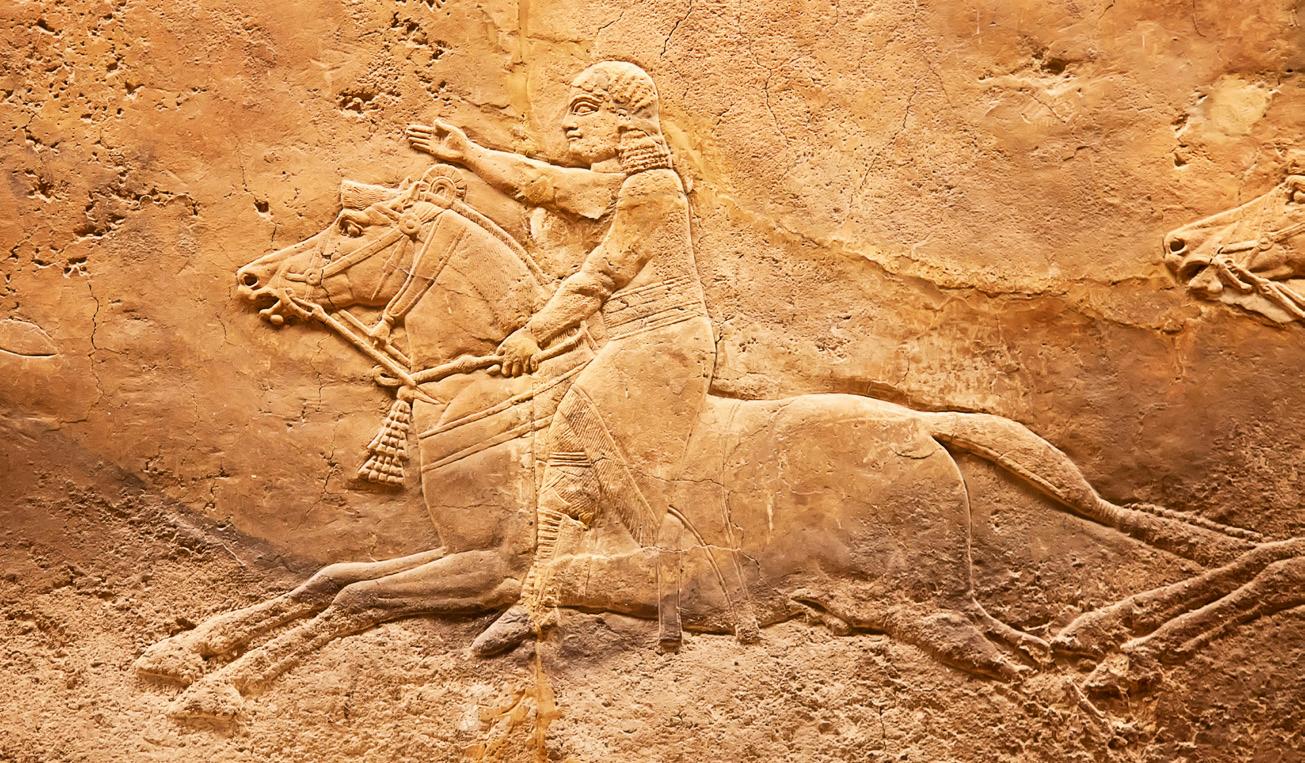
city-state an early city
was like a small, independent country
own laws and
As Sumerian cities grew, they fought over the right to use more water. Sometimes, people in cities located upriver (closer to where the river begins), built new canals, or blocked other cities’ canals. In this way, they kept water from reaching the cities that were downriver (farther from where the river begins). Disputes over water became so intense that they often led to bloodshed.
The Sumerians looked for ways to protect their cities from neighboring communities. The plains provided no natural barriers. There were no mountain ranges or rushing rivers to keep out enemies. Around the cities, the Sumerians began constructing strong walls out of mud bricks that were baked in the sun until hard. The Sumerians also dug moats outside city walls to help prevent enemies from entering their cities. Most people lived in houses within the walled cities, but the farms lay outside. In case of attack, farmers fled the fields for safety within the city walls.
The walled cities of Sumer were like independent countries. Historians call them city-states. By about 3000 b.c.e., most Sumerians lived in city-states, enjoying the benefits of a pro tected and governed independent area.
As you’ve seen, beginning around 3500 b.c.e., the Sumerians progressed from living in small farming villages to building large, walled city-states. How and why did this happen? The answer lies not only in the problems the Sumerians faced, but also in their solutions. A basic challenge for any group of people is how to provide food for itself. Food shortages had forced settlers in Mesopotamia to move from the foothills down to the river valley. There farmers faced the problem of having either too much water or too little.
To control the water supply, Sumerians built a complex irrigation system. The system crossed village boundaries, so the Sumerians had to cooperate with one another. This led them to live in larger communities—the first city-states. These independent city-states often fought with one another. To defend themselves, the Sumerians built walls and dug moats around their cities. By 3000 b.c.e., the solutions to the challenges faced by the Sumerians had transformed Sumerian farming villages into walled city-states.
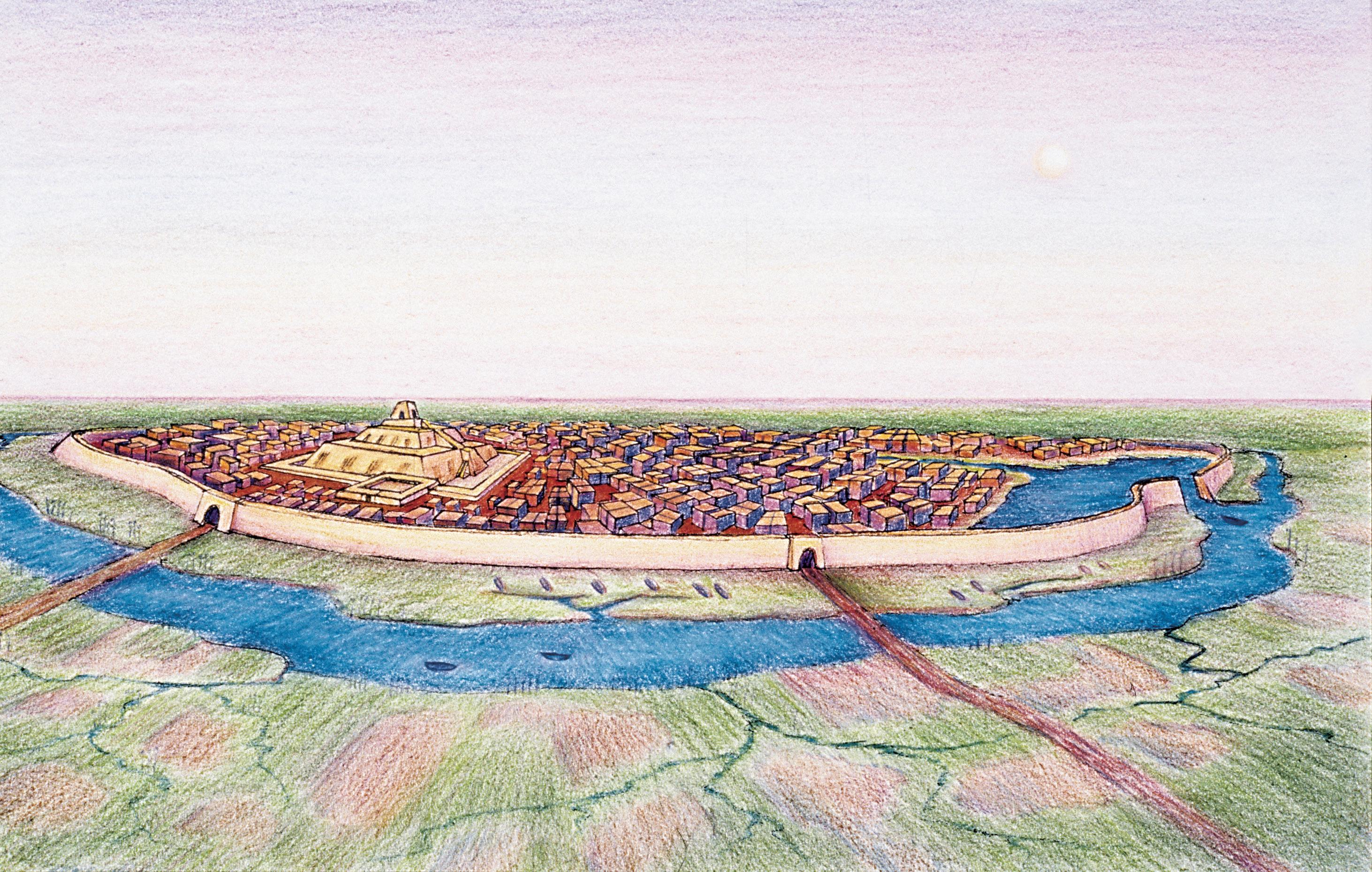
A Sumerian city-state was like a tiny country. Its surrounding walls helped protect against enemies.
In this lesson, you have learned how geographic challenges led to the rise of citystates in Mesopotamia.
Food Shortages in the Hills A shortage of food forced people to move from the foothills of the Zagros Mountains to the plains between the Tigris and Euphrates rivers. This plains area became Sumer.
Controlling the Water Supply on the Plains Farmers in Sumer faced times of flooding and drought. They built irrigation systems to create a steady water supply. Maintaining these complex systems required cooperation among villages.
From Farming Villages to City-States As villages grew into towns and cities, some became large city-states with protective walls around them.
British archaeologist Sir Charles Leonard Woolley worked like a real-life detective to reveal the secrets of the ancient city of Ur. His team uncovered the Royal Tombs of Ur.
Suppose that you are standing in the desert, southwest of the present-day city of Baghdad in Iraq. In the distance to the east, you see the Euphrates River. To the west are miles of desert. You then notice that scattered on the ground are small mounds of dirt. What could have made these mounds?
Sir Charles Leonard Woolley asked that same question in 1922 when he began excavating the ancient city of Ur in Mesopo tamia. Woolley was a British archaeologist who had been trained to work much like a detective, as evidenced in his excavations and discoveries in Mesopotamia between 1922 and 1934.

For an archaeologist working in the early 1900s, Woolley’s approach was unusually careful and scientific. Many archaeolo gists at the time viewed research as an adventure, not as a precise science. They often dug up sites to search for treasure, more so than to gain knowledge. They made little effort to preserve the sites or to prevent them from being damaged. Without permission, they often handed over artifacts to museums and private collectors in exchange for fame and money.
Woolley, on the other hand, wrote that his goal was “to get history, not to fill museum cases, . . . and [that] history could not be got unless both we and our men were duly trained.” Therefore, he excavated using a basic plan. In this way, he pre served each clue that might help him understand life at Ur.
By the time he arrived at Ur, Woolley had already studied what others before him had found there. He knew where an ancient temple had once stood, who had built it, and when the construction had begun and ended. But, most important, Woolley knew that the city in which the temple had stood was called Ur, and its people, the Sumerians.
In general, archaeologists work in three stages. Woolley had just completed the first stage—Learn and Plan. He was now ready to begin the second stage—Dig and Discover. “The first thing that I did,” he wrote in 1922, “was to dig trial trenches . . . [to] give us some idea of the layout of the city.”
Woolley’s team included his wife Katharine, who was also an archeologist, and they dug deep trenches to discover how many generations of people had lived at Ur. The team examined each stratum, or layer of earth, from the top to the bottom of the trench. When they went down into the first trench, they found mud-brick buildings at the shallowest, or most recent, layer. Meticulously, they uncovered layer after layer, moving back in time. At one point, the remains of the brick buildings disappeared. Next, they found reed huts.
Excited by these early discoveries, the team continued to dig in and around Ur. Every object was considered important. As the team uncovered each layer of a trench, some workers sifted the dirt while others kept records of where objects were found. These artifacts were labeled and packed carefully in boxes.
During the first four seasons, team members reached the bottom of the ziggurat, or temple area. They also explored other places. Slowly, one discovery at a time, a picture of Sumerian farming life came together. The evidence showed that the Sume rians used stone hoes to farm grain. They used grinding stones to grind the grain into flour, which they used to make bread.
In addition to these discoveries, the team found plaster made with cow dung, which the Sumerians used to build their houses. Also found was a statue of a pig, indicating to the team that the Sumerians had other farm animals.
The ziggurat, or temple area, of Ur rises from the ruins of the ancient city. Woolley carried out excavations of Ur from 1922 to 1934.
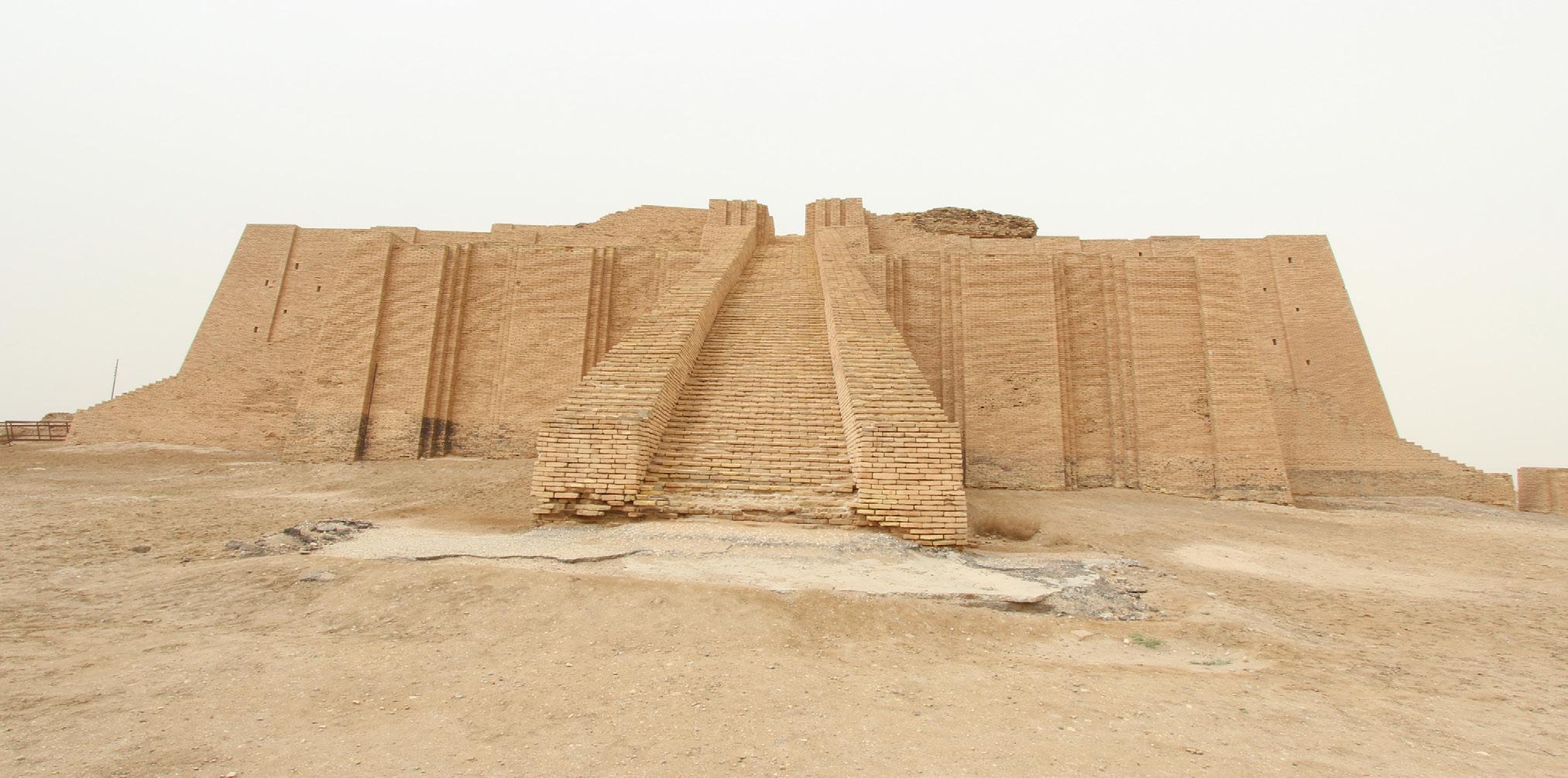
Woolley discovered many artifacts during his excavations in Ur, including this dagger. By analyzing the items, Woolley and his team could make unexpected conclusions about these ancient people.
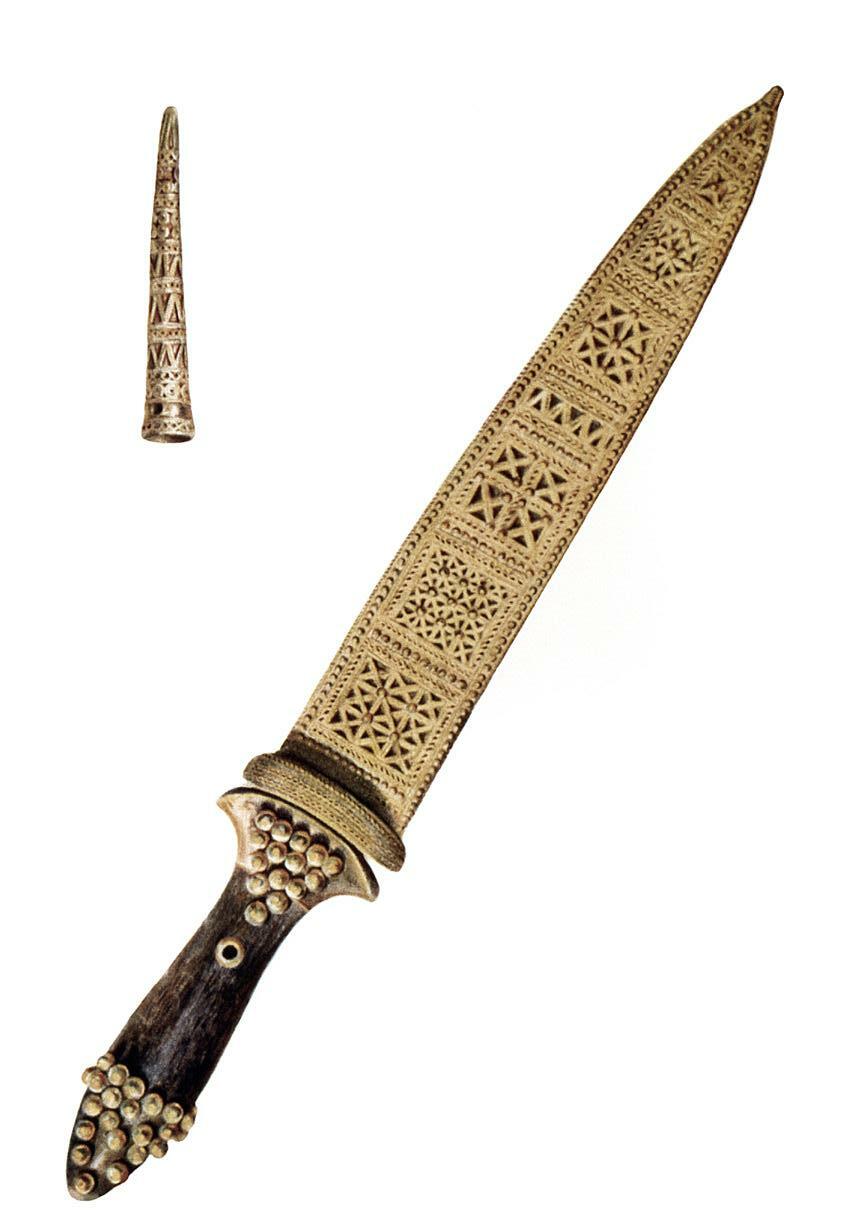
The team of workers uncovered fish bones and the sinkers that were used to drop fishing nets to the river bottom. They discovered a clay model of a boat, similar to one that Iraqis were still using in Woolley’s time. This indicated that the Sumerians ate fish and made nets to catch them. Finally, the team found parts of a weaving loom, showing that the people of Ur knew how to make cloth.
In their fifth season, Woolley and his team excavated their most famous discovery—a graveyard. They uncovered more than 1,850 burial sites, most of which dated from about 2600 to 2500 b.c.e. The burial techniques were simple: bodies were wrapped in reed mats or put in clay coffins in small pits. This discovery made headlines all over the world since it was the first time that so many artifacts, including jewelry and weapons, had been found in Mesopotamia.
But the most exciting discovery for the team was yet to come. Woolley and his team uncovered graves containing great riches—the Royal Tombs of Ur. These tombs sometimes had numerous rooms and enclosed many bodies surrounded by valuable objects. What Woolley found here would lead him to ask intriguing questions and find startling answers.
What did the tombs reveal? Woolley was able to identify the bodies buried in two of the graves, because of nearby writing found on clay cylinder seals: “Mesdalamdug lugal,” or king, and “Puabi nin,” or queen. These burials had been elaborate. The bodies were discovered in rooms in deep holes. The chambers were built of stone and had domed ceilings. The remains of jewelry, musical instruments, chariots, games, tools and weap ons, cups, and jugs led the archaeologists to reach an interesting conclusion: the Sumerians must have believed in an afterlife. These were objects the deceased would need in the afterlife.
The team also uncovered ramps leading down into the tombs. All along the ramps and around the tomb were many other bodies. Woolley wondered why all these bodies were there. They were lined up as if the people had all gone to sleep. There were broken cups by their sides. He reached a surprising conclusion. It was likely that these people had deliberately taken poison, expecting to go with their king or queen into the next life.
Back home, Woolley and the team would complete the final stage of their work—Preserve, Reconstruct, and Interpret. They had already packed and shipped artifacts back to museums where scientists would study, and preserve or reconstruct them, if necessary. Their work was important, though artifacts taken from the site are still placed in museums outside of Iraq. This remains an issue of controversy.
Woolley wondered what exactly expensive jewelry from 4,500 years ago would look like. One such puzzle was Queen Puabi’s headdress and jewelry. When the items were uncovered, they were lying on the ground in pieces. They were made of gold, with lapis lazuli and carnelian beads as decoration.
The final step in an expedition is figuring out how to fit all the clues together. Woolley finished his work at Ur in 1934. For the rest of his life, he wrote about what he had learned and discovered at the site.
Woolley learned that the Sumerians were farmers and fishermen. They dug canals and irrigated their fields. They raised animals. They ground grain to make bread. They made cloth. They even took time to make statues of animals. They lived in plastered reed huts and, later, in mud-brick buildings.
In addition, Woolley discovered clues that suggested the Sumerians believed in an afterlife and were willing to die for their king or queen. They used a writing system, called cuneiform, to identify kings, conduct business, and describe Sumerian life. They also created works of art as well as music.
Sir Charles Leonard Woolley set the stage for careful and scientific theories about Mesopotamia that later archaeologists would further investigate and contribute to. In the 1960s and 1970s, the Iraqi government used Woolley’s research to partially restore the Ur ziggurat.
Though these efforts have helped our understanding of history, some have said that digging up ancient tombs and taking artifacts is not fair to those buried. Local people and their culture may have beliefs against doing so as well. Although archaeology has greatly improved, past archaeologists severely damaged sites and artifacts.
Greater care and understanding has become important.
Woolley’s most important find was the grave of Queen Puabi. His team discovered the gold headdress she was wearing. Shown here, the headdress was pieced back together by archaeologists.

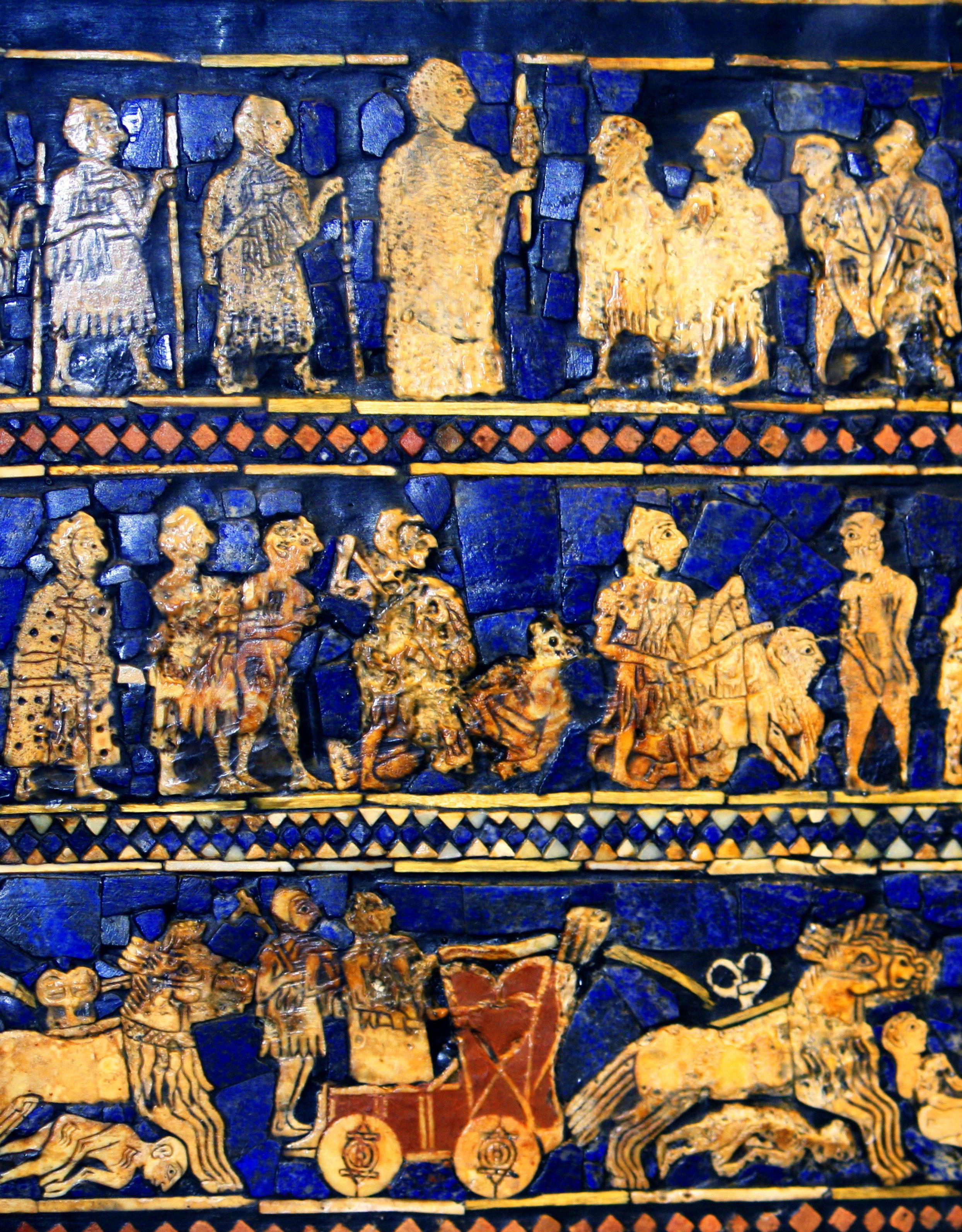
The rise of Sumerian city-states began around 3500 b.c.e.
Taking a closer look at life in Sumer will help you act like an archaeologist. You’ll consider evidence to try to answer this question about the distant past: Why do historians classify ancient Sumer as a civilization? A civilization is a society that has developed arts, sciences, and organization.
Until about 170 years ago, archaeologists had no idea that the Sumerian people had lived at all. Then, in the mid-19th century, archaeologists began finding artifacts in the area of the Fertile Crescent called Mesopotamia, uncovering tablets, pottery, and the ruins of cities. They were surprised to find writing in a language they had never seen before.
By studying artifacts, archaeologists have been able to learn a lot about Sumer. One artifact is the Standard of Ur (uhr), found where the ancient city of Ur once stood. The artifact is made of wood and decorated with pieces of shell and lapis lazuli, a semiprecious blue stone from what is now Afghanistan. It shows the Sumerians in times of peace and war. Ancient objects like this one can reveal a great deal about daily life in ancient Sumer.
Historians now know that the Sumerians had a complex society. Some of the things they developed, like the plow and writing, are still in use today. But which characteristics of Sumer society cause historians to classify it as a civilization? Let’s take a closer look at ancient Sumer.
The Standard of Ur depicts scenes of war and peace in ancient Sumer.
Vocabulary artisan civilization culture cuneiform merchant pictograph scribe social structure technology ziggurat
civilization a society marked by developed arts, sciences, government, and social structure
social structure the way a civilization is organized technology the use of tools and other inventions for practical purposes
Sumer was a challenging place to live because it had hot summers, little rain, and rivers that flooded the plains in the spring. Building complex irrigation systems and large cities allowed the Sumerians to overcome these challenges. By 3000 b.c.e., most Sumerians lived in powerful city-states like Ur, Lagash (LAY-gash), and Uruk (UH-ruhk). But what did the Sumerians do to create a civilization?
To answer this question, we need to examine what civilization means. What characteristics are common to a civilization? Historians name several such characteristics, including these:
• a stable food supply, to ensure that the people of a society have the food they need to survive
• a social structure with different social levels and jobs
• a system of government, to ensure that life in the society is orderly
• a religious system, which involves both a set of beliefs and forms of worship
• a highly developed way of life that includes the arts, such as painting, architecture, music, and literature
• advances in technology
• a highly developed written language
Sometimes, one or more of these characteristics are not found. For example, some ancient civilizations did not have highly developed writing systems or organized religion. Did Sumer have these characteristics? Let’s find out what the evidence can show.
Which characteristics of a civilization does this artifact represent? How do we use objects like this one in modern society?
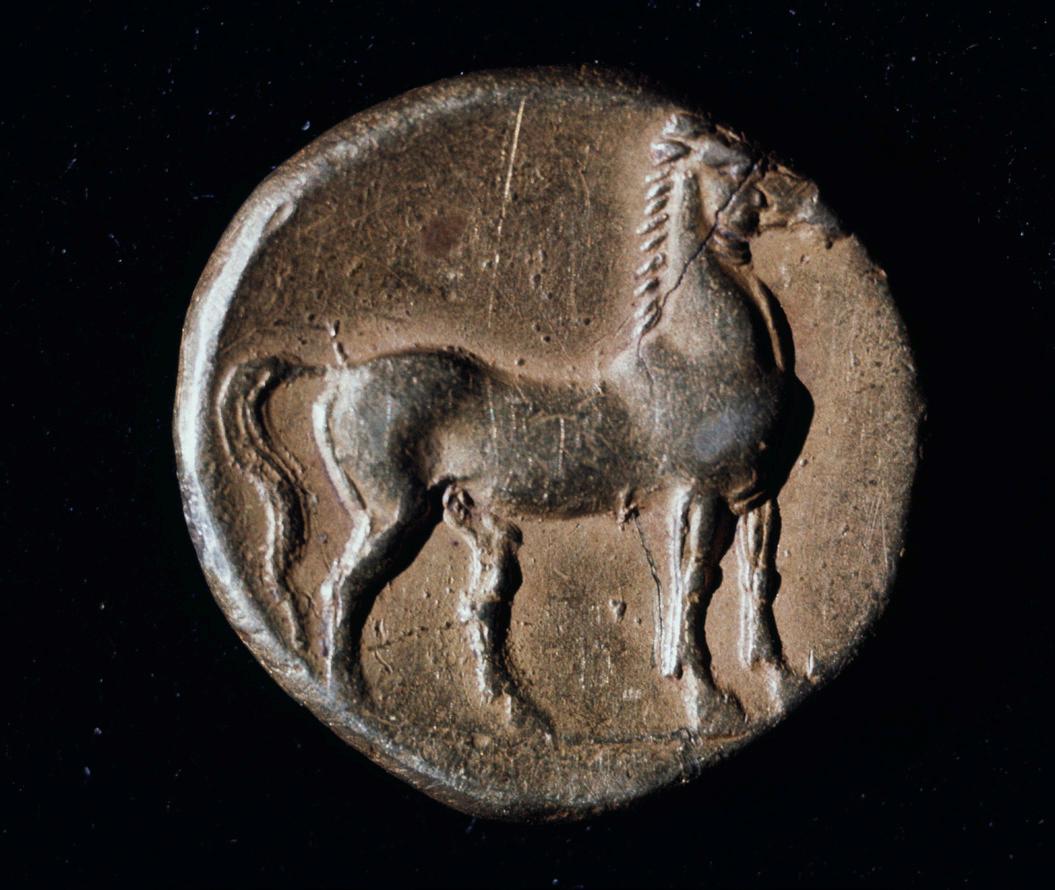
Civilizations need a stable food supply, because a complex society can only thrive if its members have the food they need to survive. The Sumerians invented two key adaptations to help them create a stable food supply.
One of these inventions was their complex irrigation systems. The Sumerians built networks of canals, dams, and reservoirs to provide their crops with a regular water supply.
Their second invention was the plow, which is a tool used for tilling, or turning, soil to prepare it for planting. Prior to the plow’s invention, farmers used animal horns or pointed sticks to poke holes in the earth, where they would plant seeds. This was a very time-consuming process, and farmers needed a faster way to prepare the land for planting.
The Sumerians made the first plow out of wood. One end of the plow was bent for cutting into the ground to turn the soil. Farmers themselves either pushed and pulled the plow along the ground or used animals such as oxen to pull it.
The Sumerians invented the plow. Today, some people still use plows to farm the land.

This man and child are standing in the ruins of the ancient city of Uruk, located in present-day Iraq. Uruk was one of many powerful Sumerian city-states.
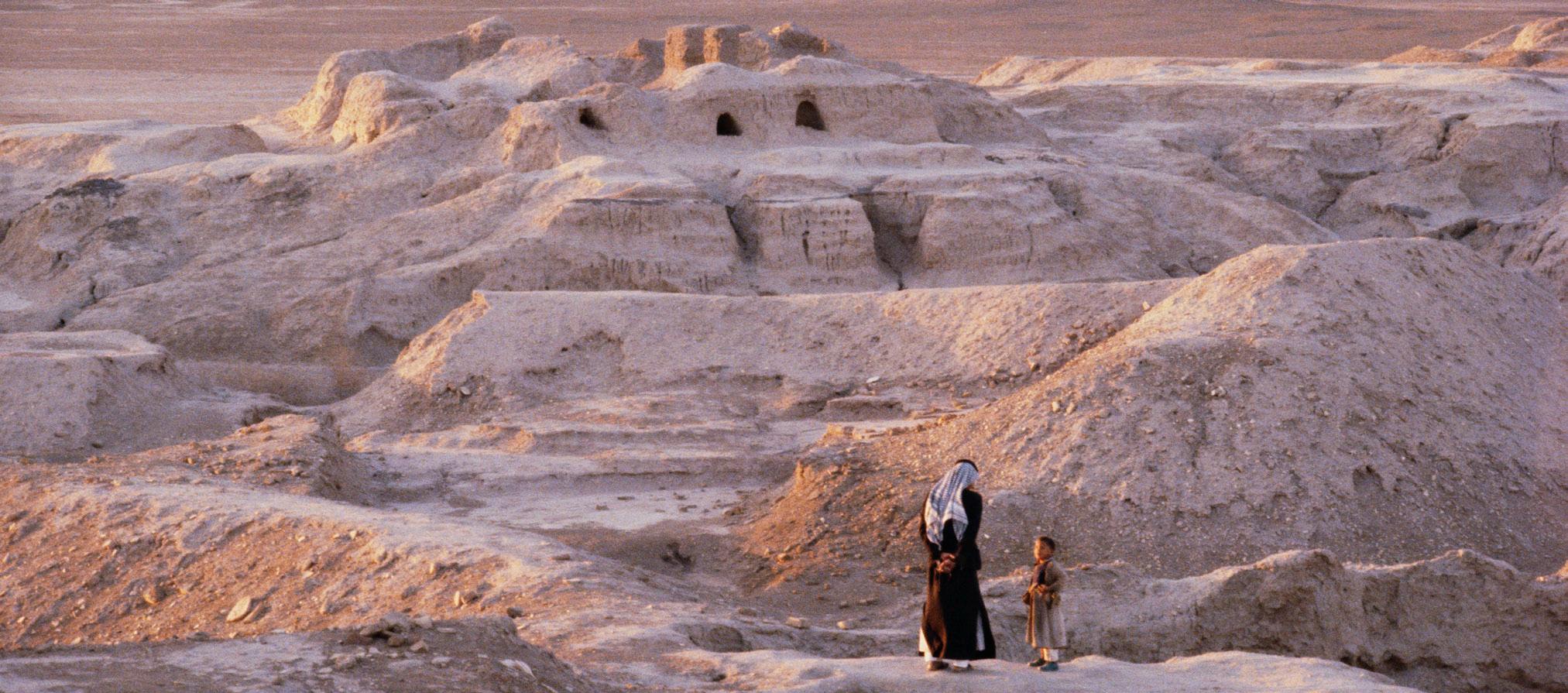
Civilizations usually have a complex organization, or social structure, including different jobs and social levels. People at higher levels have greater status than others.
Archaeologists have found evidence suggesting that several classes of people lived in Sumer. At the highest level were priests, kings, nobles, and government officials. These top members of society had the largest and most luxurious homes near the center of the city. Evidence suggests that these mud houses had whitewashed walls and were typically two stories high.
merchant a person who makes money by selling goods
artisan a craftsperson
At the middle level were merchants and artisans. Among the artisans were skilled metalworkers, who used metals like gold, silver, tin, lead, copper, and bronze. Since Mesopotamian land had few minerals, Sumerians imported these materials from Anatolia (modern-day Turkey) and the Elamites on the Iranian plateau. Out of these materials, they could create swords and arrowheads for the army. They engineered tools, like plows and hoes, for farmers, as well as luxury items, such as mirrors and jewelry, for the upper class.
The middle class also included farmers and fishers living in small, mud-brick houses at the edge of the city. Farmers often worked to build or repair the irrigation systems.
Women in particular had roles all throughout society. Some worked as scribes, artists, or priestesses. Though they worked in many professions, they were paid less than men.
At the bottom level of the social structure were enslaved people. Most enslaved people were enemies that the Sumerians had captured during war. Unlike in some other societies, it seems most enslaved Sumerians worked in households rather than on large construction projects.
Many civilizations have a complex system of government to direct people’s behavior and make life orderly. Kings ruled the Sumerian city-states. The Sumerians believed that their gods supported these kings. This belief made kings very powerful. It also helped to reinforce the social order because obeying the will of the gods was one of the Sumerians’ strongest beliefs.
Sumerian kings enforced the laws and collected taxes. They built temples and made sure irrigation systems were maintained.
A king also led his city-state’s army. All the city-states needed armies for various reasons. Some were defending land boundaries and others were fighting over the use of water. Leading the army was one of the king’s most important jobs.
A Sumerian army included both professional soldiers and temporary citizen-soldiers. Some were foot soldiers, while others drove chariots, which were wheeled vehicles pulled by oxen.
Kings appointed officials to help with certain duties. Gover nors ruled the outlying towns, and scribes helped record laws as well as contracts. The Sumerians were the first people to develop a system of written laws.

scribe a person who writes
Nebuchadnezzar II was a Babylonian king who ruled over Sumerian lands and ordered massive construction projects. Kings were responsible for ruling and maintaining order in the entire city-state.
ziggurat an ancient Mesopotamian temple tower with outside staircases and a shrine at the top
Most civilizations have some kind of religious system. A religious system includes both a set of beliefs, usually in a god or gods, as well as various forms of worship.
In Sumer, religious beliefs influenced many parts of daily life. The Sumerians tried to please their gods in every aspect, from growing crops to settling disputes. Major gods included Enlil, who controlled storms and the wind, as well as Ninhursag. She ruled over the earth and helped crops grow. Religion created a common way for people to connect with one another.
Constructing temples and religious towers called ziggurats (ZIHG-guh-rats) was one way the ancient Sumerians expressed their religious beliefs. It was the king’s duty to build and maintain these ziggurats. The towers were platforms made of mud bricks, with shrines on the highest tier. Ziggurats were so large that they could be seen from miles away. Some were as high as 7 stories and as wide as 200 feet.
The Sumerians may have believed that their gods lived in the ziggurats, most likely in the special shrines at the top. Attached to the outside walls of each ziggurat was at least one long staircase that some think was created so that the gods could climb down to Earth. Kings and priests likely stood inside the towers to ask for the gods’ blessings.

This is a reconstruction of the ziggurat that once rose over the ancient city of Ur. Sumerians may have thought their gods resided in ziggurats.
Sumerian statues also expressed religious beliefs. Many of these statues were detailed and lifelike. They showed people worshipping the gods, often with wide-eyed gazes. The Sumerians may have believed that the gods were pleased when people showed these signs of devotion, or love and obedience.
The Sumerians had many kinds of religious ceremonies. Often, musicians played at these events. Some ceremonies may have involved human sacrifice, the ritual killing of a person as an offering to the gods.
Civilizations have a highly developed culture, including the arts. Arts include creative forms of expression such as painting, architecture, and music.
There were many kinds of artists and artisans in ancient Sumer. Metalworkers made objects like weapons and cups, as well as decorative items, such as mirrors and jewelry. Architects designed temples and ziggurats. Sculptors carved statues that adorned temples or were used in rituals.
Music was another influential art in Sumer. The Sumerians may have believed that music brought joy to gods and people alike. Musicians sang and played instruments during temple ceremonies. They wrote love songs and entertained guests at feasts.
Sumerian musicians played a variety of instruments, including drums and pipes. One favorite was a small harp called a lyre, a wooden instrument made of a sound box and strings. A wooden bar held the strings in place at the top. Lyre makers often decorated their instruments with precious stones and with carvings made of horn. These decorations demonstrate how much the Sumerians valued music.
This lyre has the head of a bull decorating its sound box. A musician would strum the strings, seen on the left side of the image, to play musical notes.
culture a characteristic of civilization that includes the beliefs and behaviors of a society or group of people

The Sumerian invention of the wheel helped better the lives of later groups, as well. The Assyrian men seen here riding a wooden chariot were able to improve their military strategies because of the wheel.

Typically, civilizations create new forms of technology. The Sumerians made several technological advances, the most important being the wheel.
In ancient Sumer, large chunks of wood were tightly clamped together in order to form wheels. This important invention improved Sumerian life.

The earliest examples of the wheel date back to 3500 b.c.e. when Sumerian potters, or pottery makers, used them as a surface for shaping clay into pots. A potter’s wheel would spin, flat side up, on an axle. The Sumerians discovered that a wheel could be rolled forward when flipped onto its edge. They used this discovery to create wheeled carts for farmers and chariots for the army. They constructed the wheels by clamping pieces of wood together.
It would be hard to discover a more powerful invention than the wheel. Before its invention, people had to drag their goods on flat-bottomed carts called sledges. Wheeled carts made it easier to move goods over long distances because they did not get stuck in mud and could support heavy loads, unlike the earlier sledges. Oxen could pull much more weight on wheeled carts than on sledges.
Another technological advancement was the arch, which is an inverted (upside-down) U- or V-shaped structure built above a doorway. To build arches, the Sumerians stacked bricks made of clay and straw to rise from the walls in steps until they met in the center.
Arches added strength and beauty to Sumerian buildings. They became a common feature of temple entrances. Some historians say that the arch is the Sumerians’ greatest architec tural achievement.
A final characteristic of many civilizations across the world is a highly developed written language. The Sumerians created a written language called cuneiform. This name comes from the Latin word for “wedge.” The Sumerians used a wedge-shaped stylus (a sharp, pointed tool) to etch their writing in clay tablets.
Sumerians developed cuneiform around 3300 b.c.e. The earliest examples of cuneiform show that it was used to record information about the goods people exchanged with one another. At first, cuneiform writing may have contained as many as 2,000 symbols to stand for sounds and for words and phrases. Over time, this number was reduced to about 700.
Cuneiform was based on an earlier, simpler form of writing that used pictographs. Pictographs are symbols that stand for real objects, such as a snake or water. Scribes used a sharpened reed to draw the symbols on wet clay. When the clay dried, the marks became a permanent record.
Shown here is cuneiform writing etched in a clay tablet. Cuneiform was often used to record traded goods.
cuneiform writing that uses wedge-shaped characters
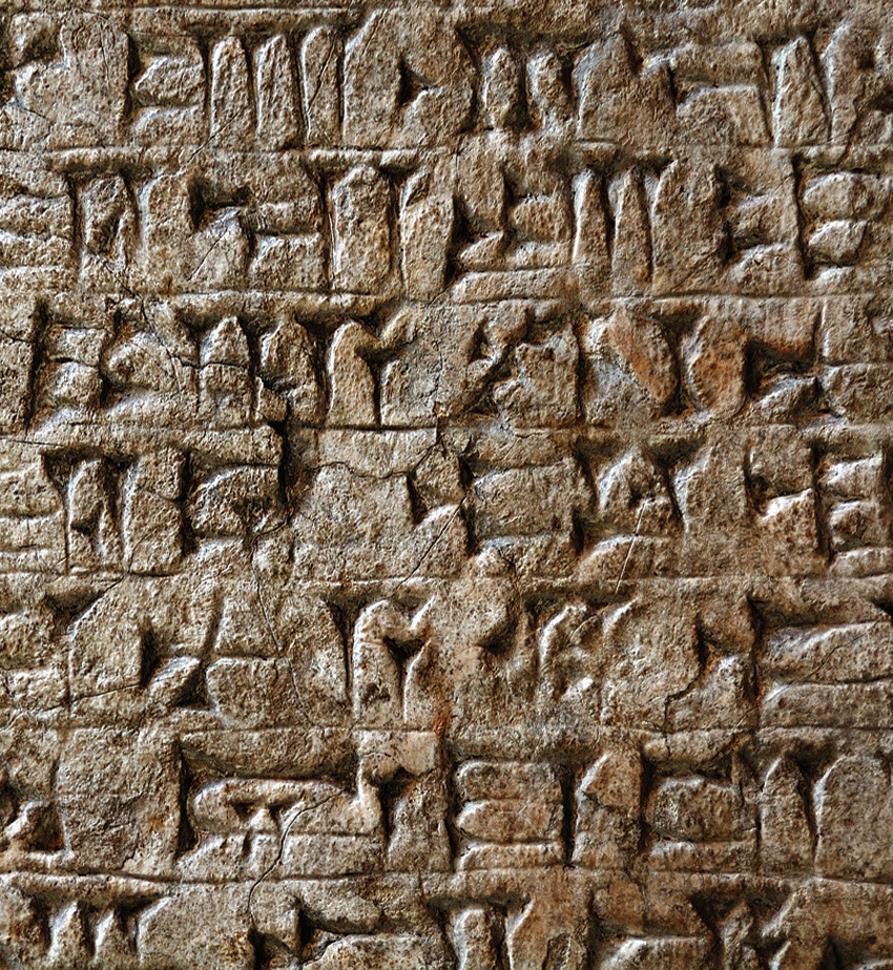
pictograph a symbol that stands for an object
In this lesson, you have learned about the characteristics of Sumer society that made it a civilization.
Stable Food Supply Ancient Sumerians invented an irrigation system and the plow to help them create a stable food supply.
Social Structure, Government, and Religion Ancient Sumer had a complex social structure with different jobs and social levels. Kings led the government. Religious beliefs influenced every part of daily life.
Arts, Technology, and Writing Ancient Sumerians had a highly developed culture that included the creative arts of painting, architecture, and music. The Sumerians’ most important technological invention was the wheel. They also created a written language called cuneiform that was based on pictographs.
You have learned that ancient Sumer was called a civilization because of its social structure. The ruling class, priests, kings, and nobles were in the top level. Merchants, artisans, farmers, and fishers were in the middle class, while enslaved people made up the lower class. When and how did these classes come into contact with one another during their daily lives? Four primary source artifacts can help you answer this question.
This mosaic of shells and stones is part of the Standard of Ur, dating back to 2600–2400 b c e Although the archaeologist who discovered it thought this artifact was carried into battle, many historians say its purpose is unknown.
In the early 1900s, Sir Charles Leonard Woolley, an archaeolo gist, was sifting through the largest tomb of an ancient cemetery in Ur (which today is in southern Iraq). He uncovered the now-famous Standard of Ur, a wooden “sign” that Sir Woolley thought was carried in battle with the king’s emblem. The standard’s wood was decayed, but much of the hollow box made of shell, red limestone, and lapis lazuli was intact. The standard dates back to 2600–2400 b.c.e.
On the standard, a long-ago artist depicted scenes of war and peace in Sumer’s civilization. The section of the standard shown here depicts a king seated on the left with two smaller men standing before him. From what you learned in this lesson, what was the most likely social class of these people? What role did the king play? What was life like for the lower social classes?
Compare the details that the artist shows for these three figures. What do these details suggest about their relationship? Why do you think the other men are depicted as smaller than the king? What does the image tell you about the interac tion between these two classes?
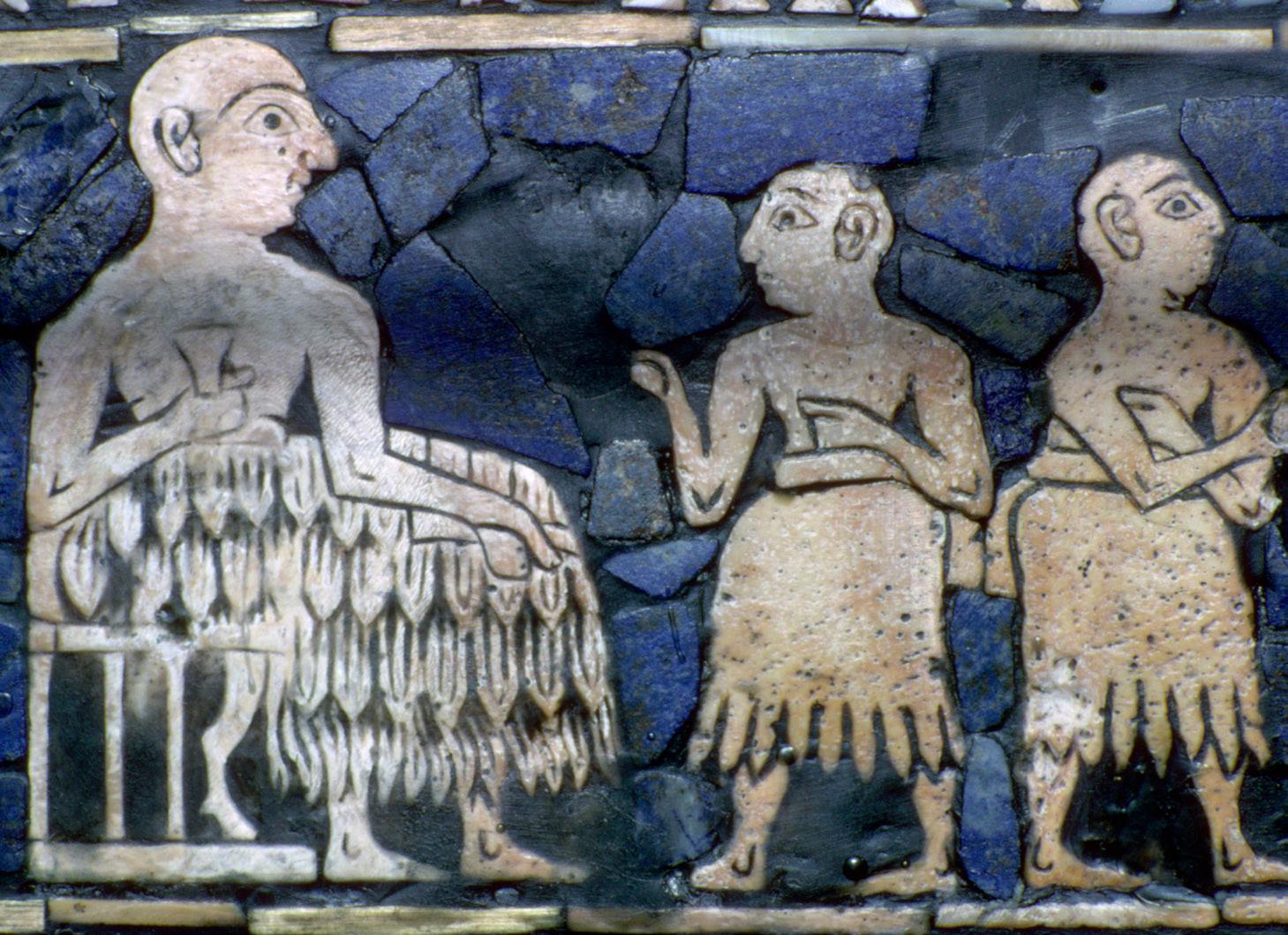

Between the highest ruling class and the lowest class enslaved people—was the middle level of the Sumerian social structure. Artisans and merchants were in this middle class. What might these people have to do with the ancient Sumerian necklace shown in this photograph?
An artisan from the middle class likely made this necklace. It is over 4,500 years old and about eight inches long. To make the necklace, the artisan needed raw materials such as gold, lapis lazuli, and other precious stones. Merchants likely stopped by an artisan’s workshop to sell these raw materials. Then, using techniques passed down through the generations, the artisan crafted these strands of beads and magnificent pendant.
On a following visit to the artisan, the same merchant may have bought the completed necklace from the artisan. From there, the merchant could have set out to find a buyer for it. To which social class do you think the buyer may have belonged?
Merchants frequently brought necklaces such as this one to the center of the city where top members of Sumerian society lived in large, lavish homes. People in this highest class—priests, nobles, and government officials—took pride in paying hand somely for such luxuries. Why do you think those who wore a necklace like this were considered in a higher class than those who made it? What does this necklace tell you about the top and middle members of Sumerian society? How do you think enslaved people were involved in this necklace’s story?
This beautiful necklace is over 4,500 years old. It is now in the National Museum in Baghdad, Iraq. In ancient Sumer, this necklace passed through the hands of people in at least two different social classes.
This bronze foundation nail was likely used by priests to dedicate a building or land to a specific god. Foundation nails were an important symbol of the upper class of Sumerian society.
When archaeologists uncovered this bronze nail, they found an important symbol for two groups of the upper class of ancient Sumer: nobles and priests. This is called a foundation nail and dates back to around 2100 b.c.e. It is made of metal, but many were made of clay or wood. Some foundation nails have inscriptions of words. Others have sculpted figures like this one.
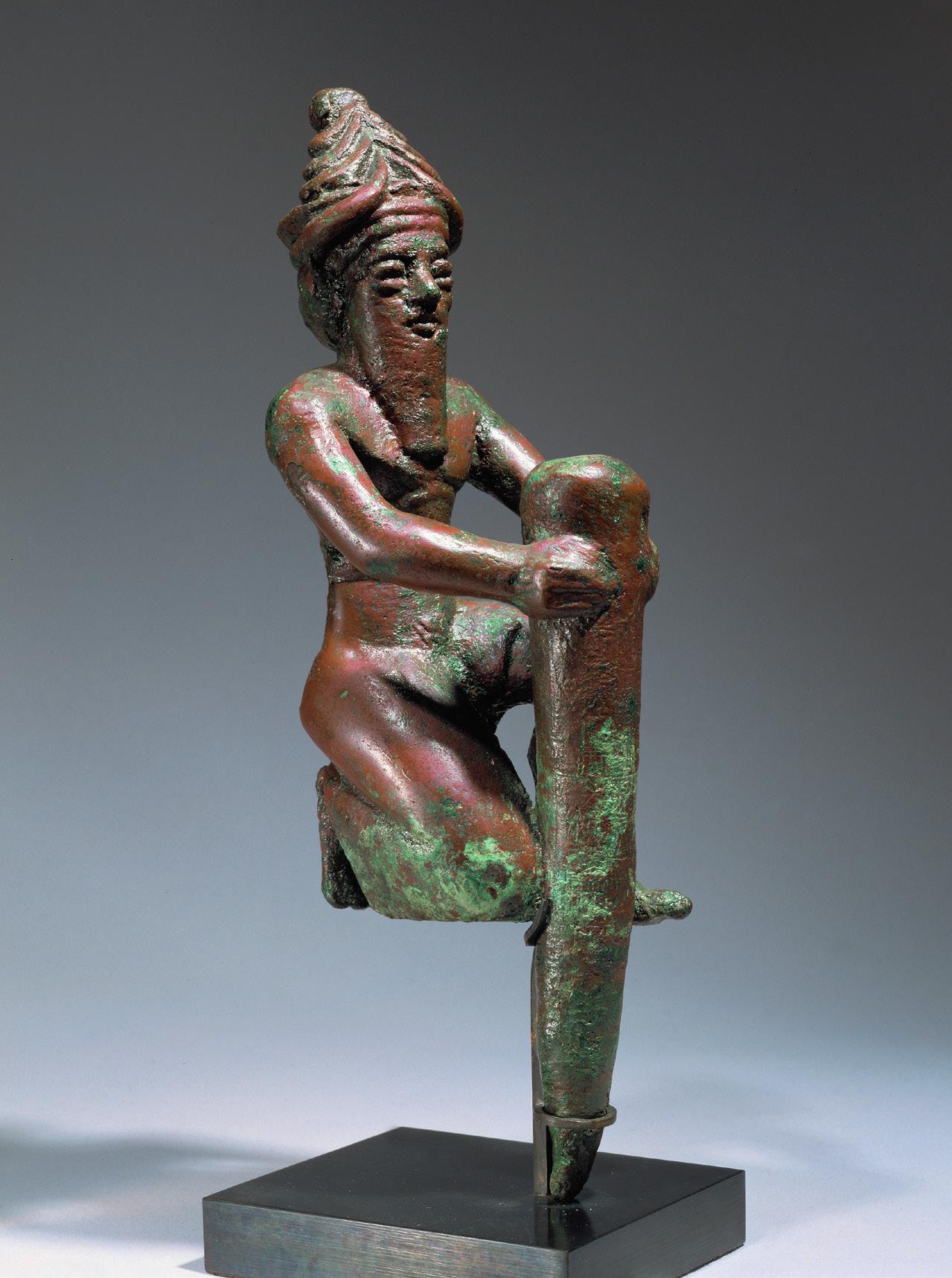
In ancient Sumer, nobles that owned land had a higher status in the social system than others. When these landowners purchased a piece of property or a building, they often drove a foundation nail into the side of a wall or into the ground. This may have represented the transfer of property ownership. Why would a foundation nail be useful in a society? Why would the owner of this foundation nail have a high status?
Foundation nails took on new symbolism for the priests. Priests often owned or controlled large plots of land, particularly where the temples were located. Priests were considered powerful landowners, though they claimed that the gods really controlled the land. To honor a specific god, priests would sometimes drive the nail into a sacred building or plot of land. The foundation nail in this photo was likely used by a priest for this purpose. The god on top has not been identified, but it is apparent that the nail was driven into the ground to look like the god is kneeling there. Why might a priest dedicate a large area of land to a god? Why might two landowners run into conflict with one another? When might the middle class and the enslaved class come in contact with a foundation nail?
The kings were at the top of the social system above all the citizens of the Sumerian city-states. People believed that the gods chose the kings and that the kings were the mediators between gods and the people. These powerful kings led the army, enforced the laws, collected taxes, and built temples. Everyone else, from priests to those who were enslaved, were expected to show respect and honor their kings in many different ways.
One way Sumerians could have honored a king was by burning a kind of sweet-smelling incense in a stand like the one in this photograph. An artisan created this stand for the wife of King Gudea, who ruled over the Sumerian district of Lagash, in 2100 b.c.e. She may have burned aromatic incense as she praised the king’s life. Offering stands could be found in the homes of people from multiple social classes.
What does this ritual show about the role of a king in Sumerian society? What does this artifact imply about the relationship of the king and the other Sumerian citizens? How would this artifact help you describe how people from multiple social classes interacted?
You have learned about four primary source artifacts. Review how each artifact involved people from different social classes. Do these artifacts tell you everything you need to know about the interaction of Sumer’s social classes?
What questions do you still have? Use what you know to write a claim about how the social classes of ancient Sumer interacted with one another. Support your claim with evidence from the artifacts.
People from all classes honored their kings by burning incense or other offerings in a stand like this one. It was made around 2100 b . c . e . for King Gudea’s wife to use to honor the king. This artifact is now located in the Louvre Museum in Paris, France.


Ancient Sumer flourished in Mesopotamia between 3500 and 2300 b.c.e. As you read on, you will discover what happened to the Sumerians and who ruled Mesopotamia after them.
The city-states of ancient Sumer were like small independent countries. They often fought over land and water rights, never uniting into one group. Their division left them open to attacks by stronger groups.
About 2300 b.c.e., the Akkadians (uh-KAY-dee-unz) conquered Sumer. This group made the Sumerian city-states a part of an empire, which is a large territory where groups of people are ruled by a single leader or government. Groups like the Akkadians first conquer and then rule other lands.
In this lesson, you will learn about four empires that rose to power in Mesopotamia between 2300 and 539 b.c.e. They were the Akkadian Empire, the Babylonian (bah-buh-LOH-nyuhn) Empire, the Assyrian (uh-SIR-ee-un) Empire, and the NeoBabylonian Empire.
You will also learn that each of these empires faced conflict with neighboring lands, which led to many wars. Rulers focused on improving their military strategies and began training war riors in more advanced tactics. Some people even chose to rebel against kings, creating problems within the empire.
What was life like in each of these powerful Mesopotamian empires? Who were the ruthless rulers that commanded them? Why did they all collapse? Let’s find out more about these empires.
This Assyrian bas-relief adorned the palace of King Sargon II.
Social Studies Vocabulary capital code of laws economy empire siege tribute
What were the most important achievements of the Mesopotamian empires?
The Akkadian military conquered the independent city-states of Sumer. King Sargon united these lands, creating the world’s first empire.
empire a large territory in which several groups of people are ruled by a single leader or government

For over a thousand years, Sumer was a land of independent city-states. Later, around 2300 b.c.e., the Akkadians from north ern Mesopotamia conquered the land. According to legends, King Sargon led the Akkadians and went on to become the first ruler of the Akkadian Empire.
Sargon was both a strong king and a skilled general who built his empire through effective military strategies. After assembling a large army, he taught his soldiers to fight in tight formations. Soldiers carrying shields stood at the front of the formation, while those carrying spears stood in the line behind. The spear-carriers would extend their weapons between the shields.
Sargon used his military tactics to add territory to his empire. After defeating the king of the city-state of Uruk, Sargon had gained control of all of Mesopotamia, including Sumer.

To maintain control of his empire, Sargon used complex political strategies. He destroyed the walls of many city-states, leaving them completely defenseless. Sargon believed that with out the protection of the walls, people were less likely to rebel. He also demanded the loyalty of the governors of city-states, replacing any disloyal ones with his own men.
Sargon lived to an old age and decreed that his sons would rule after his death. His name soon passed into legend because he and the Akkadians had created the world’s first empire. It stretched across Mesopotamia.
Sargon ruled his empire for more than 50 years, during which he formed the city of Agade (uh-GAH-duh) in northern Mesopotamia, the empire’s capital. He constructed the city with the help of tributes collected from the people he conquered. One of the richest and most powerful cities in the world, Agade became a cultural center with many beautiful temples and palaces.
The Akkadians may have ruled Sumer, but the Sumerian culture continued to thrive. The Akkadians farmed using the Sumerians’ irrigation techniques. To record information, they used Sumer’s system of cuneiform writing. They even wor shipped the same gods and goddesses, despite referring to them by different names. For example, the goddess Inanna became known as Ishtar, while the god An became known as Anu. Religion stayed central to the social order, and kings continued to rule in the name of the gods. Although men typically held power, priestesses and noblewomen had some access to power. For example, Sargon placed his daughter Enheduanna in the powerful position of high priestess of the moon god, a tradition that later kings adopted as well.
The Akkadians had their own cultural achieve ments. Over time, their language replaced that of the Sumerians. In art, they became especially well known for their skillful three-dimensional sculptures. Artisans also carved relief sculptures, called steles, on stones. A famous example is the Victory Stele, which was created to celebrate a military victory by Sargon’s grandson, King Naram-Sin. The stele shows NaramSin leading his victorious army up a mountain slope. Some of his enemies are crushed underfoot, while others die, flee, or beg for mercy.
Sargon had hoped that his empire would last for a thousand years, but future kings found it difficult to rule such a large territory, causing the empire to grow weak. After about 200 years, the Akkadian Empire fell to new invaders from the north and east.
capital a city that is the center of government
tribute wealth sent from one country or ruler to another as a sign that the other is superior
On the Victory Stele, King Naram-Sin is shown as taller than the other men. He wears a horned crown so he resembles a god.
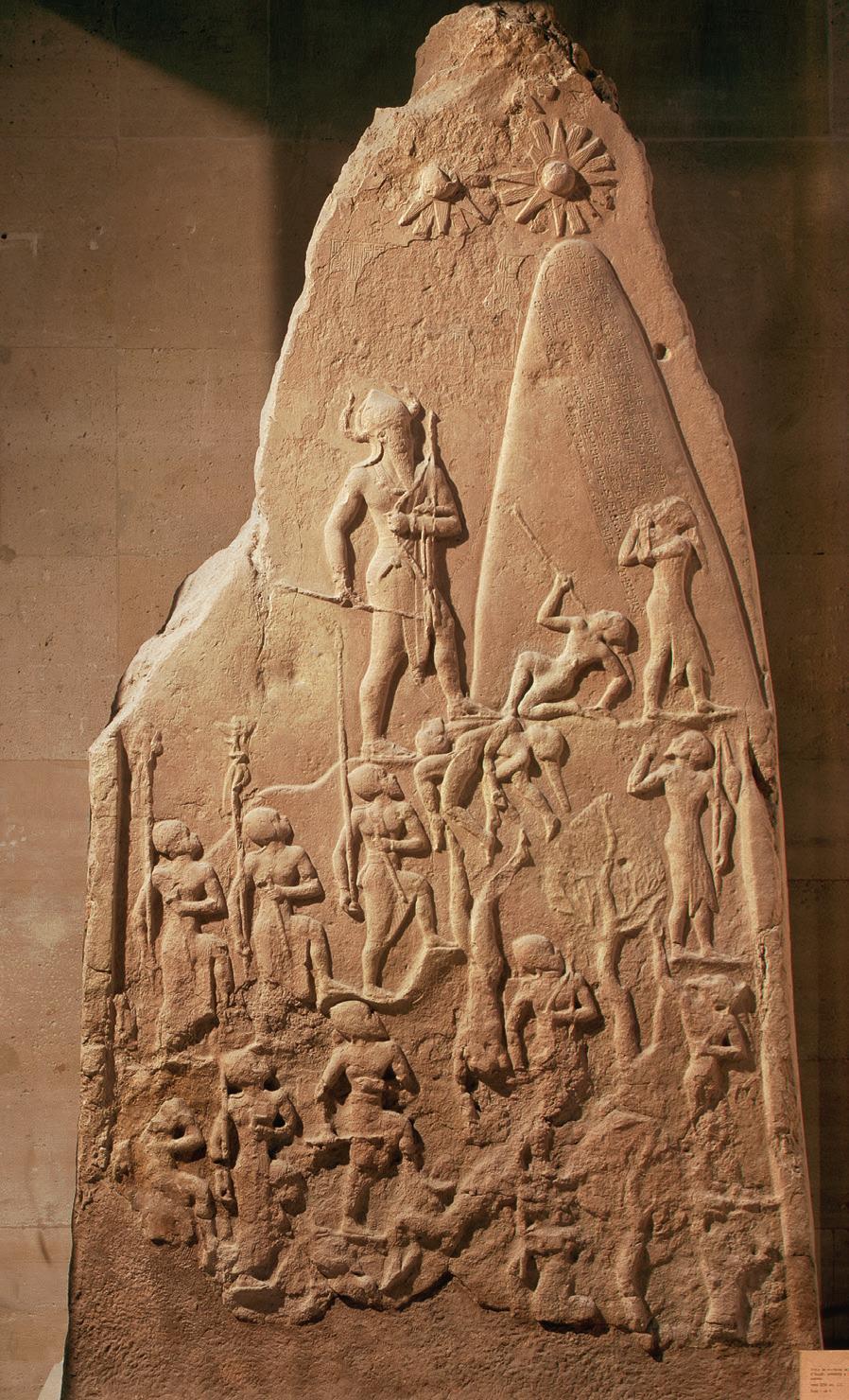
King Hammurabi united Mesopotamia and made the citystate of Babylon the capital of the Babylonian Empire.

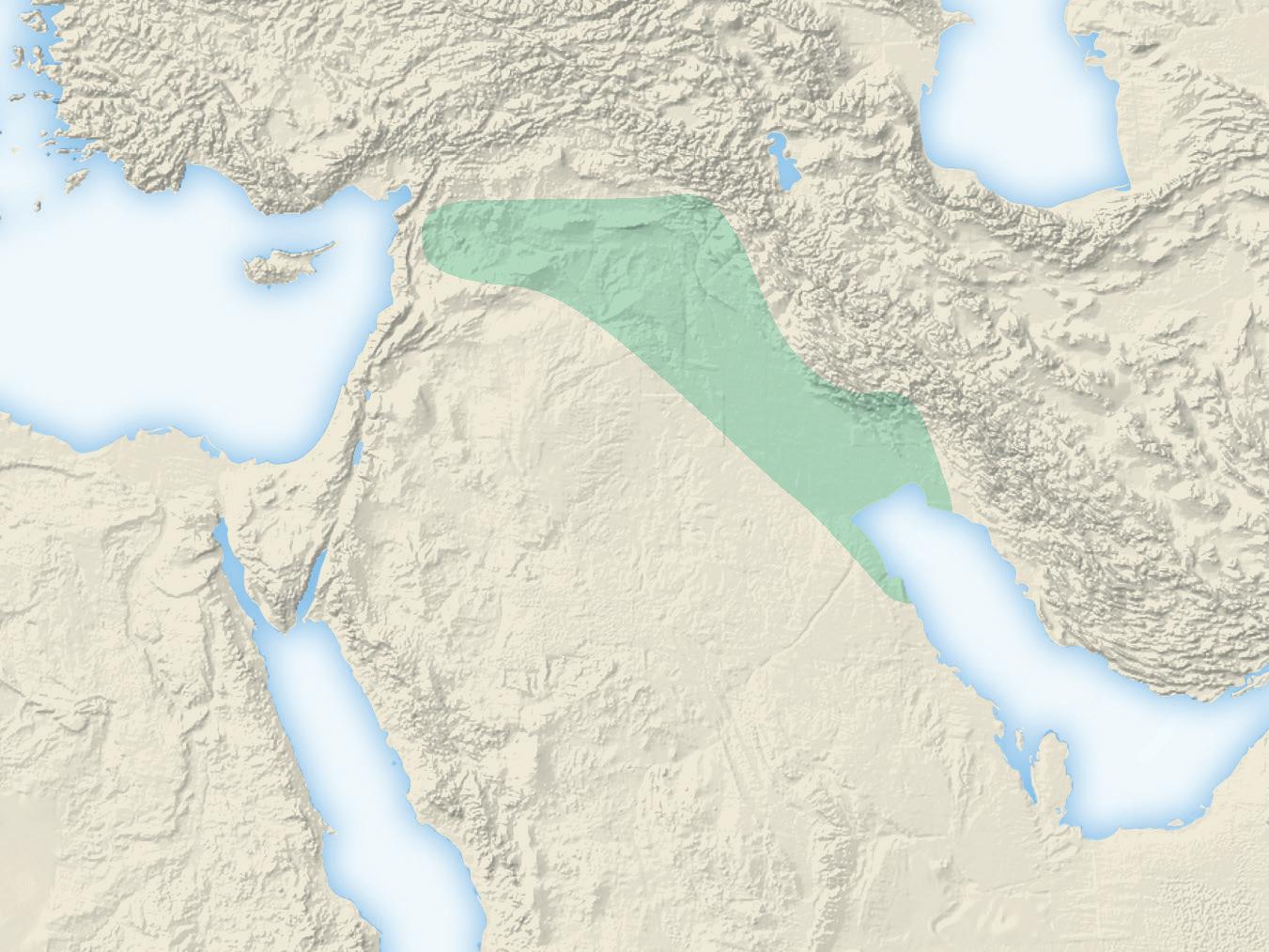

For a while after the fall of the Akkadians, Sumer was once again a group of city-states. The next ruler to unite all of Mesopotamia was a king named Hammurabi (hah-muh-RAH-bee).
Hammurabi ruled Babylon (BAH-buh-luhn), a small city-state in central Mesopotamia. After conquering the rest of Mesopotamia, he named Babylon the capital of his empire, so the region became known as the Babylonian Empire, or Babylonia.
Hammurabi is best known for his code of laws, which he wrote during his reign from 1792 to 1750 b.c.e. He used the code of laws to unify his empire and to preserve order, basing the laws not merely on his own authority, but on the word of the gods. He declared the Babylonian god, Marduk (MAHR-dook), supreme over other gods. Hammurabi claimed that the gods had instructed him to create laws that applied to the entire empire. Since the laws were based on the gods’ will, they could never be changed. The code of laws was written on a stele and put on public display in a temple.
Hammurabi’s code was carved on a stele so that all people would know their rights and responsibilities. He claimed that the gods told him which laws to create.
Hammurabi’s code was detailed, covering many situations, such as trade, payment for work, marriage, and divorce. The code spelled out punishments for crimes, such as stealing or causing injury. For example, if a poorly assembled house were to col lapse and kill its owner, then the builder could be put to death. However, if the owner’s son rather than the owner were killed in the collapse, the builder’s son could be sentenced to death.
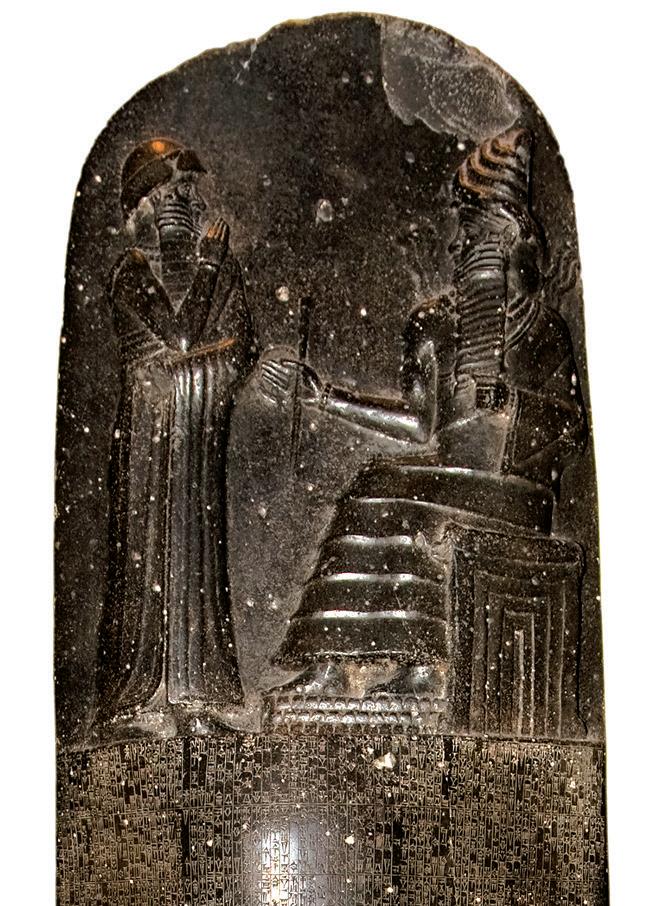
Laws like this one seem harsh to us now, but Hammurabi’s code was a notable achievement. Although the laws and punish ments did not treat all people equally, the code did apply to everyone living in the empire.
Babylonia thrived under Hammurabi. He worked to unite the people of his empire. The roads he built and the postal service he created helped connect Babylonians of all social statuses.
Agriculture and trade flourished. Hammurabi was careful to properly maintain irrigation systems so that land remained fertile and provided enough food. Because the city of Babylon was on the banks of the Euphrates River, it became an important center of trade. Babylonians traded grain and woven cloth for wood, gold, silver, precious gems, and livestock (animals) with people throughout the Persian Gulf.
Trade helped the empire’s economy. Many types of artisans used materials brought from distant lands like Egypt. The arts also flourished. Writers wrote historical poems, some of which survive today.
Most significantly, Babylonian society was unusually fair for its time. The laws treated the various classes differently, but even enslaved people had some rights. Those enslaved could work elsewhere and keep their wages, own property, and even buy their freedom if they saved enough money.
Babylonian women also had more rights than in most other ancient societies. Even though their fathers chose their husbands, women could own property and keep money of their own.
Hammurabi was proud of his achievements, once writing:
I rooted out the enemy above and below.
I made an end of war. I promoted the welfare of the land . . .
I have governed them [the people] in peace.
I have sheltered them in my strength.
The arts, including music, flourished under Hammurabi’s rule. Here, four musicians are playing different types of instruments, two of which appear to have strings.
economy the way a region or country uses resources to produce and sell or trade goods and services to meet people’s needs and wants

At its peak, the Assyrian Empire extended from Egypt to the Persian Gulf. This vast territory was difficult to control and defend.
a military blockade


attack on a city to force
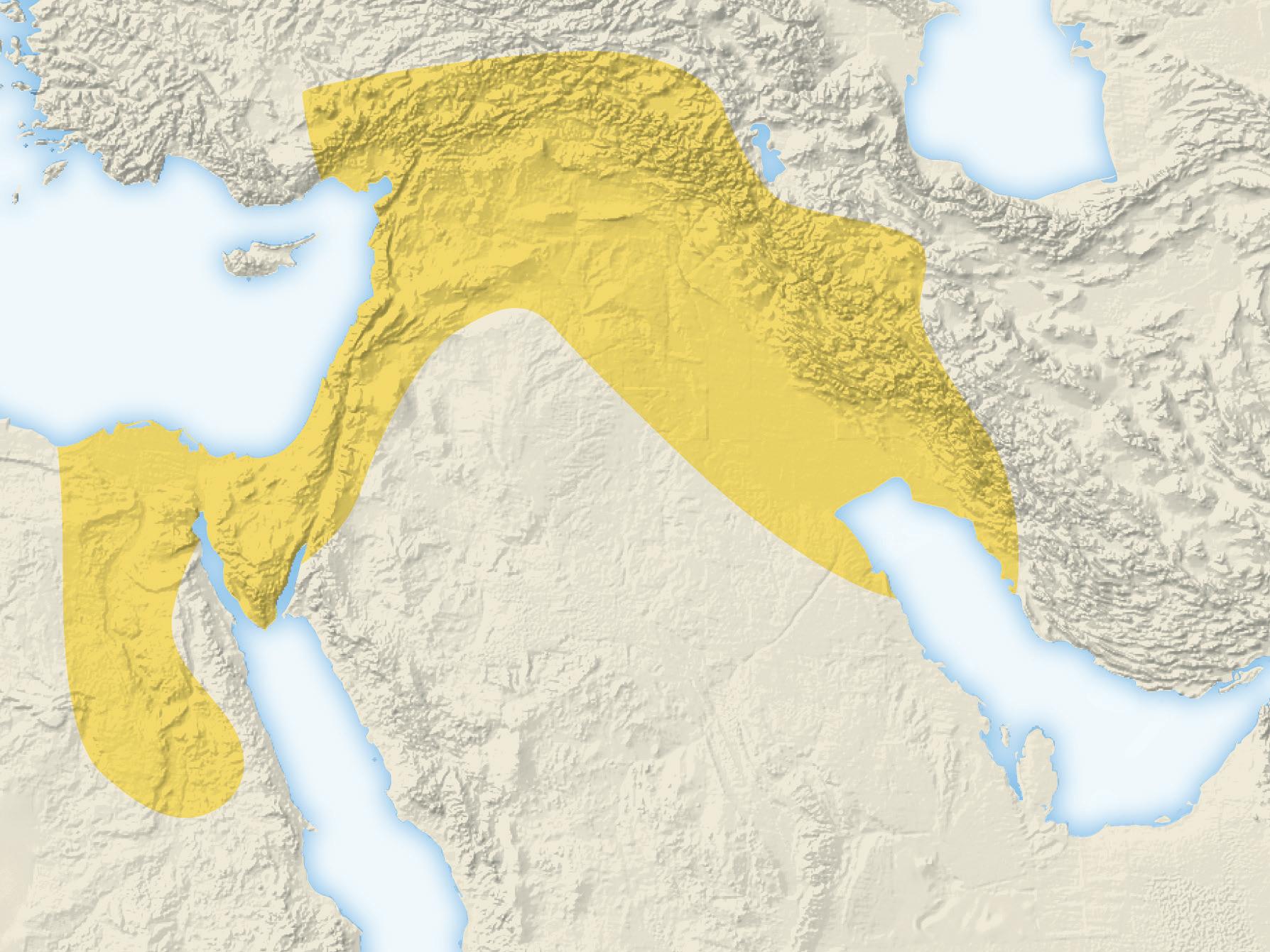
This carving shows an army using a battering ram to break through the walls of a city. This was one aspect of siege warfare.
The line of royalty Hammurabi initiated did not continue to rule Babylonia for long. Over the next several hundred years, a number of groups governed sections of what had previously been the Babylonian Empire. However, a warlike people called the Assyrians created the next great empire in Mesopotamia. Assyria lay to the north of Babylon. The Assyrians had lived in Mesopotamia for a long time, briefly establishing their own empire before Hammurabi conquered them. They rose to power again toward 900 b.c.e., when a series of Assyrian rulers began training an army for war in hopes of expanding their territory. The Assyrians were feared for their military might and their cruelty. Their greatest achievements were their new weapons and war strategies. They perfected the use of horses and iron weapons in battle. They also became greatly skilled at siege warfare, a strat egy in which army soldiers camp outside a city and repeatedly attack it until the city falls. The Assyrians developed new ways of attacking cities. For instance, they developed new types of battering rams. These long, heavy, wheeled beams were used for breaking down walls. The Assyrians also built moveable towers that were rolled up to a city’s walls so that soldiers could climb over the walls.

The Assyrians were often ruthless. They might force entire populations to leave areas they had recently conquered. The Assyrians spread tales of their cruelty far and wide, and creating fear among their enemies became part of the Assyrian military strategy.
Powerful kings ruled the Assyrian Empire. Religion, however, remained extremely crucial to social and political order. Even kings were obliged to obey the gods.
The Assyrians believed that their kings were special beings, so they built elaborate palaces to honor their rulers. The great palace in the capital city of Nineveh (NIH-nuh-vuh) had many rooms. Some palaces were built on tall mounds, to raise them above the surrounding buildings. Huge sculptures of winged bulls or lions, with human faces, stood at the entrances.
Like other societies in Mesopotamia, the Assyrians dug canals to irrigate their land and keep it fertile for farming. They also developed some of the first aqueducts, which are pipes or channels used to carry water. A system of canals and aqueducts brought drinking water to Nineveh from 30 miles away.
Assyrian artisans were known for their two-dimensional sculptures called bas-reliefs Many of their most famous bas-reliefs were on palace walls. Amazingly realistic, they often depicted scenes of the king hunting, fighting in battle, or enjoying family life. The Assyrians used ivory to decorate thrones, beds, and chairs.
The Assyrian Empire lasted about 300 years. At its height, it stretched from Egypt to the Persian Gulf, but its weakness lay in being too vast a territory to control. The army was stretched thin, and the Assyrians could not fight off opposing neighbors. In 612 b.c.e., a combined army of Babylonians, Scythians, and a group called the Medes attacked Nineveh, permanently breaking the Assyrians’ reign over the land.
This winged bull with five legs stood guard before the palace of an Assyrian king. It signified the elite status of those living within.

Compare the area on this map of the Neo-Babylonian Empire with the area of the Babylonian Empire that existed about 1,000 years earlier.
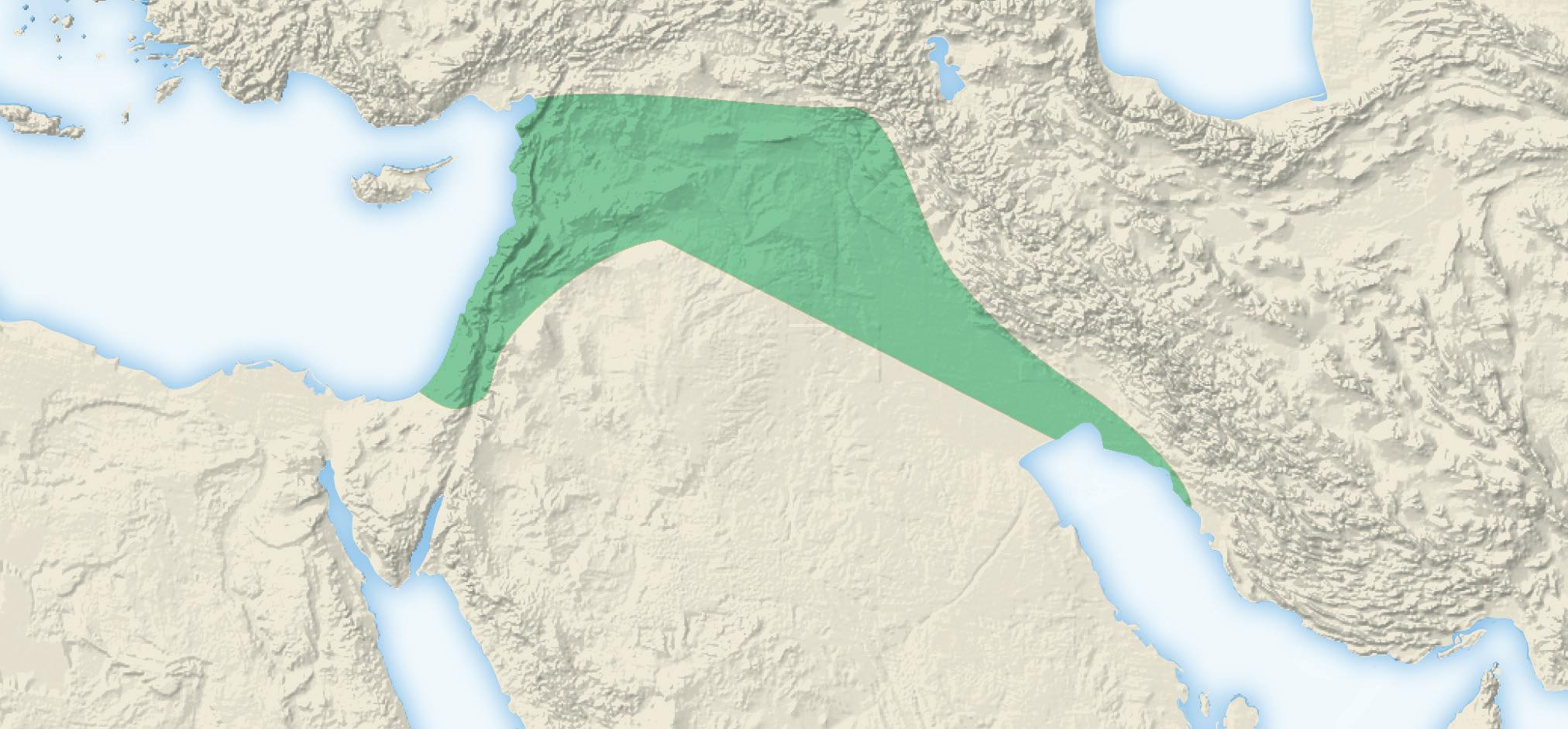
After the fall of Nineveh, the Babylonians once again took control of Mesopotamia, establishing a new empire called the Neo-Babylonian Empire. Neo means “new.”

The new empire’s most well-known king was Nebuchadnezzar II (neh-byuh-kuhd-NEH-zehr). He was a ruthless military leader who reigned from 605 to 561 b.c.e.
Nebuchadnezzar expanded his empire whenever possible. He drove the Egyptians out of Syria and also conquered part of Canaan (present-day Israel), which was the home of the Israelites, or Jews. When the Israelites rebelled, he took most of them captive and brought them to Babylonia. Many of them were never able to return to their homeland.
As a military leader, Nebuchadnezzar felt that it was essential to keep the capital city of Babylon safe, so he had inner and outer walls built around it. These walls were so thick that two chariots could pass each other on top of them. Towers, for archers to stand on, were constructed on the walls. Finally, a moat was dug around the outer wall and filled with water. During peacetime, people used bridges to cross the moat and enter the city. In times
bridges were dismantled.
The Ishtar Gate was one of the entrances into Babylon. Each gate was dedicated to a Babylonian god or goddess. Ishtar was the goddess of war and love.
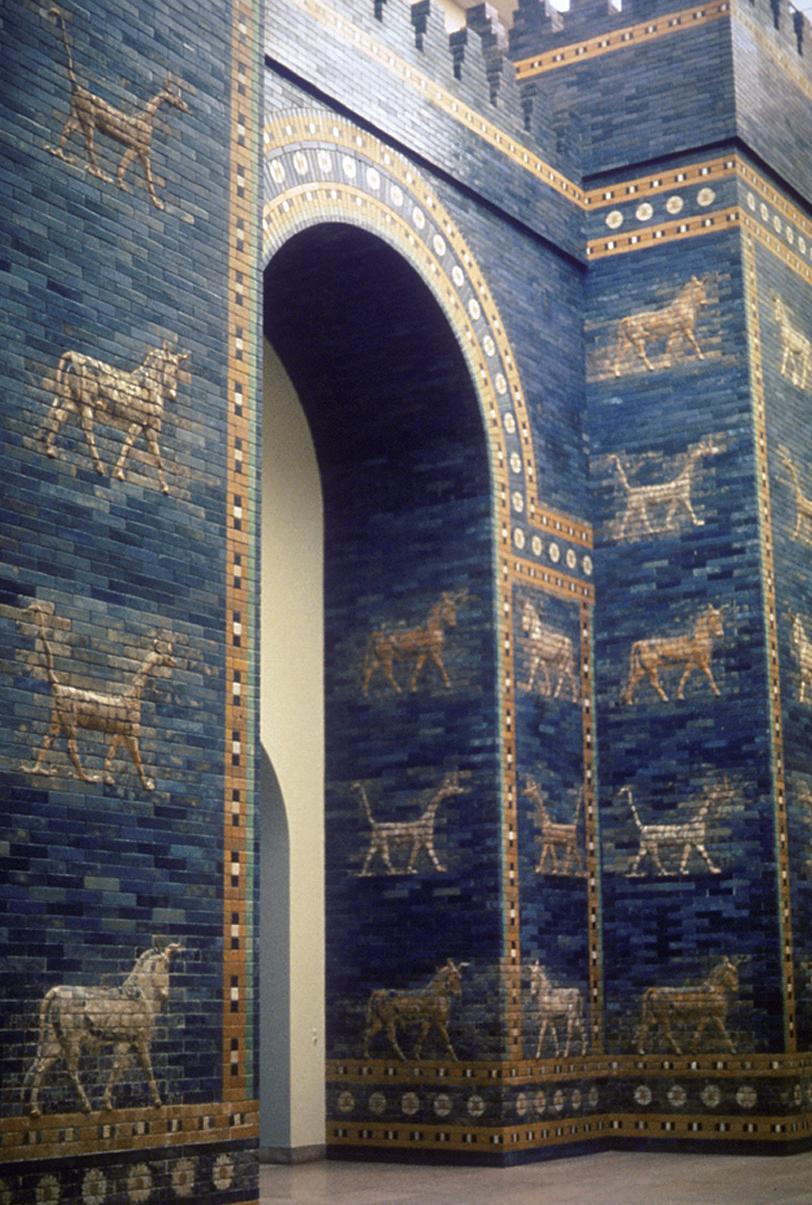
Nebuchadnezzar worked hard to restore the splendor that Babylon had enjoyed under Hammurabi. From 605 to 562 b.c.e., he rebuilt the city’s ziggurat, a huge structure that was several stories high. The Babylonians referred to it as the “House of the Platform of Heaven and Earth.”
Nebuchadnezzar decorated his palace with lush gardens planted on rooftops and tall terraces so that greenery would cascade down the walls. A watering system kept the plantings fresh and green. The Hanging Gardens of Babylon became famous, and this human-made display is consid ered one of the great wonders of the ancient world.
The Babylonians were also skilled in mathemat ics and astronomy. They created the first sundial, a device that uses the sun to tell time. They made discoveries that many believe led to our modern system of a 60-minute hour and a 7-day week.
The Neo-Babylonian Empire lasted only 75 years. Then, in 539 b.c.e., a new conqueror from the Persian Empire named Cyrus (SIE-ruhs) swept into Babylon from the east.
The Persians came from present-day Iran. For about 200 years, they ruled the most powerful empire in the world, until a man named Alexander the Great conquered the Persians.
The Hanging Gardens of Babylon were collectively one of the great wonders of the ancient world. The sight of so many trees and bushes rising above the desert landscape was astonishing.
In this lesson, you read about the most important achievements of the four empires that once ruled Mesopotamia.
The Akkadian Empire King Sargon created the world’s first empire. The Akkadians developed their own language. Artists carved relief sculptures on stones.
The Babylonian Empire King Hammurabi created a code of laws that applied to everyone in the empire. Babylonian agriculture and trade thrived under his rule.
The Assyrian Empire The Assyrians honored their powerful kings with palaces and huge sculptures. They built some of the earliest aqueducts.
The Neo-Babylonian Empire King Nebuchadnezzar restored the splendor of King Hammurabi’s time. His Hanging Gardens of Babylon became famous in the ancient world.
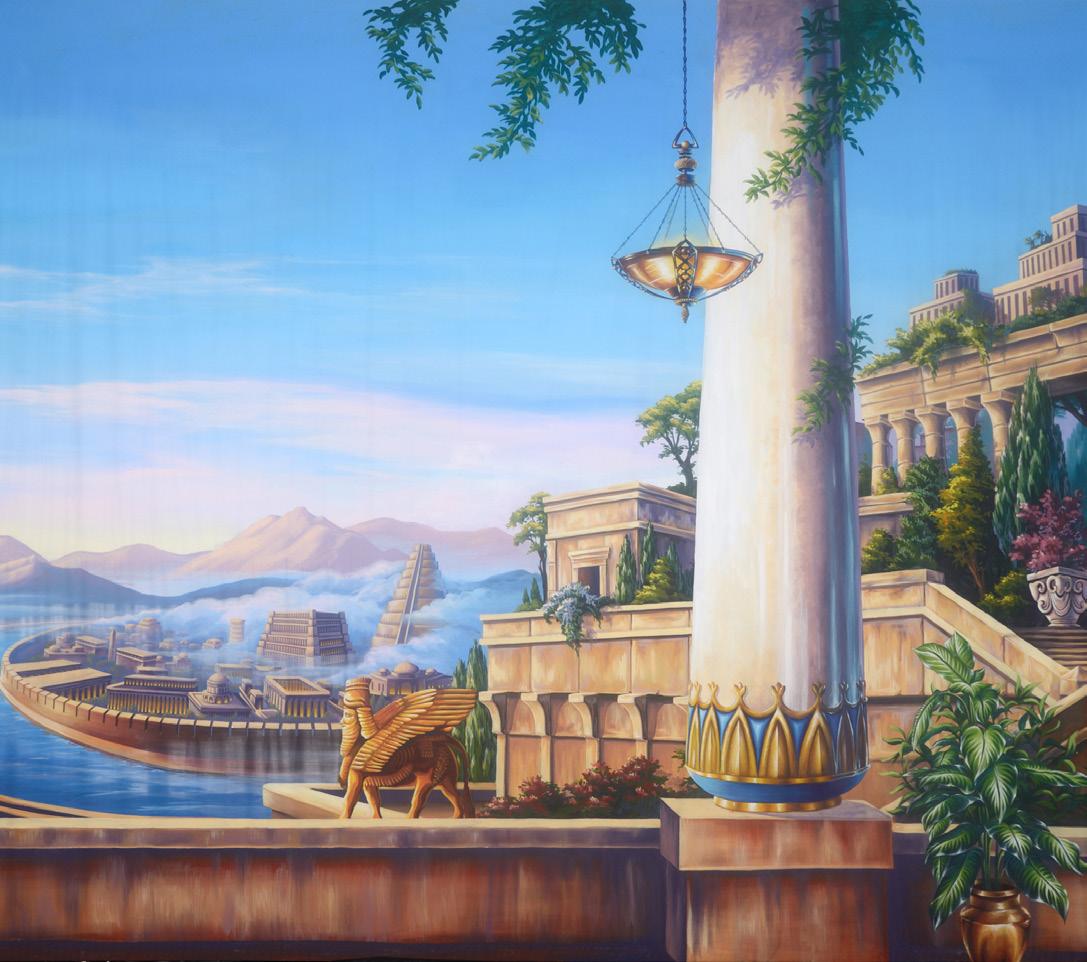
Activity
and analyze artifacts
draw conclusions about the history
about what social scientists know about ancient Persia through a video covering the main ideas of

Activity
complete an online activity to show what you’ve learned.
you complete the reading, respond to questions in your online or print notebook to make sense of the content.
and Notes
Picture an ancient empire so large that it included part or all of more than 20 countries that exist today. Imagine an empire with connected territory in Europe, Asia, Africa, and the Middle East. Suppose that this empire included Egypt and shared borders with the Aegean Sea to the west, the Arabian Peninsula to the south, and the Indus River to the east.
All the details you just put together are characteristics of the first and largest empire of ancient Persia. Even if you have never heard of ancient Persia, you could conclude that it was an impor tant power in more than one region. You could be pretty sure that a large bureaucracy of workers ran the government. You could guess that such a large state might not always get along with its neighbors. Lastly, you might wonder what happened to it.
There are some important facts about ancient Persia. It was run by a large bureaucracy. It allied with, fought with, conquered, and was conquered by its neighbors until it came to an end when Arab rulers took over the region. Ancient Persia has a lot in common with other ancient empires. But, for various reasons, we have less information about the Persian empires than we do about other ancient civilizations.
In this lesson, you will read about ancient Persia and its empires. You will learn how we know about it and why our knowledge is limited in some areas. Then you will learn about how the empires were connected to each other and what we know about life in them. Finally, you will explore how different Persian dynasties across history ruled their empires.
The wall covered with figures in the foreground is part of the ruins of the Apadana (audience hall) at Persopolis, one of the capitals of ancient Persia.
Social Studies Vocabulary administration arid central state conspiracy diverse legitimacy satrap semi-arid steppes subject state tolerance usurper
central state the governing domain of an empire
subject state a domain that has been conquered by the central state and made part of its empire
legitimacy the right or lawfulness of a ruler’s claim to be head of the government
The term ancient Persia refers to empires that existed in the period from 550 b.c.e. to 650 c.e., although some scholars consider the empire to have started around 500 b.c.e. Since there were five empires in ancient Persia, the first step in studying them is to understand when they existed and how they were related.
What Were the Persian Empires? The beginning and ending of an empire usually seems clear. Often, an empire begins when one state, a territory under a single government, conquers another state. Typically, the conquering or central state treats its new conquest as a subject state. As subjects of the empire, the conquered peoples in the subject state may be allowed to continue their beliefs and practices. Their local government may not change. But there is usually one key change for subjects. They must pay tribute or tax to the empire. An empire usually ends when it is conquered or the ruling dynasty dies out.
Starting an empire often presented challenges to the new ruler. When rulers conquered an existing empire, they needed to estab lish legitimacy (lih-JIH-tuh-muh-see), or their right to rule. They might base their claims solely on their conquests.
This is a relief sculpture along a wall of the Apadana at Persepolis in Iran.
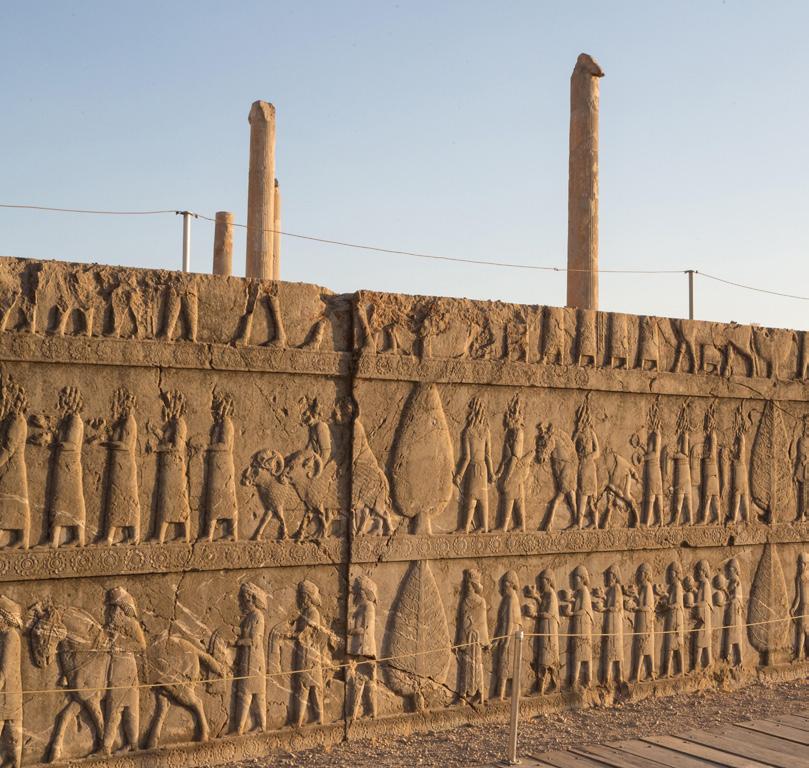
Some of the Persian conquerors took a different approach. This involved a ruler trying to show the conquered that he was connected to them in some way. Sometimes, he offered proof of connection to an earlier dynasty. Often, he made use of the existing bureaucracy, employing local people who held positions before his victory. Rulers who took this second approach wanted people to accept them, not just accept defeat. They wanted people to see something longer lasting.
The Empires of Ancient Persia Scholars usually speak of five separate empires in ancient Persia. All of them ruled in the territory north of the Persian Gulf in the period from 550 b.c.e. to 650 c.e. Three of the empires were Persian. The founders of the Persian empires were members of one of the tribes of Iranic (eye-RAN-ihk) peoples. The Iranic tribes had similar ethnic and language backgrounds and lived north of the Persian Gulf. The other two empires are called Greco-Macedonian because they were ruled by men with Greek and Macedonian backgrounds and cultures. The chart shows the names and dates of all five empires, each illustrated with a coin from the ruler who gave the empire its name.
Achaemenid (uh-KEHM-ih-nihd) Empire—550 b.c .e . to 330 b.c .e .
Darius I (duh-RYE-uhs) claimed Achaemenes (uh-KEHM-ihn-eez) as his ancestor, but Cyrus (SEYE-ruhs) is considered the founder of the empire. (Darius I was the ruler in 500 b c e , which some scholars view as the start of the empire.)
Alexander the Great’s Empire—330 b.c .e . to 323 b.c .e .
Alexander the Great, founder of the empire that bears his name, became king of Macedonia in 336 b.c . e . , six years before conquering the Persian Empire.
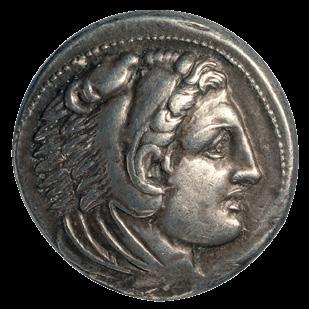

Seleukid (suh-LOO-kihd) Empire—312 b.c .e . to 64 b.c .e .
Seleukus Nicator I (suh-LOO-kuhs nih-KAY-tur), was the founder of the Seleukid Empire.
Arsacid (AR-suh-sihd) Empire—247/236 b.c .e . to 224 c .e .
Arsaces I (AHR-suh-seez), from Parthia, was the founder of the Arsacid Empire, sometimes called the Parthian Empire.
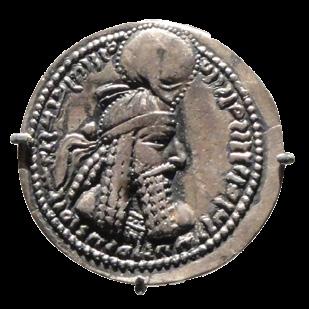
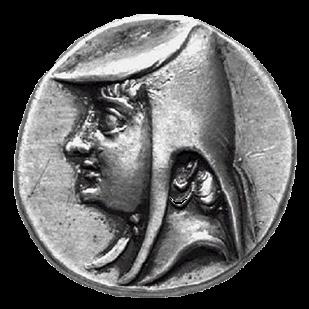
Sasanian (suh-SAY-nee-uhn) Empire—224 c .e . to 650 c .e .
Ardashir I (AHR-duh-shur), was the founder of the Sasanian Empire, which he named after his ancestor Sasan.
All five empires included the land above the Persian Gulf that was called Parsa (PAR-suh) or Persis. But from here on, we will focus on the three Persian empires. Those were the Achaemenid, Arsacid, and Sasanian Empires. We will explore ancient Persia and other civilizations, we will try to understand them through their own records, writings, and artifacts. How did the rulers of the Persian empires view themselves, each other, and the GrecoMacedonian rulers? Did the rulers of later empires believe that they were connected to or different from earlier empires? Did the rulers feel connected despite their differences? We will explore how their attitudes shaped their policies.

This is a three-language royal inscription of Darius I, an Achaemenid king, carved into a rockface near Hamadan.
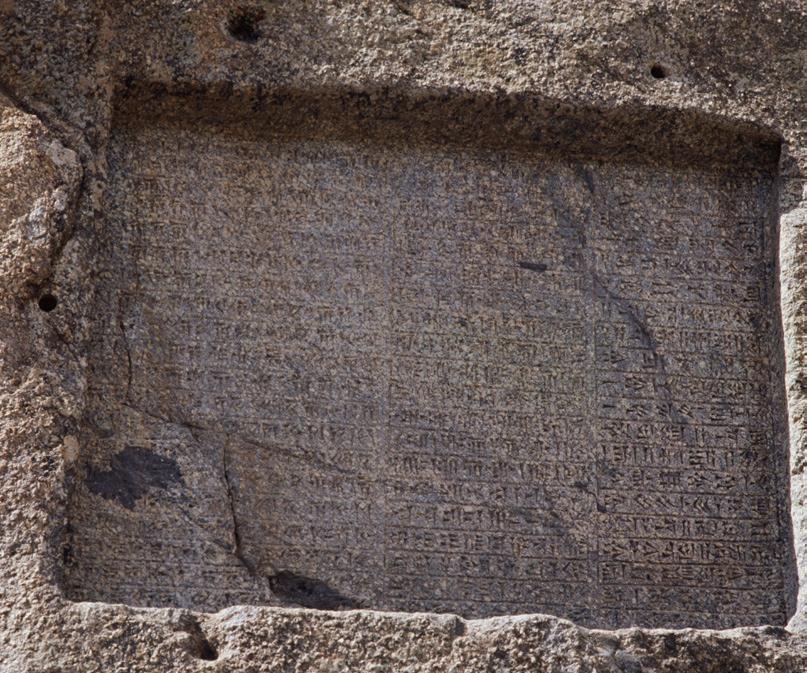
All ancient civilizations present researchers with some common difficulties. After so many years, the texts used to study ancient civilizations may not be in good condition. Some texts have been lost. Others are too damaged to be useful. Still others are in private collections and not available to scholars. Artifacts and other elements of material culture may also be lost, damaged, or unavailable. But researching ancient Persia presents some special challenges.
Part of the challenge of studying ancient Persia is limited access to records written by Persians about Persians. This is mainly because ancient Persians relied on oral history, and that record has been lost. The way the Persian national epic was written both resulted from and led to confusion between fact and fiction.
In 1930, a dig led by the Oriental Institute of the University of Chicago discovered two collections of tablets at Persepolis. They were government records from the Achaemenid administration. The sets were named by the locations in which they were found. They were called the Persepolis Fortification Tablets and the Persepolis Treasury Tablets. But they only provide a very small glimpse of Persian history.
In the early days of archaeology, people did not always know much about what they were looking at. In at least one site, archaeologists ignored layers that held artifacts from the Arsacid and Sasanian empires. They only wanted the earlier Achaemenid objects. Until the late 19th century, people commonly used ancient building materials in new buildings. People also inten tionally stole artifacts from ancient sites to sell to antique dealers.
Artifacts and texts from ancient Persia have also been destroyed in multiple ways. In 330 b.c.e., Alexander burned the capital of Persepolis after conquering the Achaemenid Empire. The fire destroyed several buildings and unknown treasures, including texts written on papyrus and leather scrolls.
Although the intent was destruction, some scholars believe that the Persepolis Treasury Tablets were actually preserved by the fire, which baked them hard. Some scholars also think that the Fortification Tablets may have been preserved by the collapse of the floor above them, which may have also have occurred during the Macedonian destruction of the city.
The Changing Evidence About Ancient Persia The evidence about ancient Persia is continually changing. The discovery of new artifacts continues to add to our understand ing. So do translations of texts that have been stored but never analyzed. From time to time, missing material turns up, provid ing new insights. And sometimes new types of analysis provide new understandings.
And then, every so often, new translations change our views dramatically. Until 1933, scholars thought all Achaemenid administration records, the government texts that tell how the empire was run, were in Aramaic. That’s what the evidence told them. But in 1933, a record written in Elamite was discovered among the Persepolis tablets. As a result, views about language use in ancient Persia changed. In a similar way, before 2006, scholars thought Old Persian was only used in royal inscriptions, texts authored by the kings. That’s what the evidence said. But then scholars deciphered an administration record from Persepolis written in Old Persian. Again, they had to revise their ideas. With new finds and deciphering of more texts, the information we have is constantly changing.
In some cases, broken items have been separated, leaving an incomplete record. Local people who dug at ancient sites sometimes broke artifacts in order to have more pieces to sell. In this case, there is the hope that missing pieces will be found, as happened with the Cyrus Cylinder. But for this to happen, scholars must recognize connections between fragments that may be far apart.
In 1971, German scholar P. R. Berger deciphered the text on a broken artifact in the collection at Yale University. He thought it was part of the Cyrus Cylinder, which is housed at the British Museum. Yale loaned out the piece so that it could be tested.
The piece fit! Yale graciously loaned the piece to the British Museum so that it could be joined to the cylinder permanently.
New technology, like DNA testing and electron microscopes, can be applied to both old and new artifacts from the Persian empire to reveal new information. Methods being employed include archaeological chemistry, to analyze beverages and pigments used on sculptures, and genetic analysis of DNA, to trace population movements of the Iranic peoples. Texts and artifacts that have already been analyzed may reveal new infor mation when explored using new techniques.
administration the people who perform the work of government
This is a photograph of a cast of the fragment of the Cyrus Cylinder found at Yale, courtesy of Yale Babylonian Collection.


This is one of the cuneiform inscriptions at Persepolis. This cuneiform script was based on earlier Sumerian and Akkadian forms.

How Do We Know the History of Ancient Persia? When we study many ancient civilizations, we mainly read texts and look at evidence from people who lived in that civilization. But we can’t study ancient Persia in this way. As we have learned, many of their records were never written down, were lost or destroyed, or have not yet been accessed and deciphered, for the reasons we’ve discussed. So, what are our sources for understanding ancient Persian history?
The Recovery of Persian History National epics combined history with myth and legend. Without other evidence, this mix of fact and fiction over a long period of time became what everyone believed. Nobody really knew the facts of ancient Persian history for many hundreds of years. But research and archaeology gradu ally helped reconstruct the historical record.
The recovery began with discovering how to read cuneiform. In 1765, Danish explorer Carsten Niebuhr copied the inscriptions at Persepolis and other important sites. In 1802, scholars used Niebuhr’s work to begin deciphering Old Persian. In 1896, Mirza Fursat Shirazi published site plans and drawings of reliefs at Persepolis. Reading the cuneiform, he was able to link historical Achaemenid rulers to their fictional Shahnama counterparts.
Revived Interest in Ancient Persia Interest inside and outside of Iran led to numerous archaeological expeditions, starting in the 19th century. In 1931, the Oriental Institute of Chicago began an excavation at Persepolis. In 1933, the excavation uncovered the Persepolis Fortification and Treasury Tablets. Ever since their discovery, Iran has granted the Oriental Institute a continuous loan of the Persepolis Fortification collection of tens of thousands of tablets and fragments. As they have been deciphered, they have helped to build a new understanding of Achaemenid society.
Tablets include several types of records. Some are letters, but most are memoranda, short notes recorded for future use. The letters are requests for payment. The memoranda record payments received and goods received. From information about how much different people were paid, we can learn about a society. The tablets also include a few unique items. For example, there is a Babylonian legal document. It records that several Medes paid their state taxes in 502 b.c.e. Overall, the tablets reveal information about daily life that is not available elsewhere.
This cuneiform tablet comes from the Persepolis Fortification Archive. It is one of tens of thousands of tablets that have helped recover a historical view of the Achaemenid Empire. But it is different from the others in one key way. It is the Old Persian tablet that changed scholars’ understanding of the languages used in administrative records.
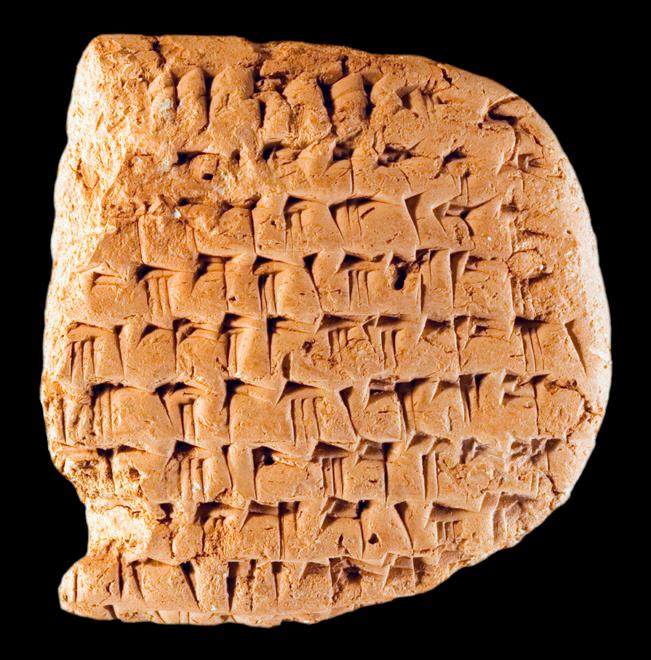
There are several types of shorter records of important historical events in the Achaemenid Empire that survived. There are royal inscriptions that record historical events and lists of kings. Some temple archives from Babylon have also been found.
We also lack historical texts from the Arsacid Empire, the record of which, at the present time, is mainly supplied by coins. There are no texts that detail the empire’s administration or social life. Isolated items provide some details about wine distribution, property, and limited historical events. From the Sasanian Empire, historical texts include inscriptions from the kings and the Zoroastrian high-priest Kerdir and others, as well as letters on military matters from late in the empire. There are some other texts that record historical events and some narratives. But none of these provides a complete chronological record of historical events.
Thus, the only first- or second-hand histories that record long spans of ancient Persian history and have survived were written by outsiders, mainly Greeks. This poses a problem for discovering Persian history. Obviously, the outsiders only wrote about aspects of Persian history that were important to them. So, a great deal of Persian history was never recorded. And there are two particular reasons why we cannot entirely trust the Greek histories. The reasons lie in the attitudes of the Greeks toward the Persians— calling them barbarians—and the ancient understanding of writing history.
This is the first tablet from the Persepolis Fortification Archive that was identified as being in Old Persian.
This statue of Herodotus seated and reading a scroll is in front of the Austrian parliament building in Vienna. The figure is probably meant to represent democracy. How else could the figure be interpreted?
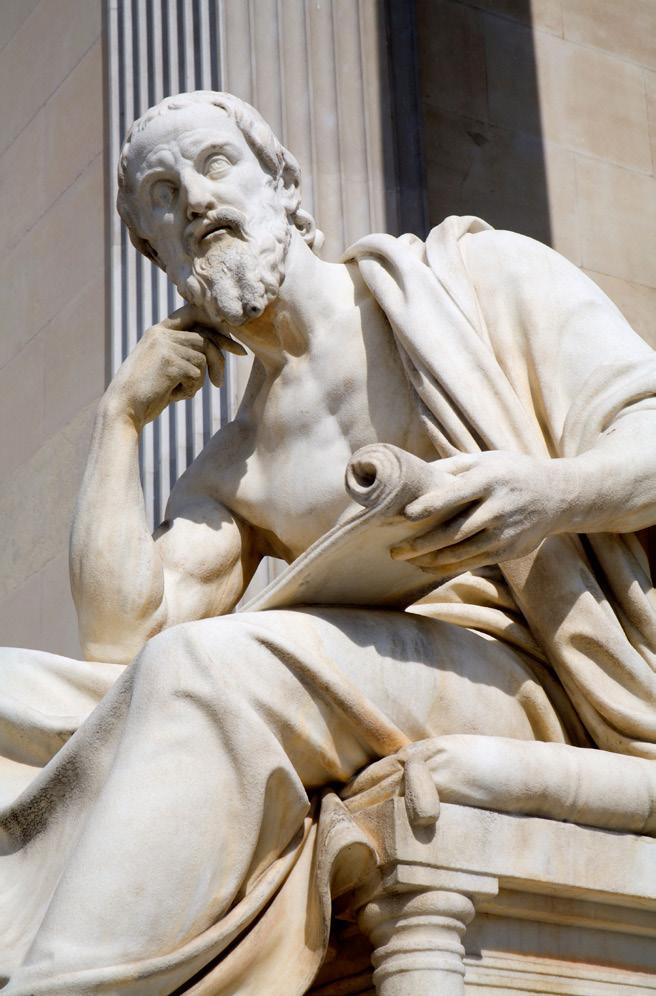
The Ancient Understanding of History History was a new type of writing in ancient times. Ancient historians were influenced by epic poetry. Epic poetry tells stories of a civilization’s myths and legendary heroes. So, history based on epic may com bine fiction and history and take on the character of storytelling. For example, it was not unusual for the historian to make up impressive speeches for historical people to say.
The main source for Persian history is the work of Herodotus (hih-RAHD-uh-tuhs), who lived from 485 to the 420s b.c.e. Herodotus was born in Asia Minor. This made him a Persian citizen. But he moved to Athens and wrote from a Greek point of view. Herodotus mainly traveled in Babylonia and Egypt to gather information, not in Parsa itself. His sources were mainly oral, and we know from other evidence that he made many mistakes.
Herodotus combined storytelling with anti-Persian bias. He used themes and told stories to demonstrate those themes. His themes include freedom versus slavery and democracy versus empire. The Greeks represented freedom and democracy, while the Persians represented slavery and empire. For all these reasons, his account is not entirely reliable.
3. The Rise of Ancient Persia
Ancient Persia came to be through thousands of years of development. At first, there were nomadic people who herded animals. These people later settled down and built cities and monuments across a wide region.
The Geography and Climate of Ancient Persia Geography often influences how states develop. Geographic features like rivers, lakes, mountains, and deserts are often used as borders that separate states and limit travel. Every state needs water for settlements and irrigation, and this may lead to migra tion. States that are landlocked, surrounded by land, often seek sea ports to launch ships. At one time or another, the Persian empires covered most of ancient Mesopotamia. The region had varied geography with mountain ranges, areas with plentiful access to water, and deserts.
The Zagros Mountains have been home to people for thousands of years. This village in Kurdistan Province, Iran shows how people have adapted to this environment. These mountains were important to the ancient Persians, creating a natural east-west division.

The main physical features in the territory in which the Persian empires developed were mountains and deserts. The Zagros Mountains run from the northeast corner of the Mediterranean Sea to near the Strait of Hormuz, creating a natural east–west division. The Elburz Mountains, between the Black Sea and the Caspian Sea, and the Hindu Kush, between the Elburz Mountains and the Indus River, border the land. These mountains divide the land of the empires from the steppes to the north. Between the Zagros and Hindu Kush mountains is the Great Salt Desert to the north and the Lut (LOOT) Desert to the south. The deserts lie with the centrally located Iranian Plateau.
Key bodies of water both bordered and lay within the land of the empires. Towards the west were the Mediterranean Sea and the Aegean (ih-JEE-uhn) Sea. To the south lay the Red Sea, the Persian Gulf, the Gulf of Oman (OH-mahn), and the Arabian Sea. Important bodies of water within the empires were, from west to east, the Nile River, the Black Sea, the Tigris and Euphrates Rivers, the Caspian Sea, and the Oxus (AHK-suhs), Jaxartes (jak-SAHR-teez), and Indus Rivers.
The climate varies by location, but is mostly dry, either arid, having little or no precipitation, or semi-arid, having only 10 to 20 inches of rain per year. The temperatures are moderate in places, but include extremes of heat and cold.
The Iranic Peoples The Iranic peoples had similar ethnic and language backgrounds and lived on the Iranian Plateau and Eurasian Steppes (STEHPS) in the first millennium b.c.e. A millennium is a period of a thousand years. The steppes are an area of Eurasia with dry grasslands and no forests. The Iranic peoples included those who came to be called Persians, as well as the Bactrians, the Medes (MEEDZ), the Parthians, and the Sogdians (SAHG-dee-uhnz). It seems that at least some of the Iranic peoples were pastoral nomads who moved with their flocks. At some point, the Persians moved southwest and mixed with Elamite society north of the Persian Gulf in Anshan (AHN-shahn).
In Anshan, they learned metalwork and acquired technology from the Elamites. And they came to hold posts in the Elamite royal court. It has been suggested that the Persians stepped in when the Elamite Kingdom weakened in the mid-7th century b.c.e. If this is the case, their close ties to Elamite society would help explain how they were able to do so.
steppes an ecoregion in Eurasia with dry grasslands and no forests
arid receiving little or no precipitation; dry semi-arid receiving only 10 to 20 inches of precipitation per year; mostly dry
Pictured here at dusk is the Gate of All Nations, or the Gate of Xerxes I. The entrance is guarded by two lamassu, or human-headed bulls with wings believed in ancient Mesopotamia to protect entry ways.
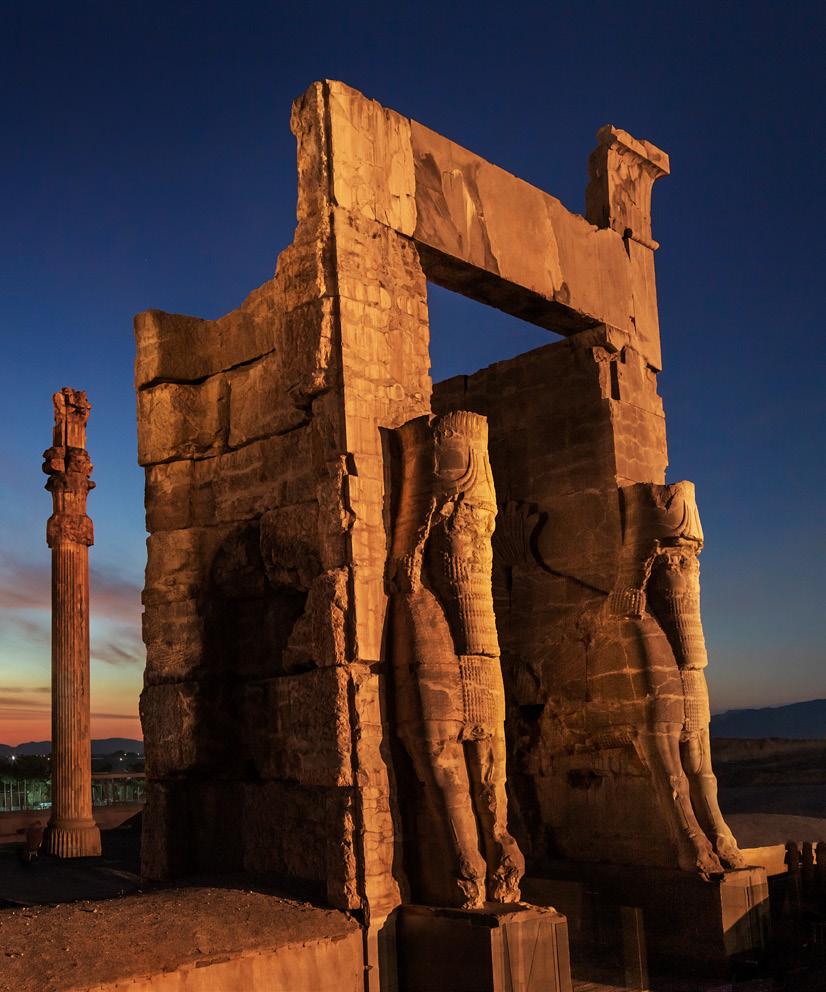
This relief at Persepolis, known as Parsa in Old Persian, shows a line of Greeks offering tribute of wool and beehives. The Achaemenid Empire expected tribute from subjects as it maintained peace and order.

Before the First Persian Empire
The Elamites had been a strong, but small kingdom. Anshan and Susa (SOO-zuh) were their two main cities. Elamite rulers called themselves “king of Anshan and Susa” from the second millennium b.c.e. In 691 b.c.e., the Elamites joined the Babylonians in fighting the Assyrians and continued to support the Babylonians when they revolted against Assyria. But the revolts did not succeed.
In 646, the Assyrian king Ashurbanipal sacked Susa, and the Elamite kingdom faded. One scholar suggests that this was when the Persians came to prominence. It is possible that this is when Cyrus the Great’s great-grandfather Teispes (TEYE-speez) took the title “king of Anshan,” claiming to be the successor to the Elamites. Whenever it happened exactly, by doing so, he formed the first Persian kingdom. It may also be at this time that Anshan became subject to the Medes.
There is much we do not know. But we do know that the Medes became more dominant. And we know it was the Medes, not the Elamites, who joined with the Neo-Babylonian kingdoms to finally defeat Assyria in 612–610 b.c.e.
The Achaemenid Empire Cyrus II, also called Cyrus the Great, was the first Persian to create an empire. By the time Cyrus II became king in about 559, the name of Anshan had been changed to Parsa. And the Near East looked different than when Assyria was the largest kingdom. The kingdoms competing for power in the 6th century included Media (MEE-dee-uh), Lydia (LIH-dee-uh), Babylonia, Elam, and Egypt. Cyrus II would come to conquer all of these kingdoms and places. Through his numerous wars, the Achaemenid Empire was established.
The Achaemenid Empire began with a period of conquest, which was continued by several kings after Cyrus. The early period also included revolts by subject states and alternating treaties and wars with the Greek city-states. In the middle period, it participated in the Peloponnesian Wars from across the Aegean, funding Sparta and helping them to win the war and further subject state rebellions. Scholars have suggested that it was Persian aid to Athens late in the Achaemenid period that drew the attention of Philip of Macedonia, who had conquered all the Greeks except Sparta. Philip ordered an attack on Asia Minor, which his son, Alexander the Great, built on, bringing the Achaemenid Empire to an end.
If Cyrus founded the Achaemenid Empire, why do we refer to Darius as the one who named it? Darius claimed Achaemenes as the ancestor of Cyrus II and himself. He traced his line back to Teispes (Cyrus II’s great-grandfather) and claimed that Achaemenes was the father of Teispes. Most modern scholars find no support for a claim of family connection, and believe Darius made it up.

This map shows the approximate borders of Alexander the Great’s short-lived empire.

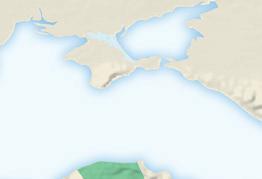

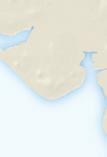

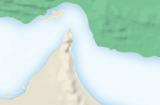













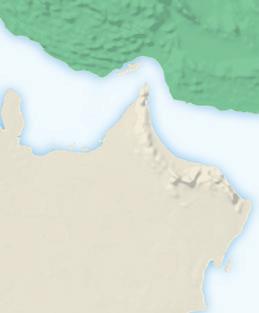
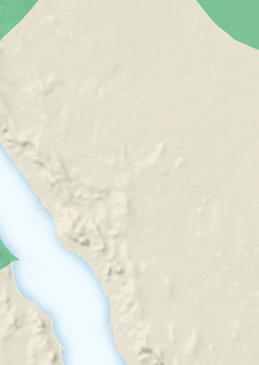
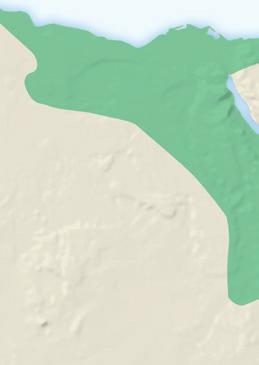



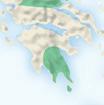
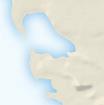
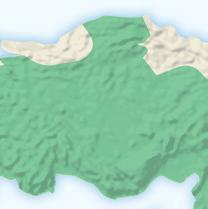
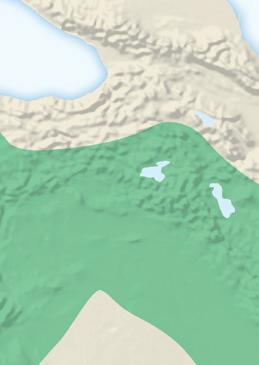

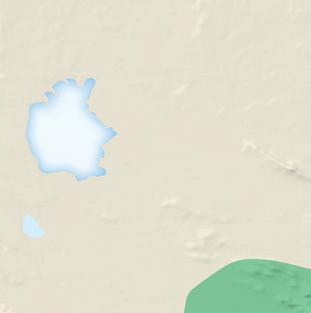
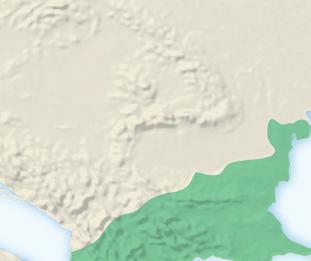
conspiracy a secret plan to commit a crime





The 12th Achaemenid king, Darius III, took the throne in 336 b.c.e., the same year Alexander the Great became king of Macedonia. Alexander’s father, Philip II, had ordered an attack on Asia Minor before his death. Alexander carried on with Philip’s plan. In 334 b.c.e., Alexander led an army of Greeks and Macedonians and defeated the Persians.
Most scholars believe that before Alexander could reach him, Darius III was assassinated by a relative, Bessus. It seems that Darius was killed by a conspiracy (kuhn-SPIHR-uh-see), or secret plan to commit a crime.

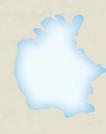






























Alexander ruled until his death in 323 b.c.e. Some scholars argue that Darius’s death marked the end of the Achaemenid Empire. They believe that Alexander’s empire represented something separate and different. Others consider Alexander to be the last of the Achaemenids.
The Seleukid Empire and the Hellenistic Kingdoms Alexander died only seven years after his conquest. Then there was a period of unrest. By about 312 b.c.e., the empire was split by some of Alexander’s generals and family members. General Seleukid, founder of the Seleukid dynasty, became ruler of much of the Achaemenid Empire, including Parsa. But much of what was ancient Persia was now ruled by others, such as the dynasty of Ptolemy in Egypt. The Seleukid Empire was eventually conquered by the Romans in 64 b.c.e.
This map shows the approximate borders of the Seleukid Empire in 260 b.c.e




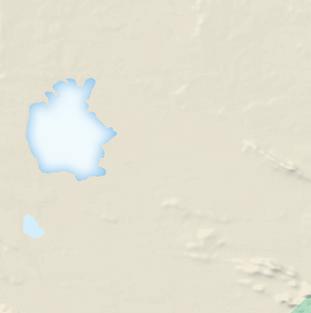
The Arsacid or Parthian Empire
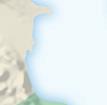



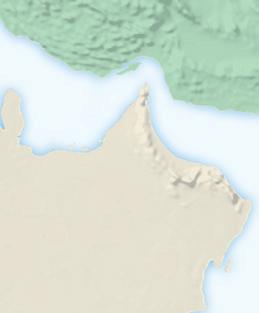

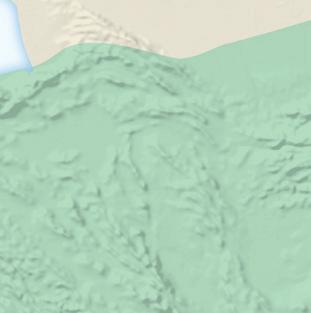
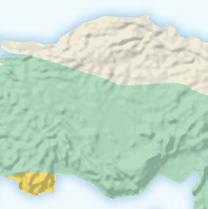

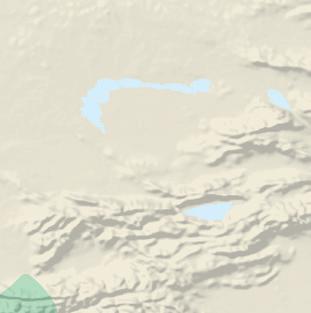

Sometime between 247 and 236 b.c.e., another dynasty rose among the Iranic peoples.


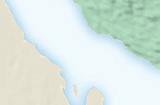









At the time, Parthia was a subject state of the Seleukids. Led by Arsaces, the Parthians revolted against the Seleukid. When they won, they were no longer subject to the Seleukid Empire, and Arsaces founded the Arsacid dynasty of Parthia as Arsaces I. He conquered one state after another, until he had recovered the central part of the earlier empires. At its height, the Arsacid Empire was bordered to the north by Armenia and by Yuezhi (Yueh-zhih) nomads, to the west by the Roman Empire, the south by the Arabs, and to the east by Hindu kingdoms.



The Arsacids may originally have been a nomadic people, but they settled into a sedentary life based on agriculture at this time and created a capital city at Nisa. Later, they built an empire and the king adopted the title “King of Kings.” During this time, Media and Babylonia were conquered and battles were fought with nomadic invaders. Finally, they fought wars with Rome.
Like the Achaemenid Empire, Arsacid rulers came from an Iranic group. Eventually, like all the empires that preceded it, it included the territory of Parsa. There was some memory of the Achaemenid Empire, but it’s not clear how much. We know that Arsaces changed his coins to be less like the Seleukid coins and more like Achaemenid coins. Scholars suggest that the Parthians combined some Hellenistic features with a return to Achaemenid ways of governing.
















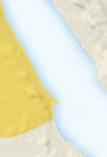















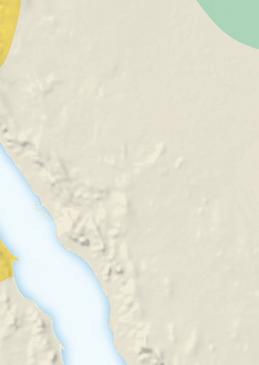





This map shows the approximate borders of the Arsacid Empire in the early 2nd century c e .
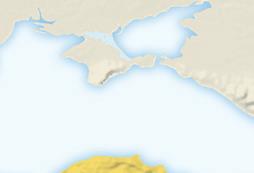
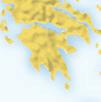

The Sasanian Empire

















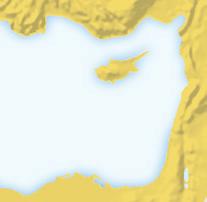











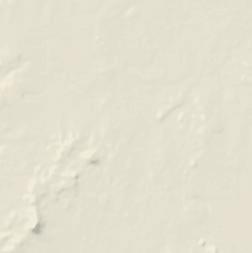


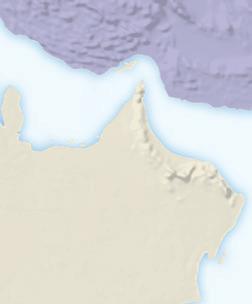
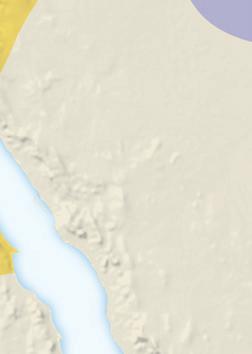
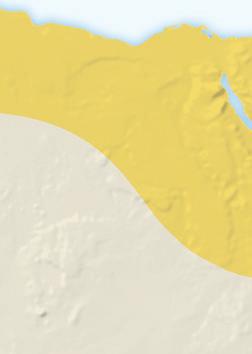


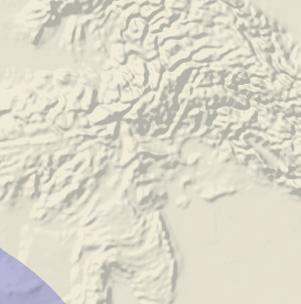



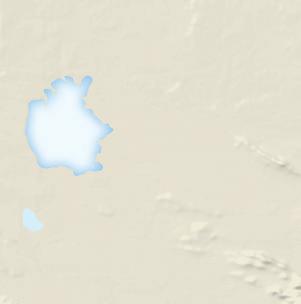


The Parthians ruled for more than 460 years. In the last years of their empire, a third dynasty arose from the Iranic peoples. This dynasty, the Sasanians, came from Parsa and rebelled against the Arsacid Empire. In 208 c.e., Ardashir I was crowned king in Parsa. He conquered territories along the Persian Gulf and in what is now western Iran. Ardashir defeated the Parthian army in 224 c.e., killed the last Parthian king, and was crowned in their capital city. He named the dynasty after an ancestor, Sasan.
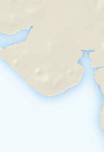
Ardashir viewed himself as a successor of the Arsacids. Since both the Arsacid Empire and the Achaemenid Empire relied on oral records, the history of both empires became mixed with myth and legend. Nevertheless, the Sasanians had some memories of the Achaemenid. They purposefully created simi larities in their royal inscriptions and placed reliefs at some of the same sites as the Achaemenids. However, there are no clear references to the Achaemenids in Sasanian records.


The Sasanian Empire lasted from 224 to 650 c.e. It was first characterized by the creation and expansion of the empire and war with Rome. The Romans and Sasanians frequently fought. This was partly because Rome wanted to prevent the Sasanians from having easy access to Constantinople via the Black Sea. During this time, Ardashir took the capital city of Ctesiphon in 226. The Euphrates formed a border with Rome, and Ardashir









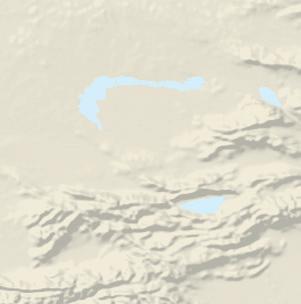
his attention there.









This map shows the approximate borders of the Sasanian Empire in the middle of the 3rd century c e .


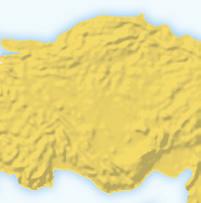
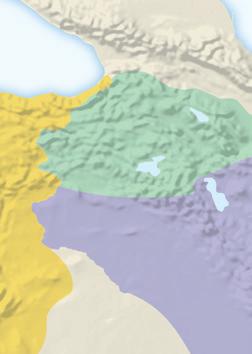

Ardashir’s grandson, Bahram I, became king in 273. During his reign, Zoroastrianism became a state religion. Later in this period, the king came under control of the nobility, which resulted in problems with the succession.
















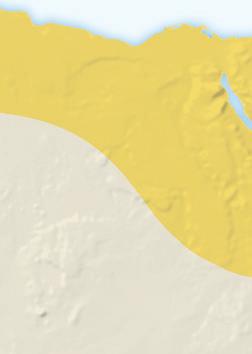


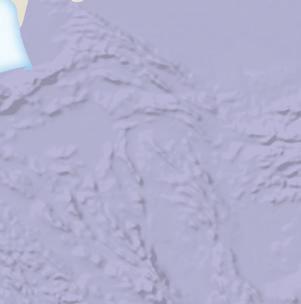



In fact, the reign of Kosrow I is considered by some scholars as the high point of the empire. He made social reforms and supported arts and sciences, thereby preserving knowledge and literature in writing. Fighting with Rome, now the Byzantine Empire, continued off and on through the years.





By the 630s, while Sasanian attention had been on Rome, the Arabs to the south had taken control of the Arabian Peninsula and Syria. In 636 c.e., they took Babylon and defeated the Sasanian army. They then took the capital, Ctesiphon. By 654 c.e., the Arabs controlled the territory.


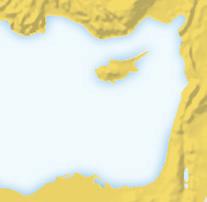






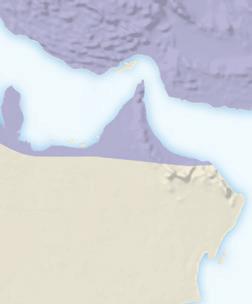











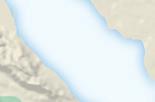










Ancient Persia was defined by the divisions of its empire, its many languages, and how rulers administered it.


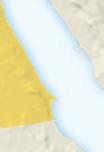
Challenges of Ruling Ancient Persia Persian kingship faced difficulties. Of the 13 Achaemenid kings, three were usurpers and six were assassinated. Of the 32 Arsacid kings, 10 ruled for six years or fewer. At the end of the Sasanian Empire, there were eight kings in five years. Although the kingship was unstable, the administration remained steady.

diverse having a great deal of variety
satrap ruler of the “countries” of ancient Persia, who answered to the king
An Achaemenid model of a horsedrawn chariot drawn by four horses. What kinds of problems do you think the ruler of a large empire with limited transportation would encounter?
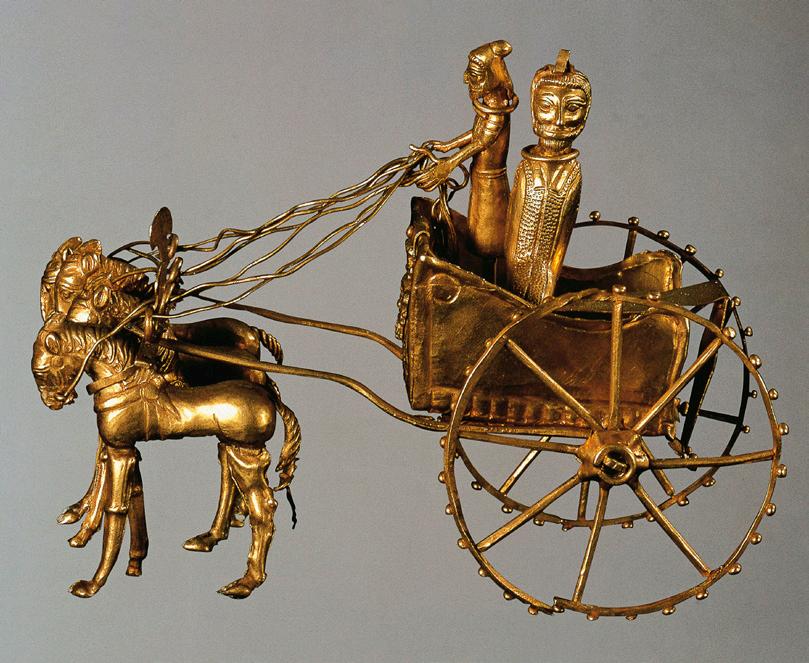
Challenges of Administration
The size of the empire made good administration essential. The distance across the Achaemenid Empire from southwest to northeast was more than 3,500 miles (2,175 km). Even though the later empires were smaller, they were still large enough to make travel challenging.
Land transportation was limited. Travelers had a choice of walking or running, riding horses or onagers (a species of the horse family), or being pulled in horse-drawn carts. With rela tively slow forms of transportation, there was no way for the king to oversee the entire empire without a reliable administration.
In addition, during the Achaemenid Empire, Persians wrote texts in many languages including Old Persian, Elamite, Official Aramaic, Egyptian, and Babylonian. Outsiders wrote about Persia in Greek, Latin, Hebrew, and other languages. How could a Persian king rule such a widespread and diverse population?
“Satraps” and “Countries” Satrap comes from a Persian word that means “protecting the kingdom.” The satraps were rulers under the king, and the areas they ruled were called by the Persian word for country (the Greeks called them satrapies). Most satraps were Persian nobles, though some came from the country they ruled. All were responsible for collecting taxes and tribute and delivering them to the king. They were required to send soldiers when the king made war. Not all the areas of Persia were controlled by satraps. There were also local dynasties and kings left in place by the rulers of ancient Persia.
Cyrus II and his son Cambyses started the satrap system. Darius further developed the system. Under Darius’s system, while cultural freedom was still allowed, all except the Persians had to pay tribute to the king. And all without exception had to both carry out the orders of the king and obey the law.
The Seleukids maintained the satrap system, although lesser kings ruled some territories. The Arsacid Empire kept these kings as long as they agreed to act on behalf of the Arsacids. And they not only had satraps, but also a “satrap of satraps.” However, this title is known only from an inscription.
The view of the empire changed with the Sasanians, who invented the concept of Eranshahr, the “Empire of the Aryans.” They saw their territory as consisting of Iran and areas beyond Iran. Sasanian kings kept the satrap–king organization that was in place in the Arsacid period. They replaced kings with relatives of the king of kings.
Staying in Touch One part of the solution rested in having the ruler move from place to place rather than having one set capital. The king ruled from one of several capital cities, traveling with his court when he moved. But how did the administration communicate efficiently with the various countries, which are generally numbered at 20 or more?
The Persians had a communication system called pirradzis, the mounted messenger service. The king communicated with the various countries by letter. The system used a combination of couriers on horseback and runners. The road was marked with milestones, was guarded, and had inns at intervals for travelers. And it made relatively fast, reliable communication across the vast empire possible.
Herodotus and others were impressed with the Persian postal service. His words about the Persian messengers are an ongoing inspiration for the U.S. Postal Service. An adapted version of his praise appears on the James Farley Post Office Building in New York City. It says, “Neither snow nor rain nor heat nor gloom of night stays these couriers from the swift completion of their appointed rounds.”
Communicating with a Diverse Population Kings of earlier empires, like Assyria and Babylon, created royal inscrip tions in their own language only. Cyrus changed that. In 539 b.c.e., he wrote to the Babylonians in their own language and style of royal inscription. Using languages that could be understood by their subjects was more than just a nice gesture. It provided the possibility of getting the royal message out to more people. It allowed for rhetoric (REH-tuh-rihk), the use of language to persuade people.
In the Cyrus Cylinder, Cyrus tells the story of his conquest of Babylon from a perspective Babylonians would understand.
[The Babylonian god Marduk] ordered [Cyrus] to go to Babylon. . . . Without battle and fighting he let him enter his city Babylon. [Cyrus] saved Babylon from its oppres sion. . . . All the people of Babylon . . . knelt before him, kissed his feet, rejoiced at his kingship. . . (lines 15–18)
By showing that he honors their god Marduk (MAHR-dook) and claiming to act on Marduk’s behalf, Cyrus claims the right to rule in Babylonian terms.
The words on the U.S. Post Office in New York City echo Herodotus’s praise of the Persian messenger service called pirradzis.
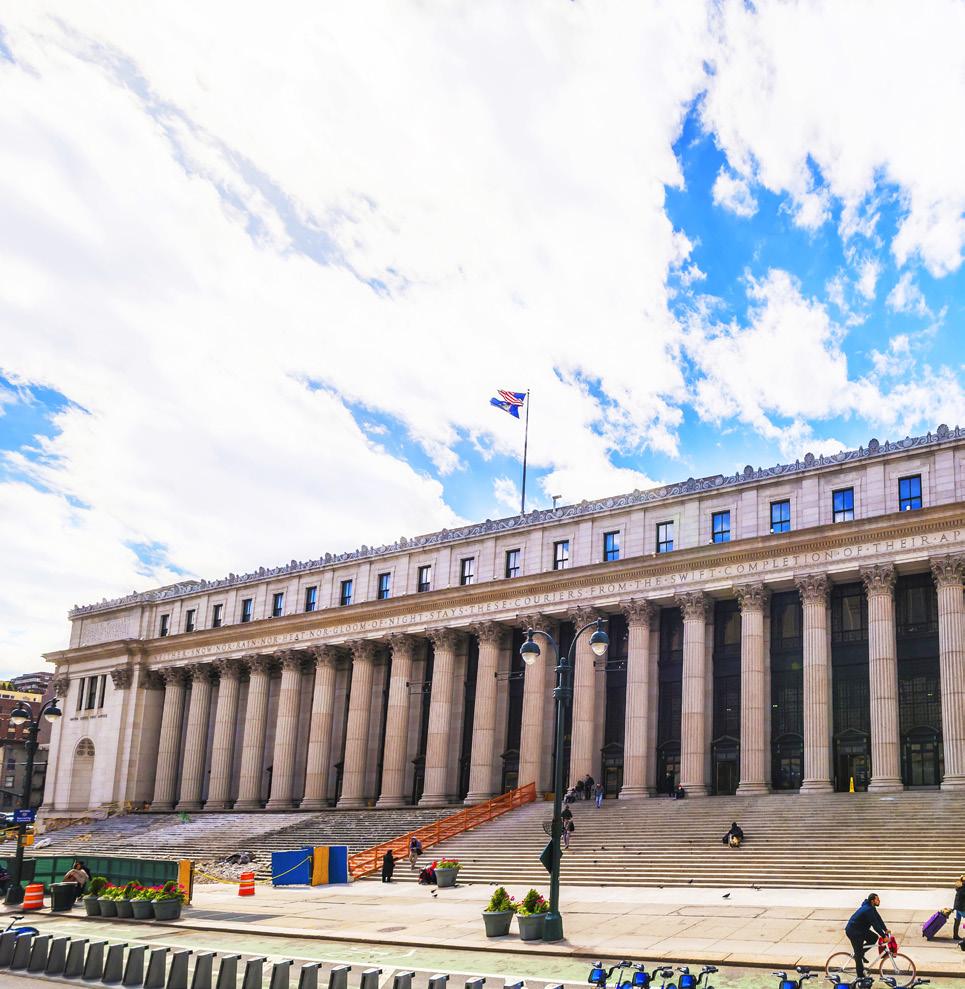
Zoroastrianism was the main religion of ancient Persian empires for a thousand years, though other religions were tolerated until the Sasanian period. Pictured here is Chak Chak Fire Temple in Yazd, Iran. Fire and water play a role in Zoroastrian belief and rituals.

Attitude Toward the Conquered Under Cyrus and the Achaemenids, there was a balance between the authority of the rulers and the autonomy, or independence, of the subjects. Local groups practiced their customs and were not forced into a uniform culture. Subjects were also allowed self-government.
In the Cyrus Cylinder, Cyrus says that he sent exiles in Babylon back to their homes. For example, he is believed to be responsible for the return of Jewish exiles to their homeland. Additionally, early Achaemenid kings involved Jews in their courts and administration. This included Ezra and Nehemiah, Jewish authors of books of the Tanakh, or Hebrew Bible. According to Ezra and Nehemiah, the Achaemenid kings sup ported rebuilding the Temple and the walls of Jerusalem.
The openness of the Achaemenid rulers to diversity was different from the conformity required by democratic Athens, in which non-Athenians could not take part in the government. The Achaemenids recognized the many languages that made up the empire. And they allowed for and supported diversity of religions.
tolerance allowing the practice of religions or cultures other than one’s own
When the Sasanians made Zoroastrianism a state religion, the attitude toward those who did not practice changed from the tolerance of the earlier empires. The Sasanian high-priest Kerdir claimed to have “struck down” those who did not worship Ahura Mazda, the Zoroastrian chief god. His list of those struck includes Jews, Buddhists, Hindus, Christians, and others.
A Multi-Language Society Achaemenid rulers after Cyrus continued to use multiple languages in royal inscriptions. At the same time, Aramaic came to be used as a lingua franca, a language shared by people who have different native languages. This helped hold the society together. National languages were used in countries where Aramaic was not spoken. Elamite was used for administration. Other languages were used, as appropriate. In royal inscriptions near Darius’s canal to link the Mediterranean and the Red Sea, Egyptian is included.
Arsacid coins show a mix of influences, chiefly Greek writing with images based on Achaemenid art. However, Parthian was the language of the court and the administration.
Beginning with Ardashir, Sasanian coins replaced Greek with Middle Persian. They created inscriptions in three languages, like the Achaemenids. But the languages they used were Parthian, Middle Persian, and Greek. Middle Persian served as the lingua franca of the Sasanian Empire.
You have learned about the empires of ancient Persia and how we know about them. The area known as Persia was ruled by five empires over more than a thousand years of history.
The Meaning of “Ancient Persian History” Ancient Persia refers to empires that existed in the period from 550 b.c.e to 650 c.e. The founders of the Persian empires were members of one of the tribes of Iranic peoples.
Challenges of Studying Ancient Persia Ancient Persians mainly relied on oral history, and that record has been lost. With existing artifacts as well as new finds and more texts, the information we have is constantly changing. By relying on ancient Persian accounts as well as looking care fully at accounts by Greeks like Herodotus, we gain a better understanding.
The Rise of Ancient Persia In a mostly landlocked region of mountains and deserts, early Iranic peoples relied on freshwater lakes and rivers to build up settlements after a nomadic existence. They learned from people like the Elamites. Later, three different Persian empires called the Achaemenid, Arsacid, and Sasanian Empires would rule ancient Persia through most of its history.
The Administration of Ancient Persia The Persian empires were ruled by kings. The “countries” of ancient Persia were ruled by satraps and sub-kings who answered to the “king of kings.” For most of the period from 550 b.c.e. to 650 c.e., the countries were allowed to practice their own religions and cultures. The Persians built roads, established a postal service, and used multiple languages to communicate across the empire.
Pictured here is Naqsh-e Rostam, an ancient Persian necropolis, or burial site. It was used during the Achaemenid and Sasanian periods.
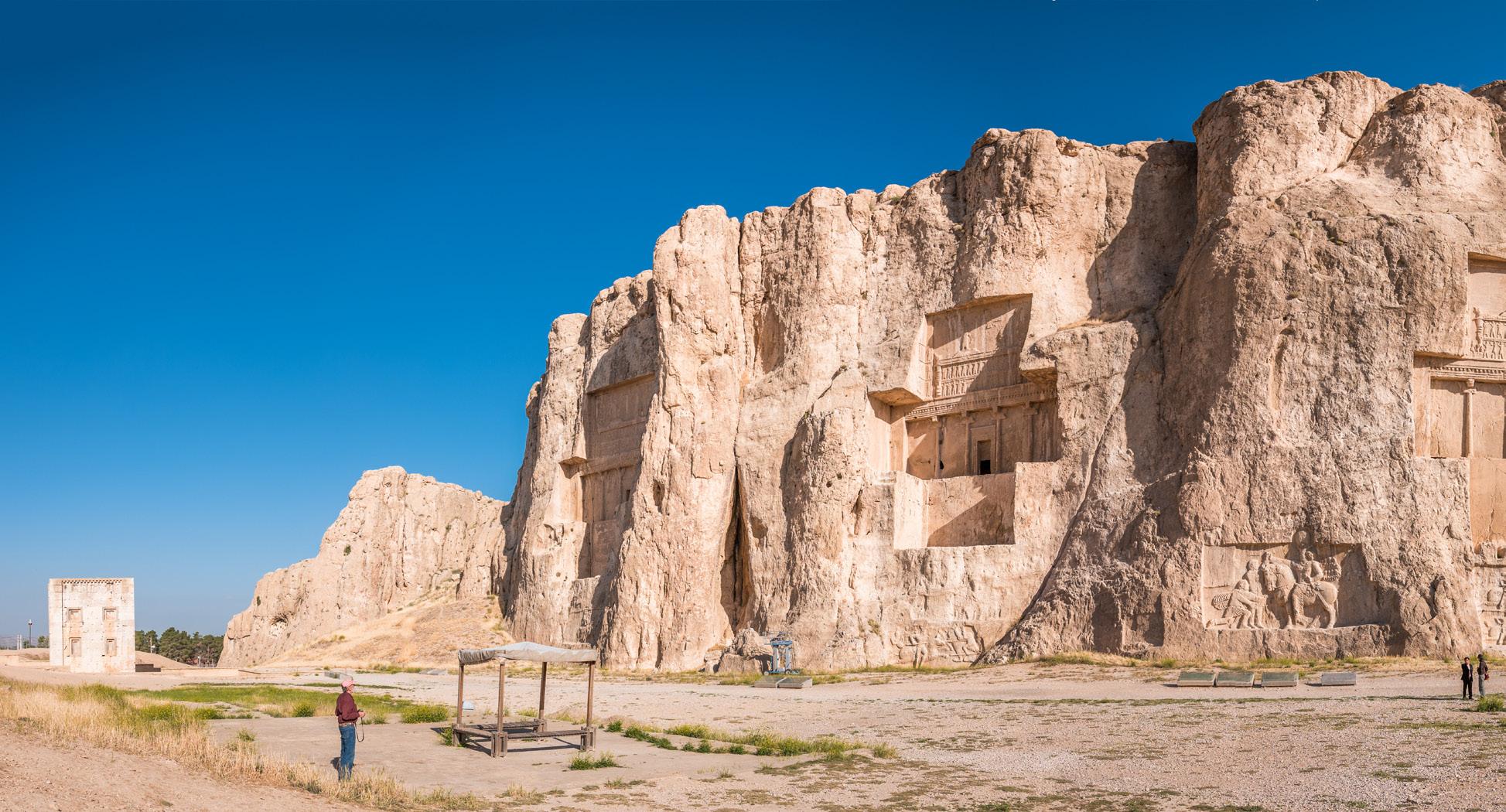
Classroom
Activity
about the achievements
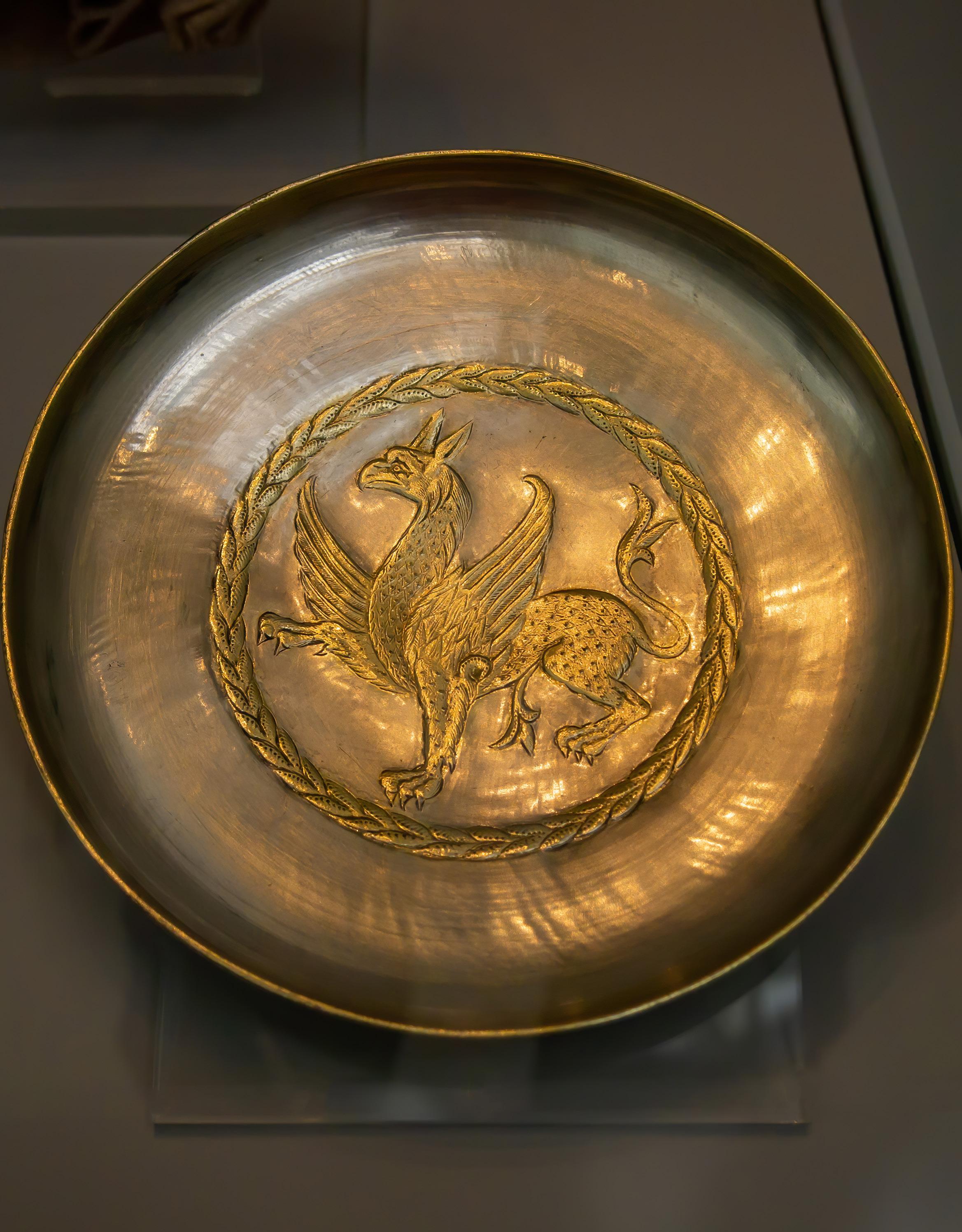
ancient Persia
social structure,
a video
an online activity to show what you’ve learned.
the main ideas
and Notes
you complete the reading,
print notebook to make sense of
to questions in your online
The ruins of Persepolis, or Parsa, tell a story of ancient kings and their subjects. Persia’s might and power are on full display in the reliefs and carvings, leaving us with images of a distant time and place that we still struggle to understand today. However, there is more than just mystery when it comes to ancient Persia.
Most often, tolerance and diversity were practiced, though Persian kings made their fair share of conquests. Traders made their paths across the mountains and dusty plains of present-day Iran and into places like Egypt and present-day Turkey. Persian styles influenced the Greeks, and their war technology and methods were adopted as far away as China.
Even today, the legacy of ancient Persia lives on in new ways. To reach different cultures within a country, governments regularly use multiple languages to make sure as many people as possible understand important documents. Water systems across the world utilize Persian techniques like special underground channels. And Persian forms of art and reliefs with important information survive into the present.
Persians left their mark on ancient and modern societies. Different dynasties of rulers managed a vast territory using a number of different methods. In this lesson, we will look at how ancient Persian economy, society, culture, technology, and arts influenced the world around them.
Persian culture produced a number of long-lasting works. This plate from the Sasanian Empire shows a simurgh, a type of giant mythical bird believed to make land and waters healthy and clean.
Social Studies Vocabulary castes hereditary pantheon Parthian shot qanat syncretism
In what ways did ancient Persians influence the world around them?
This image shows a portion of the Achaemenid royal road (Rah-e Shahi) in Sardis.
The ancient Persian economy was highly developed and con nected land routes from all over. Persia’s postal service depended on this network of pathways throughout the empire, linking the major cities. Only well-maintained roads could handle the con tinual passage of messengers whose work was sometimes urgent.
The Roads of Ancient Persia The roads held the large, diverse empires together. Roads were essential for the messenger service that connected the king with his satraps. But they were necessary for other reasons as well. They were critical for moving food from fields to communities and military units to battle fields. They were also used for travel and trade.
There were originally two kinds of roads in ancient Persia: steppe roads and royal roads. Pastoral nomads developed the steppe roads. These roads were the earliest connections across the Eurasian steppe. Official empires built the royal roads. These roads were used for official empire business.
Royal roads were built to connect the key cities of the empires. These cities included capital cities and cities where treasuries were installed. Evidence confirms that roads also ran to all the countries in the Achaemenid Empire, as well as Bactria and India. The roads were used during all the empires.

The royal road system grew out of roads of previous empires and were maintained—though not necessarily paved—so that they could carry chariots. Chariots traveled the roads for govern ment business, but also for military expeditions, and travel.
Roadwork included several types of activities. Road building was needed to add new roads to the system. In addition, the royal roads were guarded both for security and to ensure maintenance was done as needed, for example, in wet weather or when the road crossed swampy land. Road engineers built bridges to cross rivers.
However, wildlife could interfere with safe passage on the roads. According to the Roman historian Aelian, “from Persian Susa to Media, there is such a mass of scorpions that, when the Persian king is going to be passing that way, he gives orders three days in advance that they be chased away, and he presents gifts to him who has caught the greatest number.”
Over time, there was a shift from wheeled vehicles to camels. After the Achaemenid Empire, camel caravans replaced chariots and carts. As a result, the roads were no longer improved. Pack caravans of camels played an important part in Arsacid trade with China.
One of the key uses of the royal roads was to bring tribute from all the empire to the royal treasuries. Libya paid tribute in chariots and goats, while tribute from neighboring Egypt consisted of silver, bulls, and cloth. Sindh paid tribute in gold dust, axes, and weapons. But Aria paid in camels, lionskin cloaks, and vessels, while tribute from Cappadocia included silver, clothing, and horses.
The Silk Road Scholars once thought that the silk roads, or trade routes connecting East and West, opened when the Han Emperor Wu sent his ambassador Zhang Qian (jahng chee-ehn) westward in 115 or 105 b.c.e., during the Arsacid Empire. They thought of the roads as a network connecting major civilizations, like Rome, Persia, China, Greece, and India. They believed that silk was the main product traded across this route and that China was the only source of silk until the middle of the 6th century c.e.
With new evidence, we now know that silk roads were operational possibly since the 6th millennium b.c.e. The steppe roads developed by the pastoral nomads that ran along the edges of the steppes and deserts had multiple roles, including connecting settlements. The silk roads were not limited to the transport of silk, nor was silk their only important product. Jade was also transported frequently. Other key products on the silk roads included ceramics, glass, precious metals, gems, and cattle.
Scorpions (left) are related to spiders, mites, and ticks. They have stingers on the ends of their tails that contain a toxin. Though most types of scorpions are harmless, a few dozen are deadly. The camels (right) native to the Persian Empire and used during the Achaemenid and Arsacid period were Bactrian camels, which have two humps. Dromedaries, or one-hump camels, were introduced during the Sasanian period.


This Chinese jade was made about 100 b c e , during the Han dynasty.

This statue of Darius I was made in Egypt and later brought to Susa. It is now displayed in Tehran at the National Museum. It is not known how it lost its head.

Much of the system was created and first used by pastoral nomads, whose goods—hides, bark, furs, horses, livestock, falcons, and walrus tusks—formed part of the trade complex. The sections of the trade roads were used piecemeal, not necessarily completely from end-to-end.
Merchants of the Arsacid, or Parthian, Empire served as middlemen in trading between East and West. This means they bought from producers and sold to consumers. For example, these Persian merchants were involved in the trading of seasonings, spices, and precious stones from India and furs from Russia.
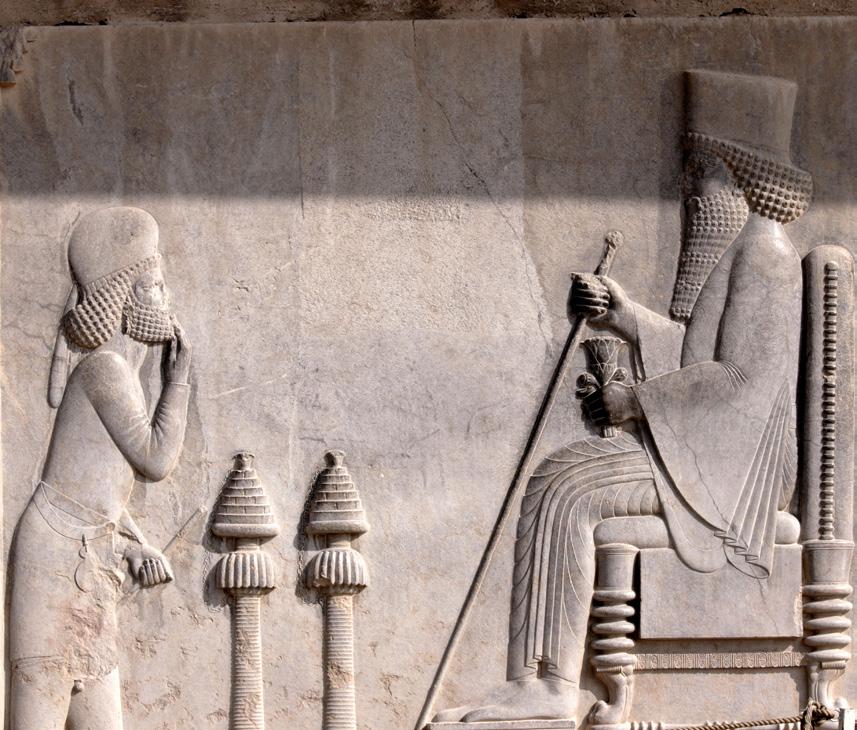
Incense burners, such as that shown in a relief from Persepolis, 6th century b.c.e. (left), may have inspired Chinese incense burners, such as this 2nd century b.c.e . example (right).
The countries of the Persian empires offered a wealth of products for sale, both internally and externally. During the Achaemenid Empire, internal trade included items such as iron and silver from Asia Minor; dyes, copper, tin, and woolen clothing from Babylonia; limestone from beside the Tigris, alum (used for glassmaking, medicine, and dyeing wool) from Egypt and Syria; gold, ivory, and ebony from Egypt; and glassware and cedarwood from Phoenicia. Mirrors and vases were also made and traded within the empire. External trade from the Achaemenid Empire included lapis lazuli from Bactria and Sogdiana, and turquoise from Chorasmia. There is also evidence of trade with southern Siberia. During the Sasanian Empire, Persian silver products were highly valued. Sasanian silver has been found from Africa to Sri Lanka and from Russia to Turfan in Chinese Turkestan.
Exchanges Beyond Trade We know from artwork that people adopted the culture and religion of others. For example, scholars have proposed that a specific type of Chinese incense burner called the hill censer was influenced by similar Achaemenid censers. Here, you can see a stone relief from Persepolis. The two structures rising from the bottom are Persian incense burners. The censers have three parts: the stem, the bowl for incense, and a cover shaped like a cone. The adjacent photograph shows a bronze Chinese censer from the Han dynasty. Although the three parts have been developed using Chinese concepts, they can still be identified.

Ancient Persian society had a basic hierarchy that divided society into several groups. Ancient Persians interacted with a wide variety of people both within the borders of their empire and outside of it. This created different kinds of relationships between groups.
Two Ways to Rule an Empire Empires combine more than one state. Because of this, they are, by definition, diverse societies, com bining people of different cultures, backgrounds, and beliefs.
Persian rulers could approach a diverse society in two ways. One approach was to embrace the diversity. This is the approach Cyrus and most of those who followed him took. The other approach was to remove the diversity by making (or trying to make) everyone the same. For example, rulers could make laws that required people to follow the same religion. This approach was tried during the Sasanian Empire when Zoroastrianism became the state religion.
During the Achaemenid Empire, Cyrus entered Babylon as a conqueror. However, he supported the Babylonian people’s worship of Marduk and presented himself as Marduk’s avenger. He helped restore Marduk’s special temple.
One scholar summarizes the Achaemenid kings’ approach by saying that they needed two things. The ethnic Persians were greatly outnumbered. So, they needed to control subject states to both prevent and, if necessary, put down revolts. They also needed to provide an atmosphere that would enable cooperation. To do this, the Persians did not arrive in subject states with the intention of overthrowing the culture. Instead, they supported and used local traditions, protected local places of worship, and encouraged local rulers to become part of the satrap system.
In this relief sculpture from Persepolis, an Achaemenid Persian warrior rides in a horsedrawn chariot.
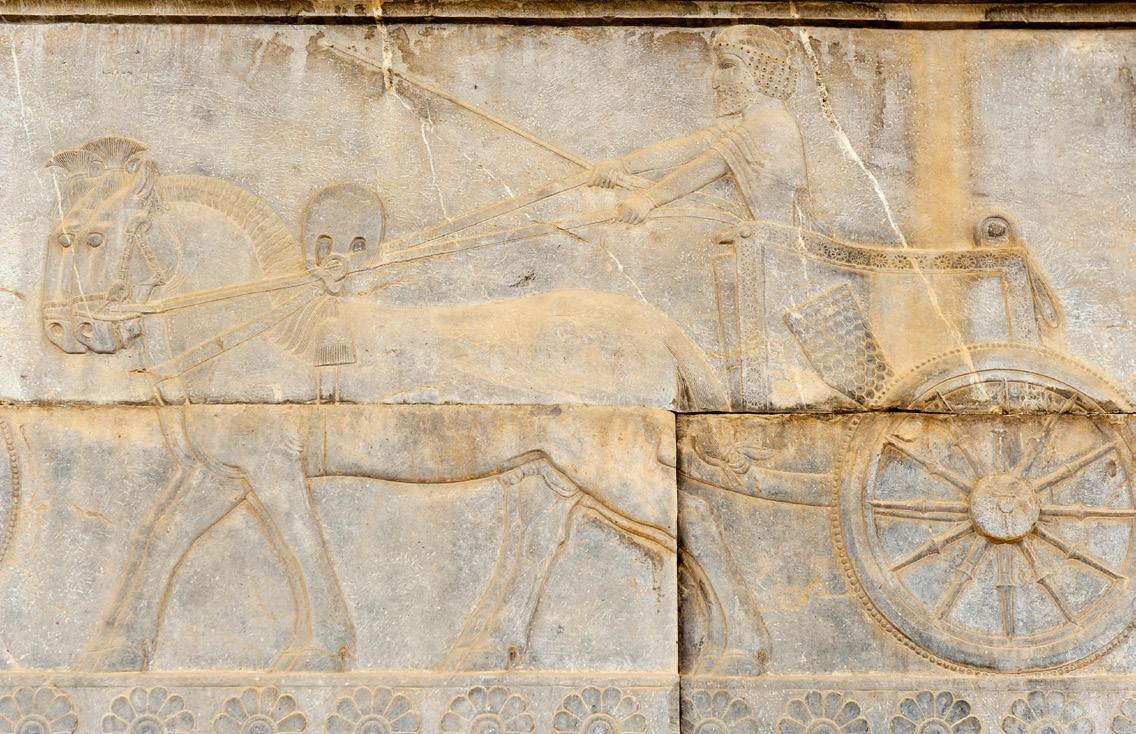
This horned dragon is a symbol of Marduk, whose servant Cyrus claims to be.

A Diverse Society
Ancient Persian rulers, for the most part, followed Cyrus’s lead and embraced the diversity of their culture. Some of the kings had Greek and Egyptian physicians at court. Workers from many cultures, from soldiers to silversmiths to masons to woodworkers were employed by the kings. That is, people did not stay in their own subject state, but moved freely around the empire.
castes divisions of society that are kept strictly separate and treated differently
hereditary passed along from parent to child
In this section of the relief from Persepolis, a Median magus (priest) carries a lamb to present to the king.

Classes in Ancient Persia
Social class in ancient Persia is not clear until we reach the Sasanian Empire. In the Achaemenid Empire, some scholars supposed that the divisions would have followed the divisions that existed prior to the empire. In this view, citizens were priests, warriors, and farmers. The work of priests and warriors, who were considered equal, made it possible for farmers to grow food. The king, as leader of all, was considered “first priest first warrior, and first farmer.”
Change came during the Sasanian Empire. King Bahram I and the high priest Kerdir made Zoroastrianism a state religion in the 270s c.e. This ended the practice of religious tolerance and led to a strict division of society into four parts. These castes included priests, nobles, peasants, and artisans. The first two classes were considered elite, and the peasants and artisans were required to support them. In the Sasanian Empire, membership in estates was hereditary.
In all the empires, some people had privileges that separated them from everyone else. Nobles might be given land and gifts by the king. They might receive an education, which was only available to a few. And they might be made a satrap. There may have been classes of nobles.
In the Achaemenid Empire, another division was between the kurtash (KUR-tahsh) who worked for the government of the empire and everyone else. The kurtash were mainly from subject states, but some were Persians. They came from many places— including Babylon, Egypt, Ionia, Lycia, and Lydia—and were paid to work on projects for the king. It is through the records of the payments in the Persepolis Tablets that we know of them.
Another way to divide classes was based on citizenship within subject states in parts of the region controlled by the Achaemenid Empire. Nobles, administrators, priests, scribes, artisans, and farmers were among the full citizens. People who were free but had fewer rights included foreign workers, like the kurtash, because they did not own land. Tenant farmers were technically free, but worked someone else’s land for their living, and this made them only partially free. Enslaved people were treated like property. They did a range of tasks, including both household work and field labor. Some were skilled craftsmen. In at least some areas of the empire, they could own property and marry. On occasion, enslaved people were set free. Some were adopted by someone who was free.
King or God? In the Achaemenid Empire, the king was viewed as having a special relationship with the gods, but not a god himself. In the Arsacid Empire, however, there were multiple attempts to portray the kings as gods. Some scholars think the Sasanian kings viewed themselves as gods. Others think the Sasanian king was not considered a god, but a special creation of Ahura Mazda with a key role in the balance of the world.
The Arsacids imitated Seleukid coins like that of King Antiochus

Women in Persian Society
During the Achaemenid Empire, the situation of women depended on where in the empires they lived. In Babylon, a woman could own property and be party to a contract. In Egypt, a woman could both own property and will it to her children. She also had the right to file for divorce from her husband. Jewish colonists in the Egyptian city of Elephantine had even greater rights, essentially like a man’s. Whether single or married, she could own property and sell it, if she chose. She could divorce her husband. But in none of these places could a woman act as a witness to a contract. From the Persepolis Fortification Tablets, we know that women were not necessarily paid less or given fewer rations than men. We also know that women could be “heads,” which may mean they were supervisors, and with this position, could receive meat as part of their pay. Payment in meat was rare overall for both men and women.
Because of the limitations of the sources, we only know about royal women in the Arsacid Empire, and not much at that. Like women during the other Persian empires and in other times and places, the marriages of royal women, like the princess in this image, were designed to create political alliances.
In the Sasanian Empire, there were empire-wide laws that affected women. When a woman married, she gave up legal ties to her birth family and came under control of the male leader of her husband’s family. Her children inherited not only their father’s goods and social rank, but also his obligations. She could not own property unless the marriage contract specifically allowed it, except for her dowry, which stayed her property. Both husband and wife could ask for a divorce, but both had to agree.
IV. The Greek words say, “Of King Antiochus, the god manifest [made visible], the victory bringer,” showing that he is presenting himself as a deity.
This statue in present-day Iran shows a princess of Hatra in Arsacid, or Parthian, dress.
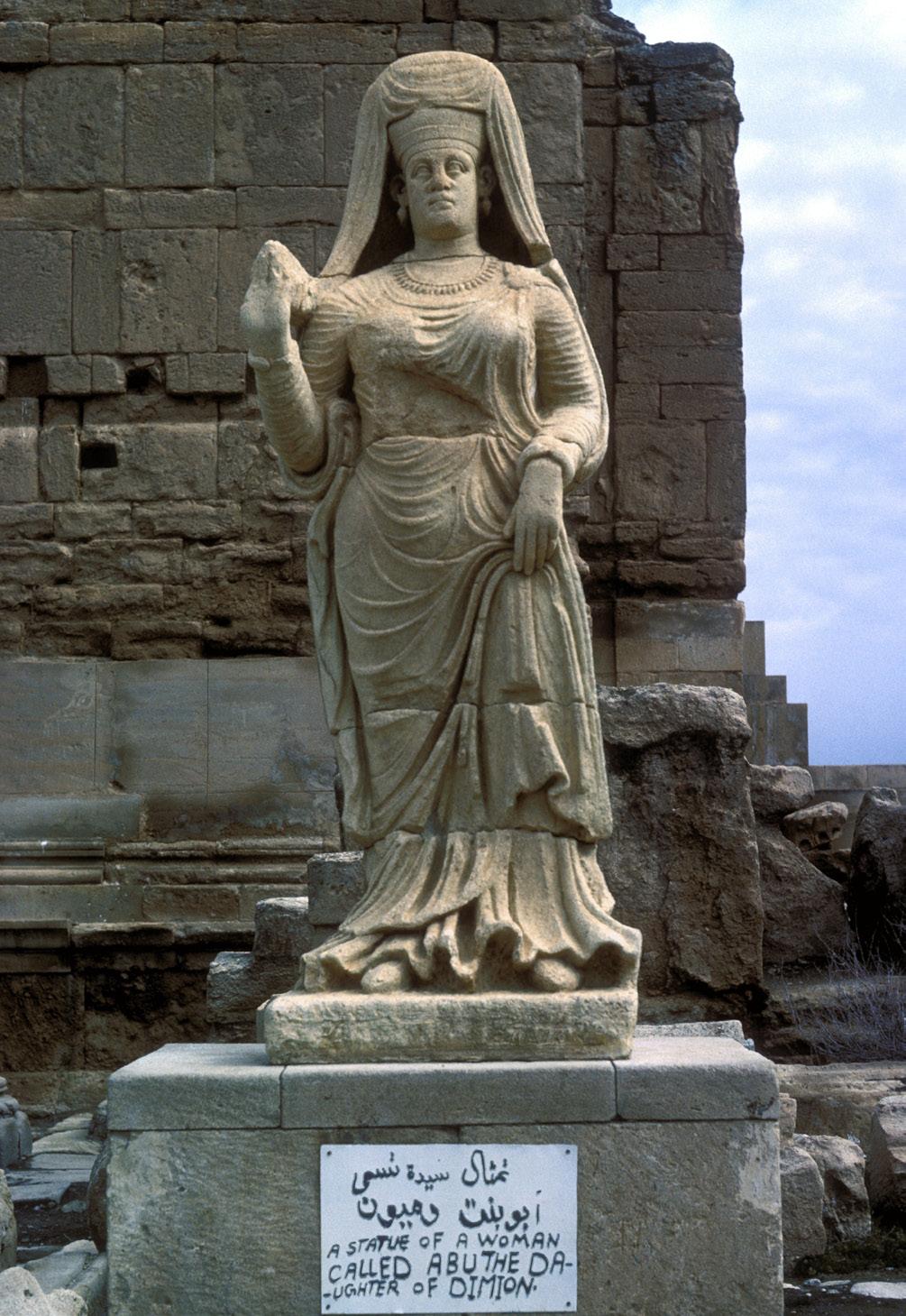
This is an artist’s idea of the world as conceived by those who practiced the ancient Iranian religion.
Another key element of life in ancient Persia was religion. Although there is limited information with different ideas about ancient Persian religion, we do have clues.
The set of beliefs initially held by Iranic peoples is sometimes called ancient Iranian religion. It arose in the 3rd millennium b.c.e. in Central Asia. In this religion, the pantheon is led by Ahura Mazda, lord of the universe. But Ahura Mazda did not make the universe. The demiurge, or world creator, had created it. Two other important gods are Mithra, the god of contracts, who expects people to honor their promises, and Anahita (ANN-uh-hee-tuh), the goddess who grants victory to the legitimate ruler.
Ancient Iranian religion taught that the world has three levels: Earth, atmosphere, and heaven. Parsa was on a central continent, surrounded by six other continents. At Earth’s center was a mountain. On the south side was a sea, where the tree of life grew. Below the earth was infinite, or endless, darkness. The spring new year was the most important holiday. Only a priest could perform rituals, which included food and drink offerings.
One ancient Iranian priest was named Zarathustra (zahr-uh-THOO-struh). He lived sometime between the 13th and 6th centuries b.c.e. Zarathustra was a high priest and a poet, and he was believed to receive visions from Ahura Mazda.
Zarathustra’s visions led him to a new understanding of ancient Iranian religion. He believed Ahura Mazda to be the supreme god, not just one of the pantheon. He saw a strong separation of truth and falsehood, which is also called the lie. And he believed that people followed one or the other, truth or the lie. He said that the bodies of the dead shouldn’t be embalmed, a process that preserved them. In addition, Zarathustra is considered by some scholars to be the first person ever to set down a belief in an afterlife in heaven for good people and an afterlife in hell for bad people.
Twin Sasanian fire altars at an open-air site at Naqsh-e Rostam, near Persepolis.
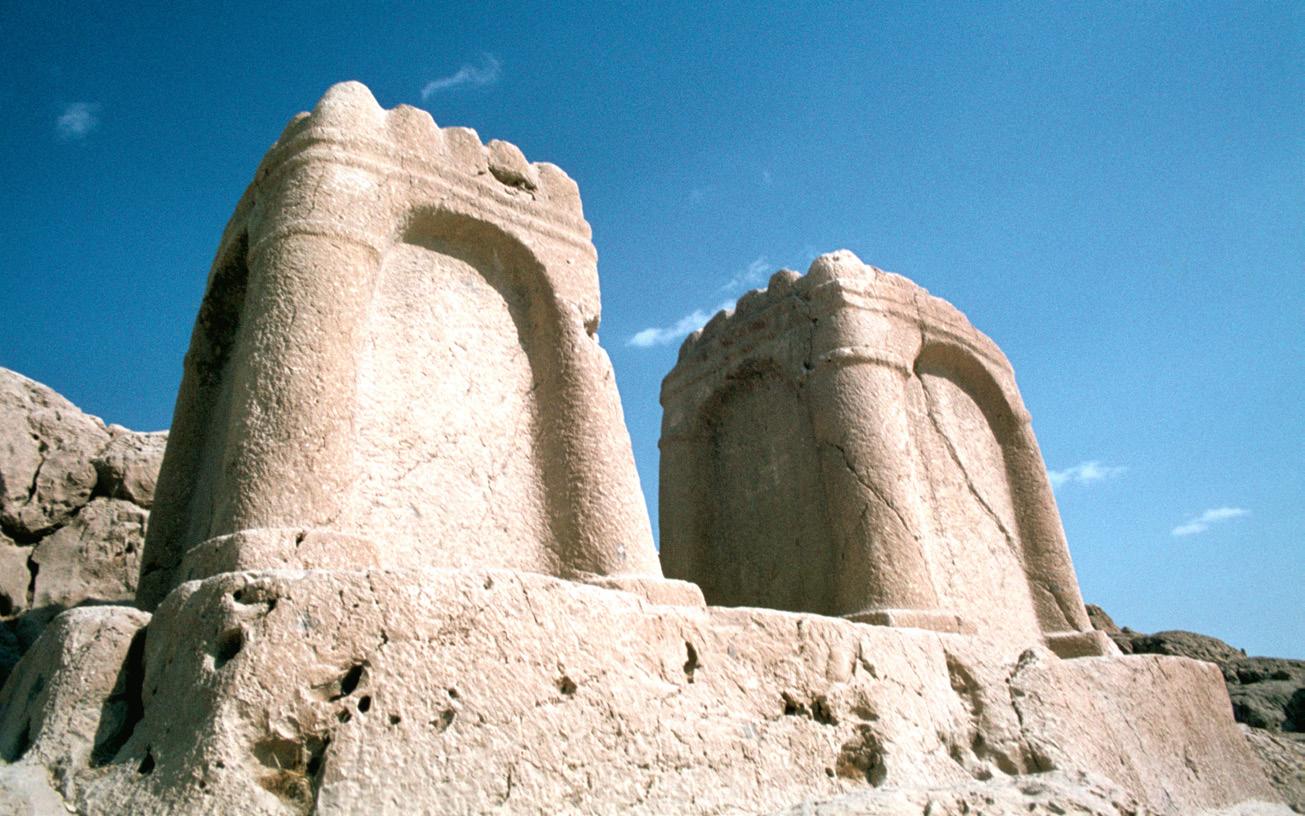
It is not clear if Cyrus the Great, the founder of the Achaemenid Empire, practiced Zoroastrianism. Scholars who are convinced that Cyrus was a Zoroastrian point to the stone fire-altars found at Pasargadae, Cyrus’s capital city, in the 1960s. The fire-altar is a special altar specifically for Zoroastrian worship. Those who doubt that Cyrus was Zoroastrian point to his tolerance, or allowing the practice of other religions. They note that he accepted the practice of other religions in his empire. They point to the fact that Cyrus was embalmed and his body placed in a tomb. In addition, Cyrus never mentioned Zarathustra or Ahura Mazda in his inscriptions. And Cyrus’s name is not mentioned in Zoroastrian records.
The later Achaemenids mention Ahura Mazda in their inscriptions. But there is not enough evidence to say how they practiced their faith. They may have been practicing ancient Iranian religion, Zoroastrianism, or a combination. We do not know about the Parthians either. However, we do know that the practice of religious tolerance that Cyrus started continued through the Arsacid Empire. In fact, it was not until the Sasanian Empire that things changed.
In the Sasanian Empire, Zoroastrianism was made into a state religion that was not always tolerant of other religions. The Sasanians attempted to make religious practice uniform. Religious works were written down instead of trusted to the oral tradition. Under their rule, the social structure of castes became more rigid.
Because the Sasanians had tied the practice of Zoroastrianism to the state and because the lower castes were unhappy, the religion did not remain widespread after 651 c.e. when the Arabs took control of the Sasanian Empire, effectively ending the state religion. Because they had been poorly treated, many members of the lower castes were happy to convert to Islam because it promised equality for all.
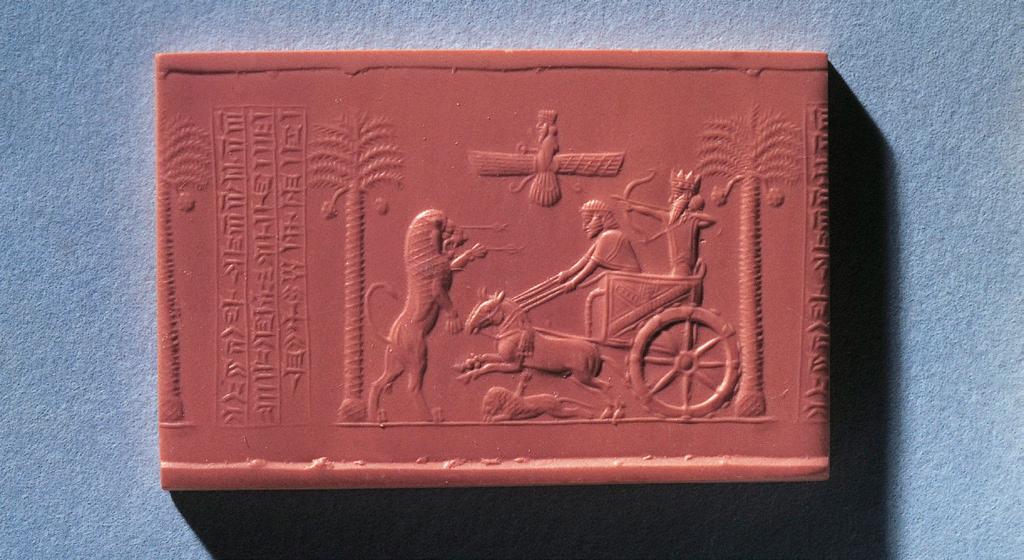
Ancient Persian arts and sports were connected to each other, although in different ways. They were also closely related to other areas of the lives of ancient Persians.
Ancient Persian Sports Sports in ancient Persia were closely connected to hunting for food and hides, on the one hand, and warfare, on the other. Sports helped develop the strength, speed, aim, and other qualities necessary for the hunter and the soldier.
Hunting was important in ancient Persia, both for sport and for food. Animals that were hunted included birds, bears, boars, deer, leopards, lions, mountain sheep, and goats. These two relief sculptures show kings hunting. It began as a way to get food and skin clothing. Eventually, the king’s leadership in the hunt, which showed his power, was connected to his leadership in times of war. Hunting, along with fighting, offering sacri fices, feasting, and attending state functions, became the key functions expected of a king.
Tools that worked well in hunting were adapted to use in war. Bows and spears were typical weapons, but Herodotus says that the lasso was used to such good effect that it came to be used in war. Also, dogs were used in hunting, and came to be used in war.
Hunting continued to be important, though some details changed in later empires. During the Achaemenid Empire, hunting parks developed. These were fenced areas set aside for sport hunting. During both the Achaemenid and the Sasanian empires, noble women were allowed to hunt. Some hunts were very elaborate and possibly included minstrels, singers of Persian epics, riding on camels with their lutes.
The image on the top shows a seal of Achaemenid king Darius I hunting a lion from a chariot. The silver plate on the bottom shows a Sasanian king hunting rams on horseback.

This is a stucco plaque showing a hunting scene in which a woman minstrel sits behind the king on a camel as he shoots gazelles.
Horses were at the center of many of the ancient Persian sports. They were first used only to draw chariots, but became riding animals prior to the Achaemenid Empire. As the army came to favor cavalry (KAH-vuhl-ree), or mounted troops, over chariots, riding became even more important.

Horse racing became a sport during the Achaemenid Empire. Cyrus II not only raced horses in Greece but also held a race in Greece between Greek and Persian horses. Racetracks had the dual purpose of being used for both races and games of polo.
Young noble Persian boys began to develop physical fitness as part of their education. Because it was considered “the best preparation for war,” hunting was considered a key part of a prince’s education. The Greek geographer and historian Strabo describes the training as follows.
They divide the boys into companies of fifty, appoint one of the sons of the king or of a satrap as leader of each company, and order them to follow their leader in a race. . . . training them to endure heat and cold and rains, and to cross torrential streams in such a way as to keep both armour and clothing dry . . . . They hunt by throwing spears from horseback, and with bows and slings; and late in the afternoon, they are trained in . . . making weapons and . . . hunters’ nets. . . . (XV.3.18)
There is little information on education overall, and even less on girls’ education. It may be that only boys were formally educated during the Achaemenid Empire. But evidence shows that some women attended school in the Sasanian Empire, though they may have only studied religion.
This bronze lion from Darius I’s palace at Susa is an example of free-standing art, that you can walk all around.
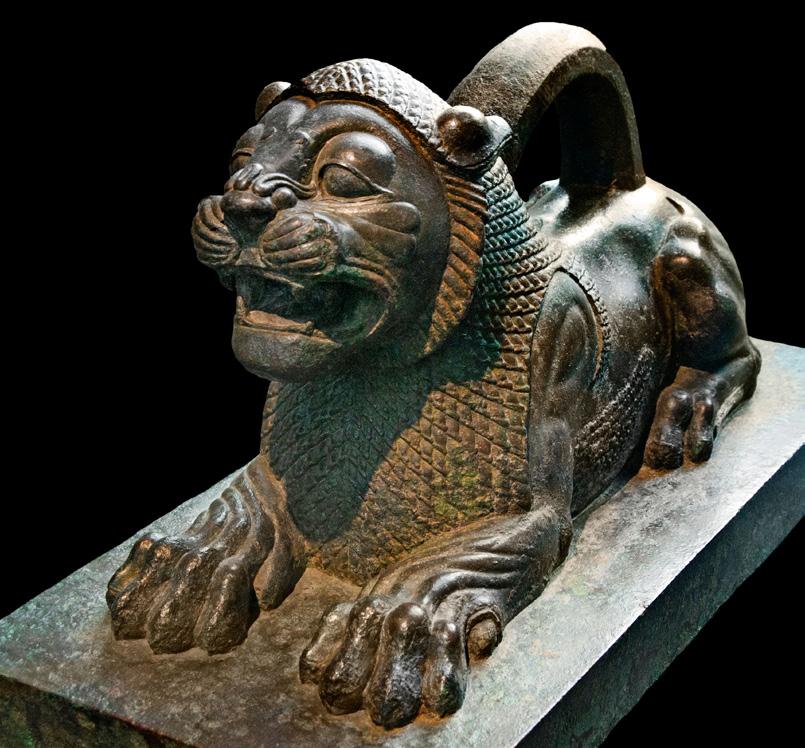
Shapur used a rockface relief to commemorate the peace he made with Rome.

Ancient Persian Arts
Art could be used for decoration and for telling stories, but also to recall important events, including sporting events, as we saw in the section on sports. Sometimes, art was used for rhetoric, to create a particular interpretation of events that the artist or author wanted to show.
Two kinds of sculpture are prominent in the artifacts that have been found from ancient Persia. Freestanding sculptures can be viewed by walking all around them, such as the bronze lion from the palace at Susa. Relief sculptures are raised against a solid background. They belong to the background but also stick out from it.
Persian royal rockface reliefs did not show battles but could show scenes that symbolize victories. Shapur I (shah-POOR) defeated the Roman army three times. Either Shapur I or Roman rivals at home forced the Roman Emperor Philip the Arab to make peace. In a different battle, Shapur captured the Emperor Valerian.
The rockface relief created at Naqsh-e Rustam combines these two key victories to help people remember Shapur’s accomplish ments. The relief shows Shapur on horseback with Valerian’s arm seized in his grip and Philip kneeling before him. Back in Rome, Philip had a coin minted that bragged, “pax fundata cum Persis”—I made peace with the Persians. In both cases, the purpose of the art was rhetorical, to make the citizens of the realm admire the ruler who made peace.
This mosaic floor shows a woman playing a harp.
Although no ancient Persian harps survive, their existence is known from artwork. It is thought that harps developed from bowstrings. Harps were sometimes played alone and sometimes in groups. They were also joined with other instruments, such as cymbals, drums, lutes, lyres, and pipes. The harpist might sing, or the music might be accompanied by dance, stilt-walking, and/ or juggling. By the Sasanian Empire, harps were closely associ ated with royalty and were used to accompany hunts.
This image of a woman playing a harp formed part of a floor mosaic decorating a building at the Sasanian capital of Bishapur. The technique was borrowed from the Romans.
While there were musicians in the Achaemenid Empire, minstrels, who were singers of poetry, became an important type of musician in the Arsacid Empire. Because there is no word in any Iranic language for a poet separate from a singer, it is believed that poetry was always sung. The minstrels, or gusan, were entertainers, and because there are no records of a woman gusan, it is believed they were all men. There are also no records to tell us how the gusan learned their art. Some scholars suggest that the minstrel’s art was hereditary, passed along orally from father to son. The materials that the gusan sang included stories, praise, satire, and laments for the dead. Sasanian gusan also sang epic poetry.
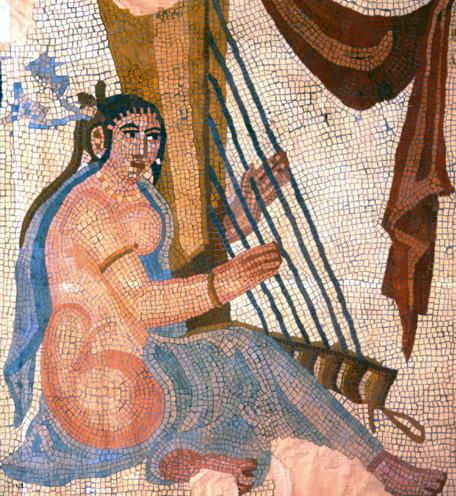
Darius I’s canal—assuming that it was completed—allowed boats to travel from the Red Sea into the Mediterranean Sea.
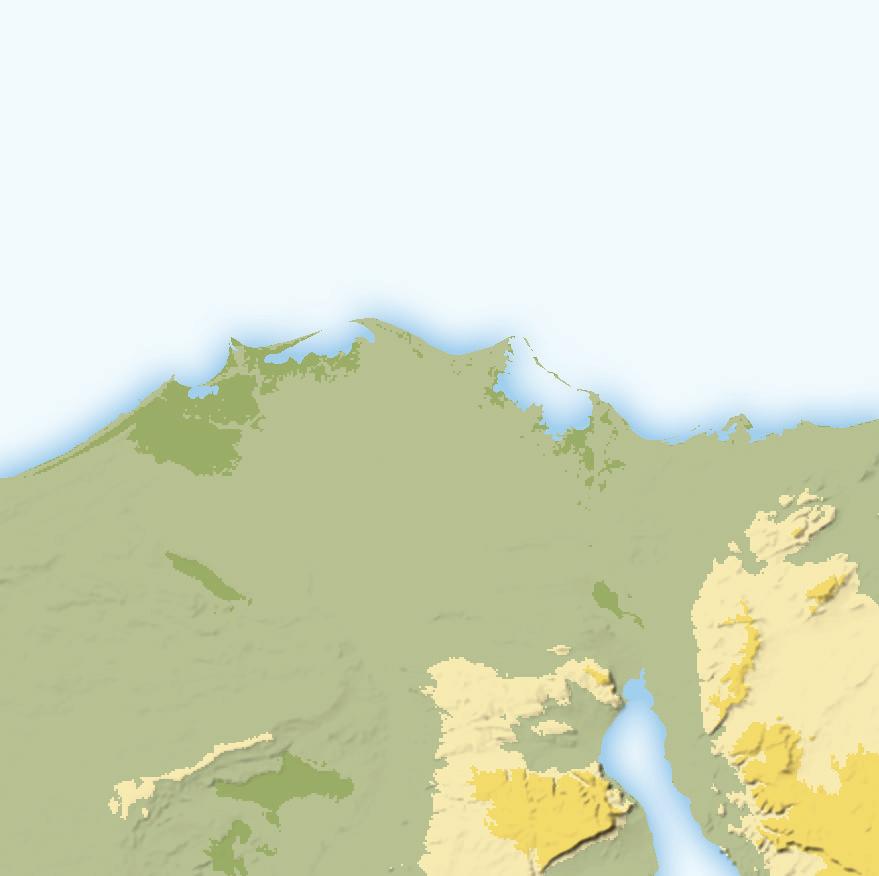
The ancient Persians use of science and math were combined into notable advances in technology. Water technology and warfare technologies contributed to the rise and continuation of the Persian empires.
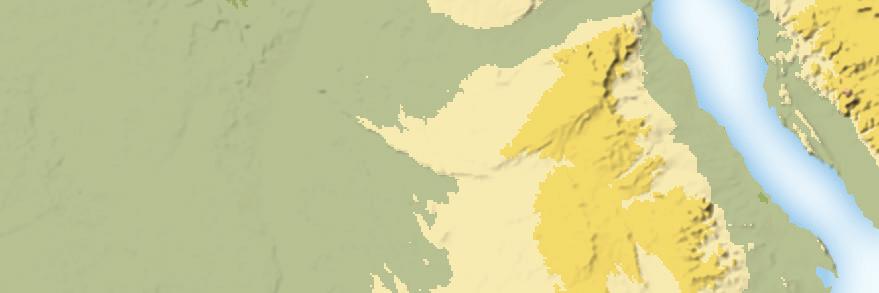
Shown here are sailors tying boats together to create a pontoon bridges. These were used by the armies of Xerxes and other Persian kings.
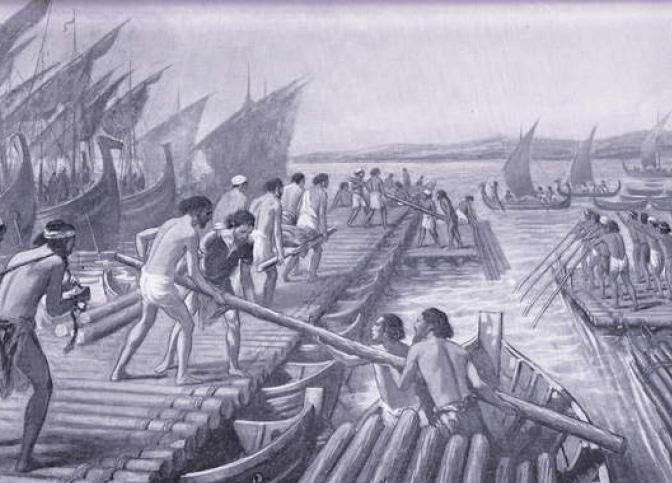
The ancient Persians were pioneers in two types of water-related technology. One was the building of bridges and canals to cross or link bodies of water. Darius I and Xerxes I, father and son, both engaged in canal building. Second was water supply technology. It increased the land that could be inhabited and cultivated, which was very important for agriculture and household water use in hot, semi-arid, and arid environments. Ancient Persians used underground channels, above ground channels, and cisterns (SIHS-turnz), containers in which water was col lected for later use.
The Persian empires had two types of bridges: those built to last and temporary pontoon bridges made of boats tied together. Temporary bridges were most often used to transport troops across rivers. More permanent bridges were also built through the empires.
In ancient Egypt, Pharaoh Necho II had a canal built from the Gulf of Suez to the easternmost branch of the Nile. Modern scholars differ about whether Darius I redug Necho’s canal after it fell into disrepair and filled with silt or whether he had a new canal dug. It is not clear why Darius was interested in this canal, but it may have been for trade or communications. It may also have been created to show his power.
Memphis Mediterranean Sea Nile Riv e r G ulf o f Suez Darius’s canal Stelae Darius I’s Canalcanal was a marvel of engineering. The Persians did not just build impressive canals, however.
The core of the water technology system developed in ancient Persia was the qanat (kuh-NAHT), a system of underground channels that take water from the highlands and convey it to the lowlands by using the force of gravity. Qanats make settlements in arid regions possible. Today, the qanat system is not only active, but a fundamental part of the water system of many countries. In the middle of the 20th century, there were over 50,000 qanats still operating in Iran. Today, there are only 36,000 left, and the system is in danger of coming to an end. However, some qanats have been restored.
Xerxes’s canal allowed his fleet to avoid the dangerous Cape of Athos.


qanat a system of underground channels used to irrigate arid and semiarid locations



The series of shafts shows the paths of qanats near the village of Kavir in Iran. They carry water in underground channels from the mountains to fields nearby.

This scene from the north Apadana stairway at Persepolis shows a weapon-bearer and lance-bearer attending King Xerxes. The left part was made shorter than the right.

It is believed that the qanat was invented in the first half of the first millennium b.c.e. It developed from mining technology, which required the building of tunnels. The Achaemenid and Sasanian empires used enslaved people and captives to build qanats.
Ancient Persian cisterns, or ab-anbar, are thick-walled, roofed underground storage tanks for water. They appeared later in the Persian empires and provided cool water. When designed to do so, they could also create a cool room to relax in during the summer. Cisterns may have been used with the qanat system or designed to collect spring runoff from streams when the snow melted. Cisterns were typically built below ground level and created with very thick walls. They were usually built of stone or brick, with a similar roof and a coating of plaster. It is the plaster that makes the cistern watertight.
Warfare Technologies
It was mainly through an army that Cyrus built the first empire in ancient Persia. It was through their armies that subsequent rulers maintained or conquered. Several types of technology contributed to their successes.
The same system that delivered messages for the postal service so speedily in times of peace also worked in times of war. But the Persians had a few other approaches to communication that helped get critical messages delivered. These included using light and mirrors and communicating with signal fires lit on high towers. All of these methods of delivering messages contributed to military organization.
By the time of the Sasanian Empire, a horseman, besides his armor, carried a wide array of weapons. For handheld weapons, he had a battle-axe, a lance, a spear, and a sword. For missiles, he had two bows with strings, including two extras, and a quiver of 30 arrows. He also carried a lasso or a sling with slingstones or bullets.
The short sword was used by Achaemenid warriors. A Mede typically held the position of royal weapon-bearer in the Achaemenid Empire.
This image shows archers in a brick wall relief from Susa. They may be members of the Immortals, the 10,000 best soldiers of the Persian army. The Immortals served as the king’s bodyguard.

The Old Persian word for spear and javelin is the same. Many of the Iranic peoples favored a short throwing spear. Spear- or lance-bearer to the king was a position of honor. Before Darius I ascended the throne, he was lance-bearer to Cambyses, son of Cyrus the Great. Darius then made Gobryas (guh-BREYE-uhs), one of the men who helped him kill the “usurper” Gaumata, his lance-bearer. We know this from a relief sculpture at Bisitun beside Darius’s multi-language inscription explaining of how he became king.
Ancient Persians also used bows and arrows. However, it wasn’t until iron arrows were mass produced, sometime between the 3rd and 1st centuries b.c.e., that they were consistently used in the eastern regions. In the western part of the Achaemenid Empire, troops were using iron arrows by the 5th century b.c.e.
Both the sling and lasso began with non-war uses. The sling was originally used by shepherds and the lasso by hunters and Persian cowboys, who tamed horses. Both tools developed into weapons of war. Because both lassos and slings are made of fiber, it is unlikely that anything remains of them. But “bullets” used in slings from the time of ancient Persia have been found.
Sling bullets, like this Greek example, were made of lead.

Sasanian King Shapur II takes a Parthian shot at a lion on this gilded silver plate.

Parthian shot a military tactic in which an archer rides away from an enemy, but shoots back over his or her shoulder
The so-called Parthian shot was a tactic used in ancient Persia. Horseback riders would turn and shoot in the opposite direction from which they were traveling. Thus, they could appear to be fleeing a battle scene, and when the enemy chased them, turn and deliver a shower of arrows. This technique was also useful in hunting, allowing a hunter a wider shooting range.
Animals in Warfare Cyrus the Great used camels to carry food and baggage when he conquered Lydia. But the Parthians used them to solve a problem of cavalry archers running out of arrows, which had been an issue for the Achaemenids. By bringing camel-loads of arrows, the Parthians were able to keep their archers on horseback continuously supplied. Elephants were used in battles by the Achaemenids, Parthians, and Sasanians. Elephants were used to terrify the enemy. This may have been due to a combination of their size, their ability to trample foot soldiers, the noise of their trumpeting, and the sound of the war drums strapped to their sides. However, in some situations, they provided an easy target. Toward the end of the Sasanian Empire, commanders stood on the back of elephants to watch the battle and plan strategy.
This image is a 15th century Armenian illustration of the Battle of Avarayr, 451 c e , in which the Sasanians used elephants to put down a revolt by the Armenians.
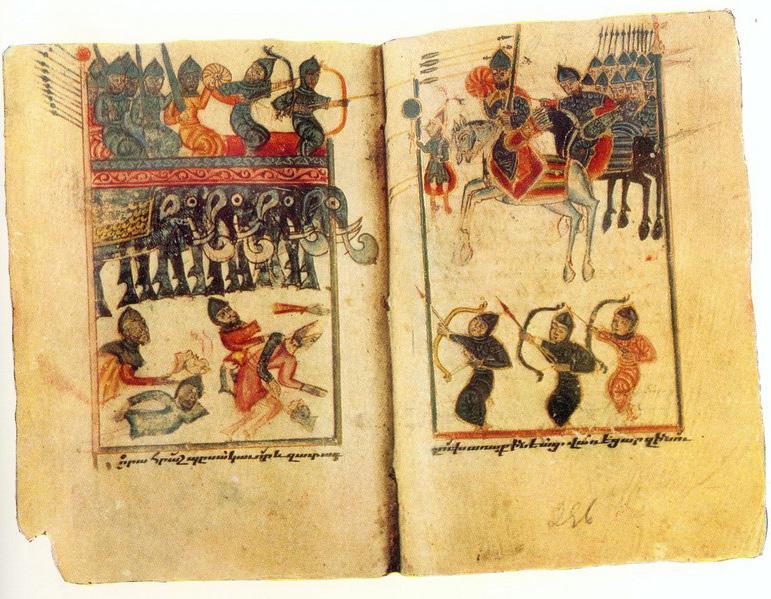
To create and expand an empire, ancient Persians fought their neighbors. They also fought with neighbors they did not manage to conquer, like the Greeks. You might think that conquered countries would hate the conqueror or invader. This sometimes happened, but not always. The relationships of the Persian central state with its subject states and neighbors was complex. One example is the relationships the Persian empires had with the Greeks.
Persians and Greeks: War and Peace; Suspicion and Trust Ancient Persians and Greeks fought a number of wellknown battles. It appears that the Persians and Greeks were enemies. But this is not the whole story. For example, left out of the record is the fact that there were alliances and peace treaties between the Athenians and Persians and between the Spartans and the Persians. Scholars believe that following these wars, a system of diplomacy developed between the Persians and Greeks. As a result of this system, these groups maintained moderately good relations through the rest of the Achaemenid Empire.
This chart shows the GrecoPersian battles and their results. These battles would help define the later relationship between Greek city-states and Persia.
499–493 b.c .e .
492 b.c .e .
Ionian Revolt
Mardonius’s campaign to attack Greeks
490 b.c .e .
480 b.c .e . stage 1
480 b.c .e . stage 2
Attack on Athens and the Aegean Islands
Battles of Thermopylae (land) and Artemisium (sea)
Invasion of Attica (land); Battle of Salamis (sea)
479 b.c .e .
Battles of Plataea (land) and Mycale (sea)
Revolt put down
Fleet mostly destroyed near Mt. Athos
Islands conquered; Persians defeated at Marathon
Persians win at Thermopylae; retreat from Artemisium
Persians raze Athens; Greeks win at Salamis, destroying a large portion of the Persian fleet
Greeks defeat Persians at Plataea; Greek navy destroys the rest of the Persian fleet at Mycale
This rock relief show the king with Mithra at his left and Ahura Mazda at his right. Mithra is portrayed in ways that identify him with the Greek sun god, Apollo. He is also bearded like Zeus.
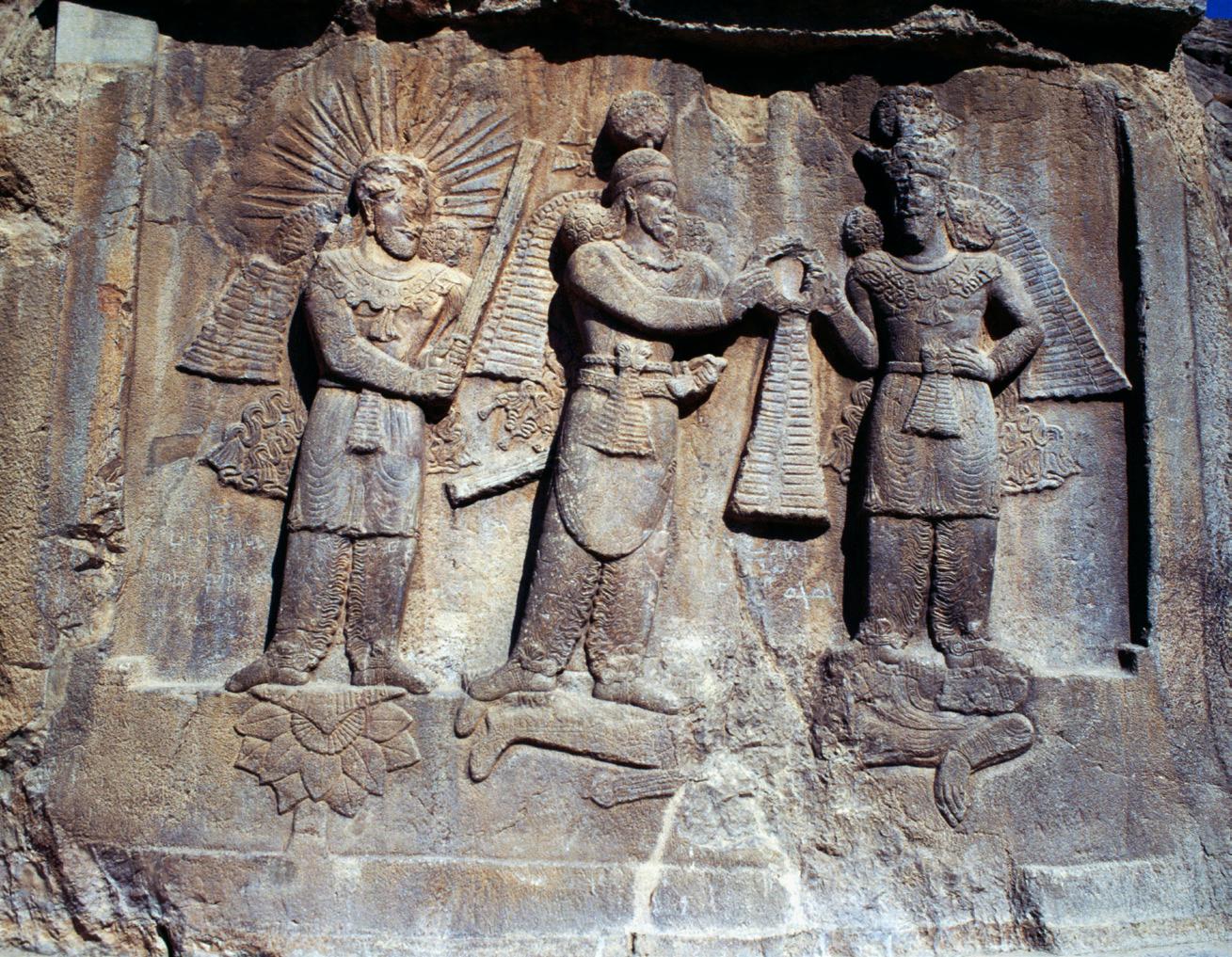
syncretism the blending of practices from more than one religion
Not all interactions between Persia and other places were defined by war. Because Persian empires included many subject states, people of many backgrounds lived there. But they did not all stay in their own subject states. People moved around the empires for a variety of reasons. And the tolerance established by the kings, as well as the practice of hiring workers from other states, encouraged the development of cities where different cultures came together.
Sites of Encounter
The Egyptian cities of Memphis, Elephantine, and Thebes, for example, were home to Greeks, Jews, Medes, Persians, and oth ers. They made business deals with each other, intermarried, and practiced each other’s customs. In time, they even worshipped each other’s gods.
Blending of Religions
Openness and tolerance had some interesting results. For example, according to scholars, gods from different cultures who had similar characteristics or appear ances, became combined in and around the Persian empires. This process is called syncretism (SIHNG-kruh-tih-zuhm), which means the blending of religions. Here are some examples. Anahita, the ancient Iranian goddess of victory became melded with Aphrodite, the Greek goddess of love. Achaemenid king Artaxerxes II had images of Aphrodite Anahita set up in his capitals to promote her worship. On Parthian coins, Mithra, the god of contracts, was shown as Apollo. But he could also take on the appearance of Zeus, the Greek ruler of the gods.
Greek–Persian Exchanges The exchange of products and ideas between Persians and Greeks is of particular interest as a means to see connections between the two cultures. Greek artwork made along the Nile during the Achaemenid period has been found in Central Asia. Trade between the Greek city-states and Persia brought in wine, ceramics, and olive oil, with Greek vases being found in major cities of the empire and along the shores of the Black Sea.
With Persian products in Greek territories, it is difficult to tell the difference between spoils of war and the possessions of Persians who lived in Greek cities and city-states from trade products. But it is known that trade brought Persian goods to the Greeks.
Beyond products, Greek textiles and art reflect a serious interest in Persian fashion. A strong example is the sleeve. Greek clothing was not sewn. Greeks wore pieces of fabric secured with pins or belts. Persians wore sleeved garments, and the sleeve made its way to Greece. Greek pottery painters began by showing people from the east with sleeves. By the middle of the 4th century b.c.e., women were offering sleeved garments in their offerings to the goddess Artemis. Since women generally offered personal items upon receiving a favorable answer to a prayer, this implies that women had begun to wear “Persian-style” clothing. Pictures of Greek women in sleeved garments also appear in pottery paintings.
The Greeks imitated other Persian cultural practices in their art, such as walking in procession and carrying parasols. The frieze, a horizontal band of relief sculpture, on the Greek Parthenon in Athens shows water carriers in the Panathenaic festival procession. The procession is thought by some scholars to imitate the relief at Persepolis. And there are instances in Greek painted pottery showing Greeks carrying parasols.
In the image of a rock relief, you can see an Achaemenid king shaded from the sun by attendants carrying a parasol. In the mural, a Greek woman holds her own parasol in a painting on a Greek pot.
To the left, the attendants of an Achaemenid king hold a parasol over him in a relief at Persepolis. To the right, a Greek woman uncharacteristically holds a parasol in a painting on a Greek vase.

At the left, Xerxes wears a typical Persian outfit with sleeves in a rock relief. To the right, a woman is shown on a Greek vase wearing a Persian-style garment with sleeves.

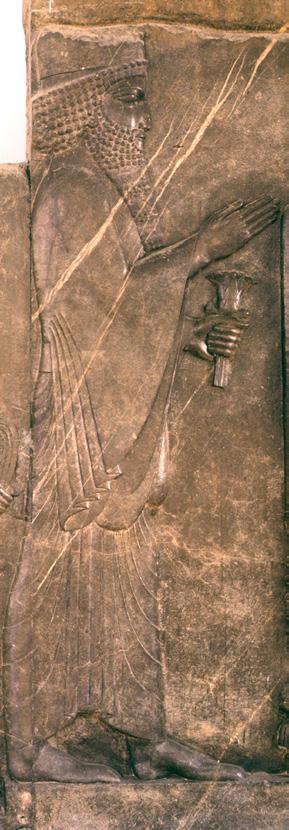
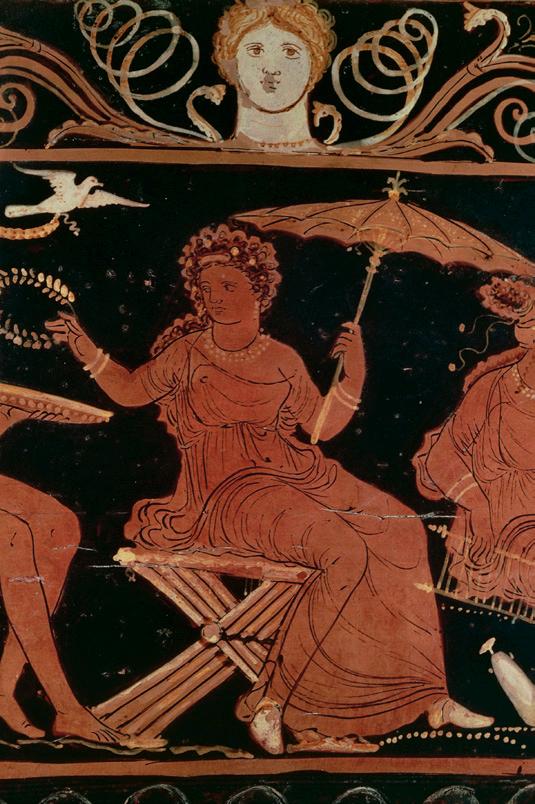
This is an 11-language welcome sign in the United Kingdom, which has no official language. The use of many languages in a single place was common in ancient Persia and is also common in today’s world.
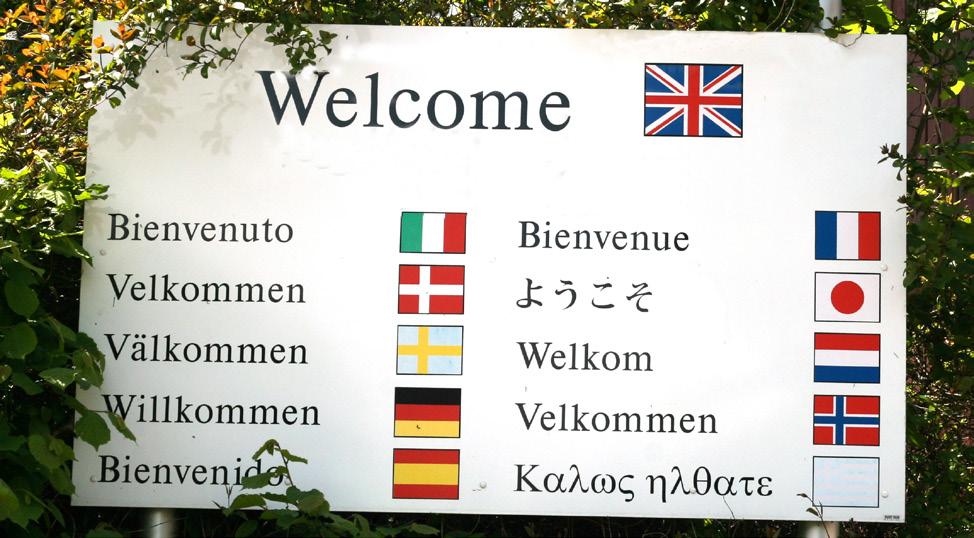
A brick on a Sichuan Chinese tomb from the Han period shows a warrior taking a Parthian shot.
Ancient Persians created many systems and developed ways of living with other people. Some of these survive into the present day. Ancient Persian approaches to governing an area with many languages, their religion, and their water technology still survive.
Multilingual Culture—Ways of Communicating Unlike the Assyrians and Babylonians who used only their own language to rule their empires, the Persians used multiple languages. Beginning with Darius I in the Achaemenid Empire, the Persians wrote royal inscriptions in three languages, organized in rows or columns.
They may not realize where it came from. But a number of contemporary nations use a similar approach. The combination of languages depends on the location. Today, Canada has a multilanguage culture. The Canadian government uses a system much like the Achaemenids did to communicate with citizens who speak either of the official languages. But even countries that have a single official language or that use mainly one language, such as the United Kingdom, may take steps to make sure they communicate clearly with everyone. Here, travelers are welcomed in 11 languages. Countries like the United States, with no official language, often use similar strategies to make sure many people can understand official documents.
The Parthian Shot
Turning around and shooting a bow on a horse fleeing the scene of battle was a particularly effective strategy. Pursuers who were starting to celebrate their victory were suddenly under attack.
This strategy was used widely in the ancient world. We may never know if it originated in Persia. What we do know is that it takes its name from Persia. It is known, wherever it appears, as a Parthian shot. What do you gather from this image found on a brick in a Sichuan Chinese tomb from the Han period?
We know from Chinese documents that the Han and the Persians were in touch during the Arsacid Empire. We don’t know if the Han learned this move from the Persians or if they both learned it from pastoral nomads from the Central Asian Steppes.
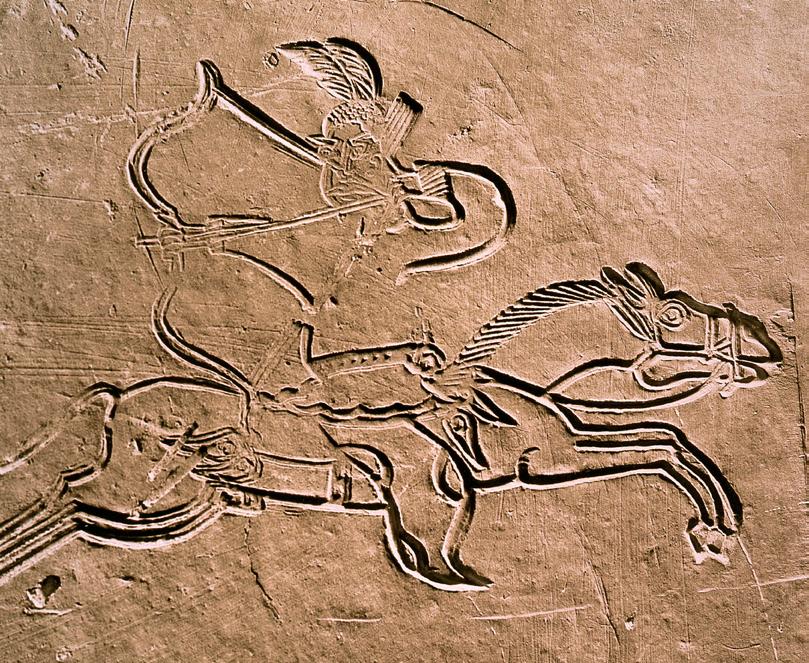
Jordan and Syria
qanat, romani
Western China kanerjing
Afghanistan and Pakistan karez
North Africa foggara
Morocco knittara
Spain galerias
Qanats Invented in ancient Persia, qanat technology has spread to many areas of the world. Cyrus was responsible for spreading qanat technology to Oman, while Darius brought them to Egypt. The Romans spread them through the Near East, and they reached Spain and Morocco through the Arabs. In all these different locations, the water channels are called by a variety of names. But by any name, they are very useful where the climate is hot, semi-arid, or arid and water is in short supply.
In the city of Turpan, China, wells based on Persian designs enabled the city to prosper. It became an important stop for traders traveling on the Silk Road.
Chart showing different areas of land and their different names for water channels.
The Karez well system was built over 2,000 years ago in the city of Turpan in western China.

Justinian I (left), a 6th century c . e . Byzantine emperor, held strict views about religion. His views led him to close the Athens school of philosophy that Plato had founded in 387 b c e However, Kosrow I (right) was open to diverse learning. He welcomed the Greek philosophers who took refuge in the Sasanian Empire.
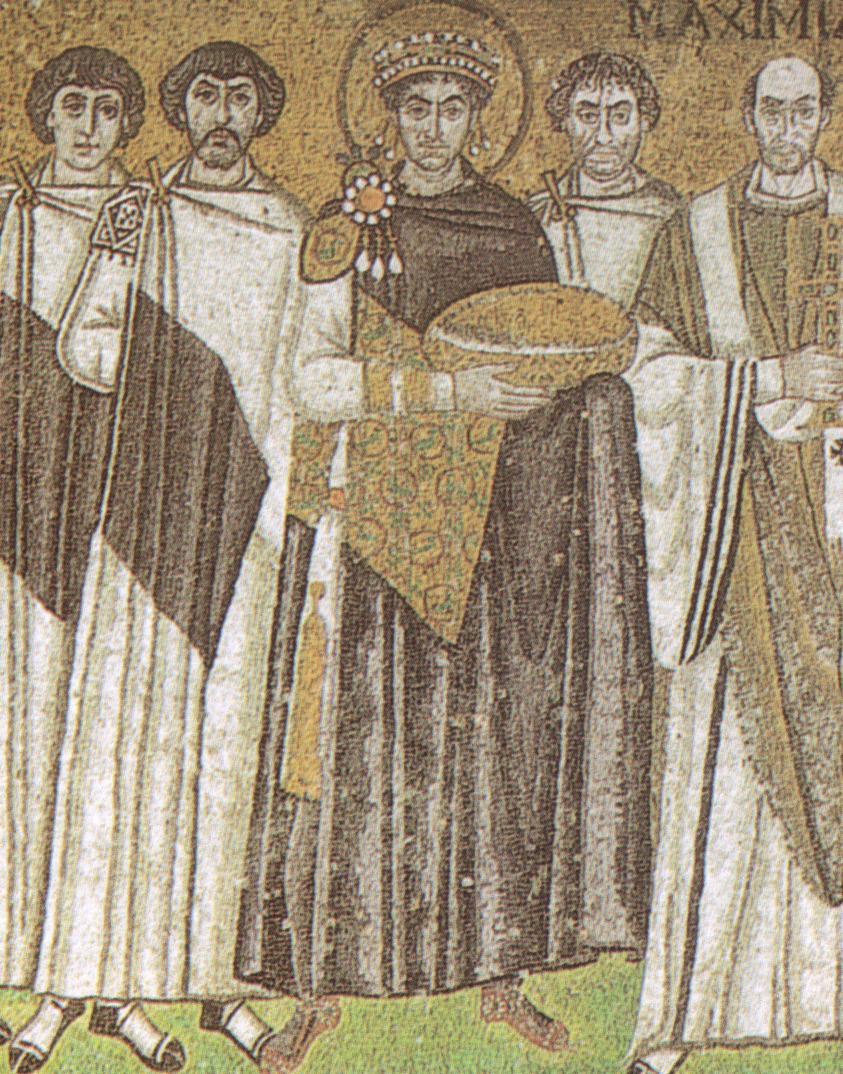
Other Elements of the Legacy of Ancient Persia
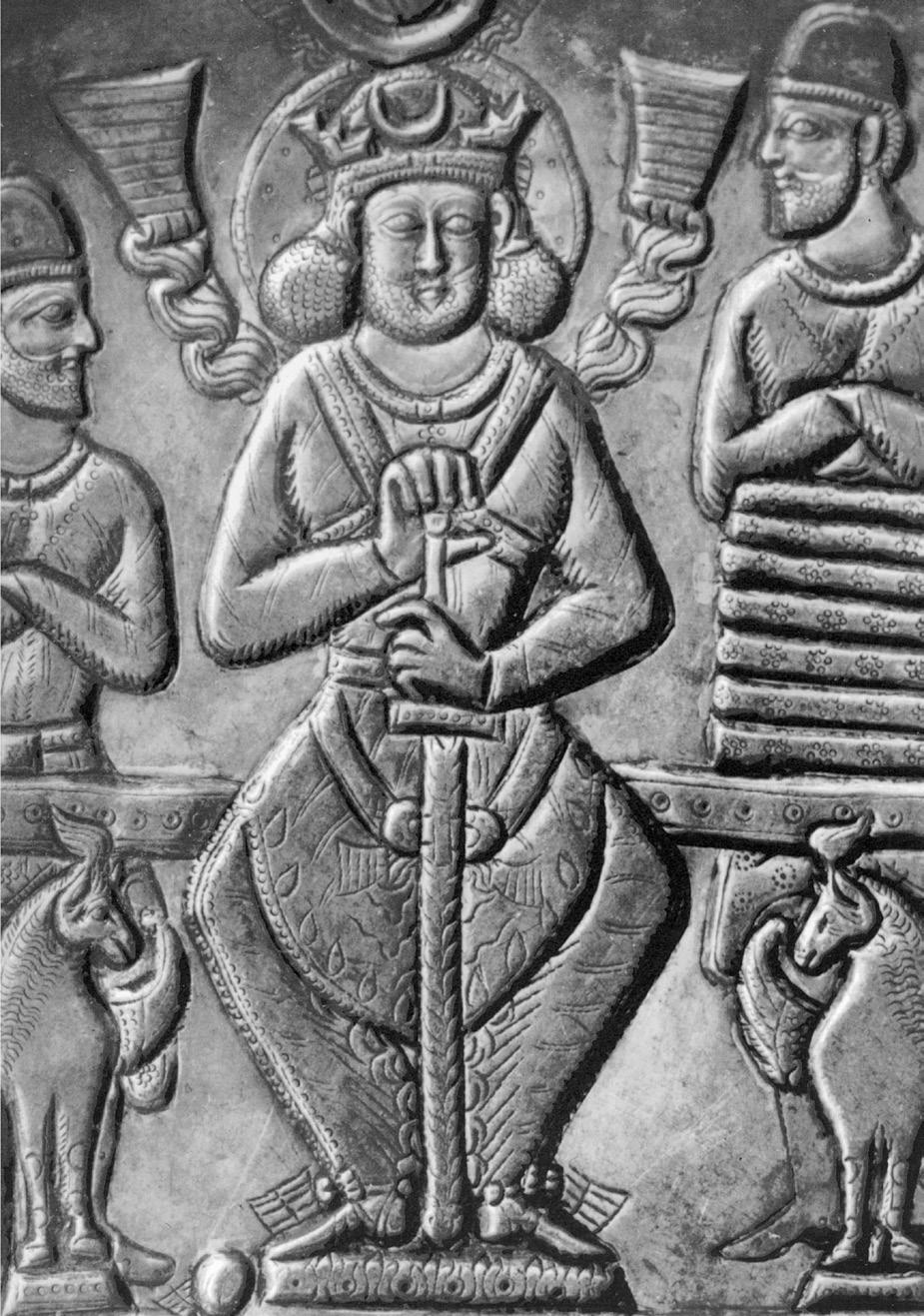
The things we owe ancient Persia are many and far-reaching. Ancient Persian rulers were tolerant of different peoples and their ways. They were actively interested in the practices and beliefs of others. This attitude led to the preservation of learning that might have otherwise been lost.
For example, in 529 c.e., the Byzantine Emperor Justinian, head of the Eastern Orthodox Church, shut the Academy of Athens. The philosophers running the school were not Christians, so he thought the school was harmful. Seven of the philosophers found a home in the Sasanian capital city of Ctesiphon. The king, Kosrow I, welcomed them. And he made sure their teachings were preserved for the future by having them write instructional texts for him.
But ancient Persia is alive in a special way for us because of the many words that have come into English from Persian. Words that you probably think of as normal English words have their roots in the Persian language. English words that come from Persian include colors, articles of clothing, fruits and other foods, flowers, and musical instruments. Ancient Persia lives on in the words we speak and write.
Ancient Persian Economics and Networks
Ancient Persia’s road networks connected major cities and made a large amount of trade possible. Trade from as far as China began very early on and continued through the centuries. Persia also used its road network to communicate with others quickly and transport troops.
Ancient Persian Social Structure and Class Ancient Persian empires had diverse societies with a complex class system. Generally, people existed within specific castes. In some areas, their social status depended on local ways of life. Women in ancient Persia appear to have had many rights.
Religion in Ancient Persia The religion of ancient Persia first arose with a pantheon of many gods. It later developed into Zoroastrianism, founded by Zarathustra. Zoroastrianism was one of many religions in ancient Persian territory, where tolerance was usually practiced.
Sports and Arts in Ancient Persia Hunting and horse racing were important sports. They encouraged people to be resourceful. Ancient Persian art featured reliefs, mosaics, music, and minstrels called gusan that may have passed stories from one generation to the next.
Ancient Persian Technology Aside from their developed road networks with bridges, the ancient Persians created canals, qanat systems, and cisterns. They also developed war technolo gies and developed a tactic called the Parthian shot.
Ancient Persia and the Rest of the Ancient World Persian empires used trade, diplomacy, and war to interact with other places. They shared culture and religion with many places, as shown in Greek art with Persian styles used.
The Legacy of the Ancient Persians The use of many languages under a single government was a helpful tool used by Persian kings. Nations today continue this in order to make sure people have a way of understanding important documents and events. The Parthian shot spread to China and water systems created by the ancient Persians have been used in many parts of the world.
Shown here is the Fire Temple of Yazd in Yazd, Iran. Notice the pool of water in the center and the faravahar, or winged man, above the columns.
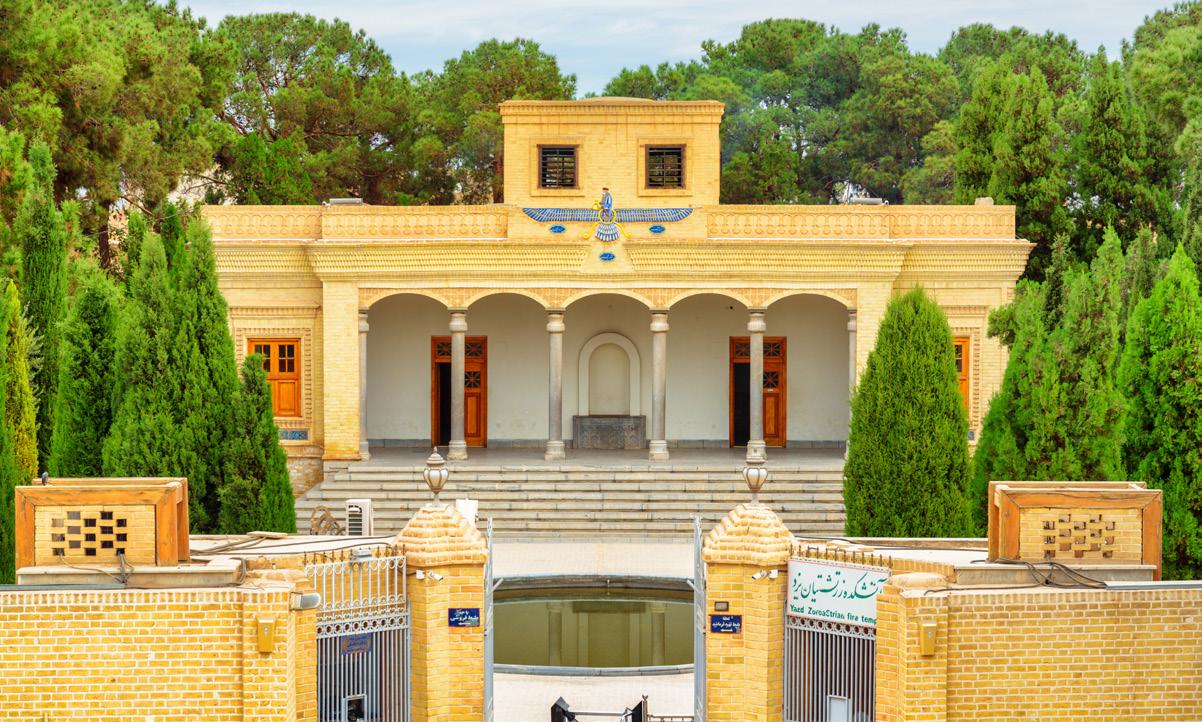
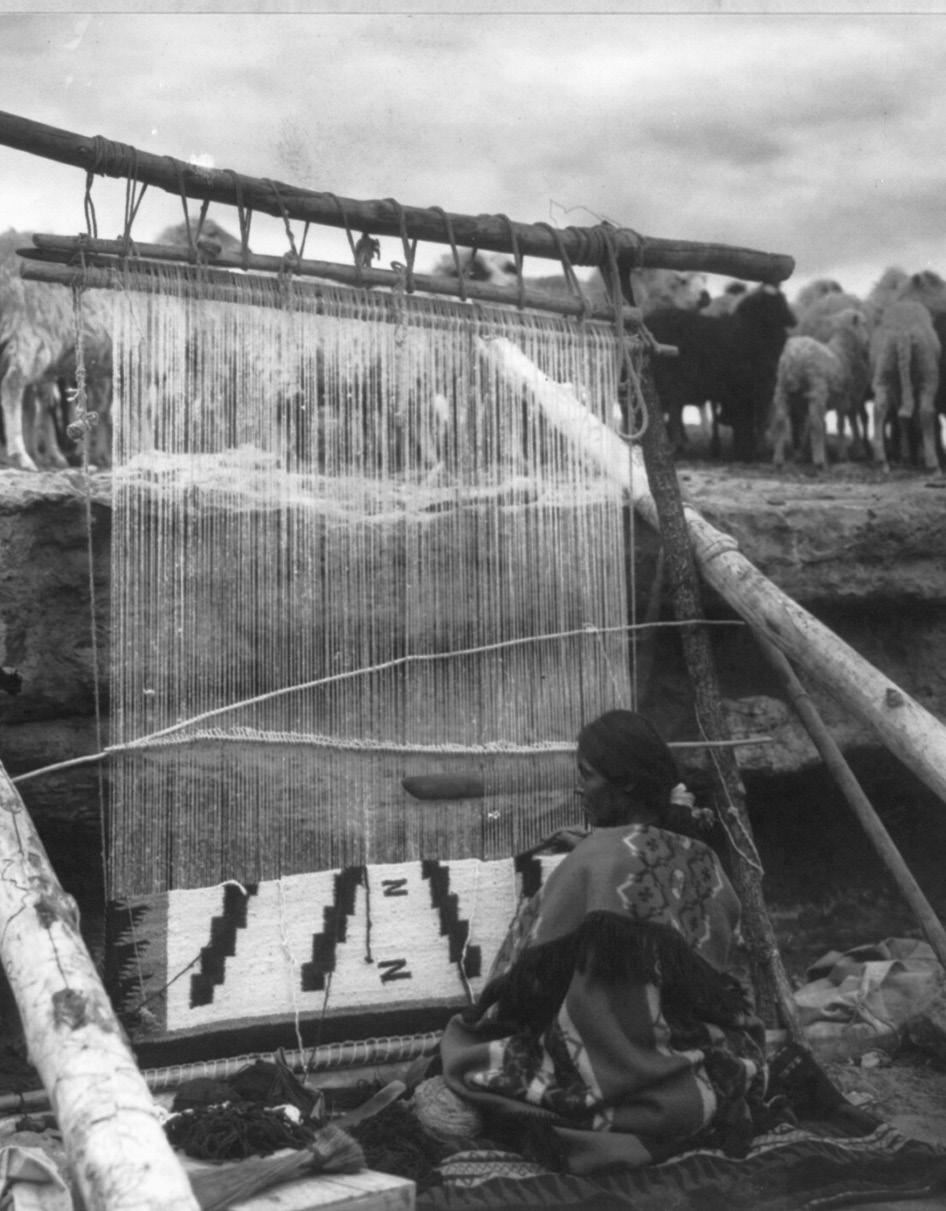
Today, historians follow clear professional rules to make sure the facts they discover are correct and the conclusions they build from those facts make sense. Before writing, ancient cultures relied on their oral traditions, such as the stories that they passed down.
Such ancient stories were often told with the entire local community present. Kinship kept them safe and defined what every member had to do. Today, historians understand that these stories cannot be fact-checked. Most of the evidence is long gone. However, a community’s stories can tell us much about what a group of people believed and what their values were. These stories can often teach us even more about an ancient culture than a collection of fossils or a spearhead.
The origin stories of ancient American cultures have some similarities and many differences. In these stories, there tends to be a strong link between the real world and the spiritual world. Animals turn into humans and back again. These stories teach that we are not just connected with one another, but also with the natural world and with forces we cannot control.
Often, it is the moral of the story, not its facts, that are important. What we will see as we study these cultures of the Americas is that there is a deep connection to the natural world and to the community.
Social Studies Vocabulary hieroglyphs monumental architecture oral traditions shaman stratified society
Weaving was an important part of many ancient cultures and remains so today. Navajo weavers often include their cultural stories in their designs.
This map shows the migration routes taken over Beringia, which is now the Bering Strait and separates Russia from Alaska. Over 10,000 years ago, this landmass connected these two areas and served as a crossing between the two lands.



The early people who arrived on the continents of North and South America probably traveled across Beringia. Beringia was a landmass that once connected northern Asia and Alaska. DNA evidence confirms that Indigenous people across both North and South America share genetic information with Asian cultures across the Bering Strait. These groups do not share that genetic information with any other continent in the world.


Historians first concluded that humans crossed Beringia around 13,000 years ago based on the end of the last ice age. During this time, there was an overland passage between Asia and North America. This timeframe agreed with the dating of arrow heads found across North America, known as Clovis points. The early culture that made these unique weapons was long considered the first human culture in the Americas.
For several decades, though, the mystery has grown more complicated. Some sites discovered in Chile, Texas, and Idaho are too old to have allowed an easy crossing from Asia to North America. Then, in 2018, scientists found footprints in New Mexico that date back at least 21,000 years.





Women were often in charge of the food supply in Indigenous cultures, but that also gave them an influential role in group decisions. Here, an Apache woman is harvesting wheat.
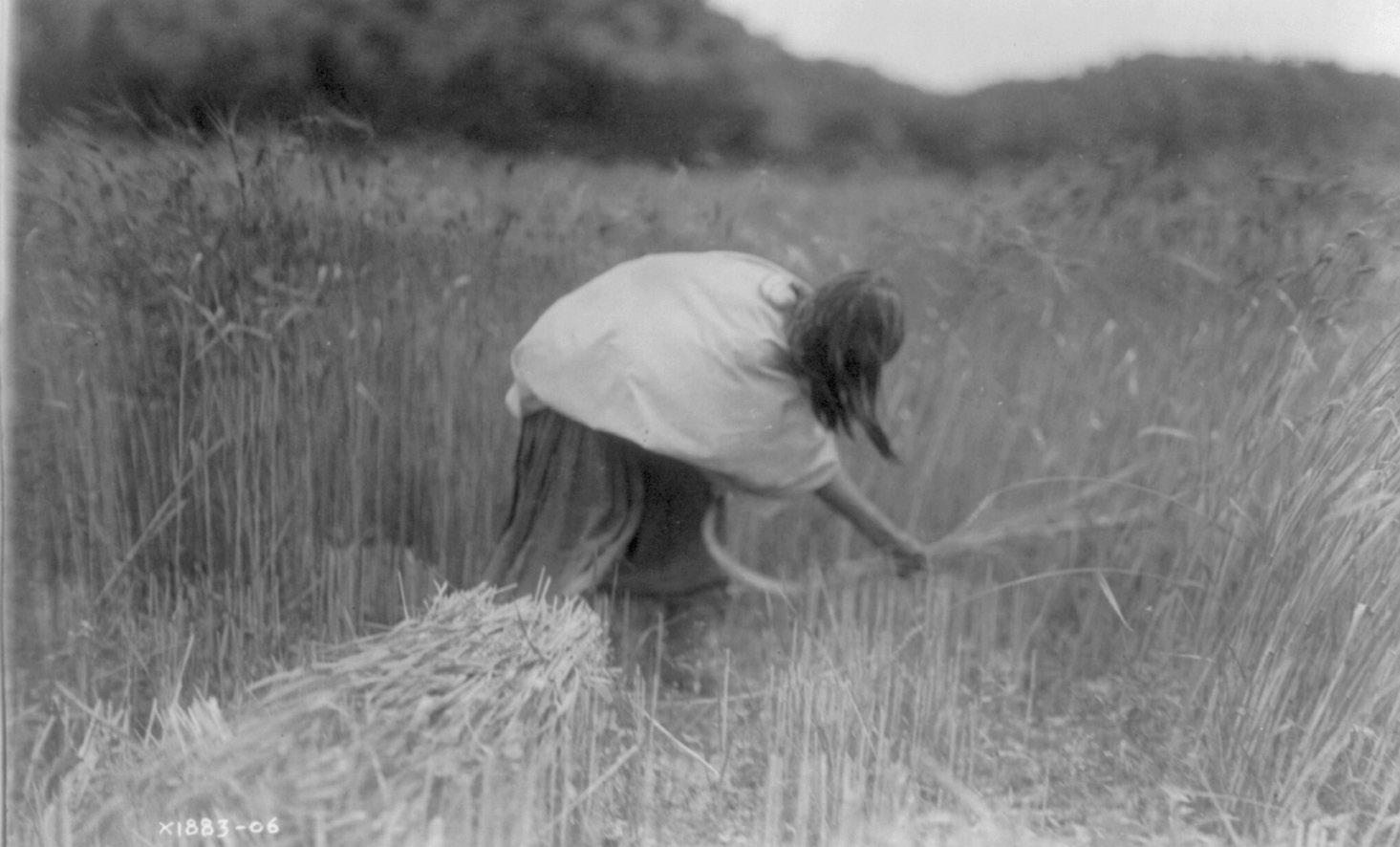
Scientists are trained to be very critical of new evidence that upsets theories that have been established for some time. It took a long time for historians to give up the “Clovis First” theory. But both scientists and historians now accept that we don’t know when or how the first people crossed Beringia. All we know for certain is that they did cross. After that, they either lived for many generations in Alaska and western Canada and gradually began to move east and south. Or they migrated across the continents more quickly. The evidence found so far does not definitively indicate which is the case.
This new understanding of America’s history is also an important example of the fact that history is ever-changing. Scientists use the strongest evidence and the best technological tools they have. But their conclusions change as a result of their ongoing detective work. That might be a more important point to remember than whether the first Americans arrived 13,000 or 20,000 years ago.
The details of this historical mystery have yet to be solved. But we do know that when the first Americans arrived, they eventually traveled all the way east to the Atlantic Ocean and south to the tip of South America. Along the way, they may have moved through the continents by inland passages created by melting ice or along the ocean. They may have moved quickly or taken generations to choose to move east and south. Once the decision was made, it still would have taken people many years to arrive at what would be their final destinations.
However this happened, the earliest settlers of the American continents show us great examples of human endurance and imagi nation. To move to new lands takes faith, skill, and endurance.
stratified society a society that is clearly divided between an elite at the top and, often, a group of skilled workers in the middle and laborers and people who are enslaved at the bottom
The First Societies of the Americas Many American cultures began as farming societies. Later, they developed complex cities or urban centers, based on the wealth they gathered from farming and trade. The people who lived within those stratified societies had distinct roles, work, and status in society. For many reasons, including the arrival of Europeans, many of these civilizations no longer exist today. However, their culture has been kept alive by descendants of these groups.
The story of the earliest cultures in the Americas also includes societies that existed on a smaller scale. Among these are the Aleutian and Inuit in the North, the Dakota (Sioux) and Cheyenne of the Great Plains, and the Diné (Navajo) and Pueblo in the Southwest. Today, many Indigenous people continue or relearn the legacies of the hundreds of separate cultures that have existed in North America alone. This legacy includes the beliefs, governing social systems, arts, and culture of their people.
Early groups settled and developed complex societies. As you will learn, the civilizations in this map and timeline were particularly influential or notable.
The climates in which they lived often prevented people from developing agricultural settlements. They instead had to migrate with their food supply. The Inuit and Aleutians, living on land frozen much of the year, developed sophisticated ways to survive and to live from fish, whale, and land mammals. The Indigenous people of the Great Plains followed the bison herds that they relied upon to survive. For shelter, Indigenous people of the Southwest regions of North America often carved out dwellings in cliffs or built their classic pueblos from adobe, a mix of clay and water. But drought could force them to leave these settlements and migrate to find a better food supply. Regional climates and local food supplies were very important to how and where Indigenous people lived.
Across the Americas, Indigenous groups mastered weaving. Here are examples from the Tlingit from Alaska (top) and the Diné from the southwestern United States (bottom).


Nearly all Indigenous traditions were saved through rituals and oral traditions, which were passed down across genera tions. Elder members of the community were highly valued because they understood these rituals and stories best.
Indigenous Communities Rituals prepared members for a hunt, but they also enforced the central beliefs of a society. For example, the Lakota (Sioux) and Dakota (Sioux) honored the basic forces of nature, from the winds to the sun and moon. The Sun Dance was performed to ask supernatural powers for a suc cessful hunt. This ritual also shows that this culture understood they were a just a part of nature’s order, not its dominant, or most powerful, force.
Cooperation with nature and even the belief that all parts of nature have force or spirit is another common trait. It was the important role of the shaman to interpret nature and direct the community’s rituals. The stories of these communities often linked the rituals to nature. The Inuit stories explain that the spirits of their ancestors can be seen in the aurora borealis, or northern lights. In the Cheyenne origin myth, the mother who created humans with her husband, the sun, ends as a constella tion in the sky, along with her children. She looks down upon all her people every night.
oral traditions the stories passed down in a society, especially when there is not a written tradition shaman a member of society who is able to communicate between society and the spiritual and natural worlds
Historians have learned that cultures that migrated created lightweight baskets. Cultures that settled began to make clay and ceramic pots. Now, when archaeologists discover remains of these essential items, they can get an early clue about whether the group was settled or on the move.
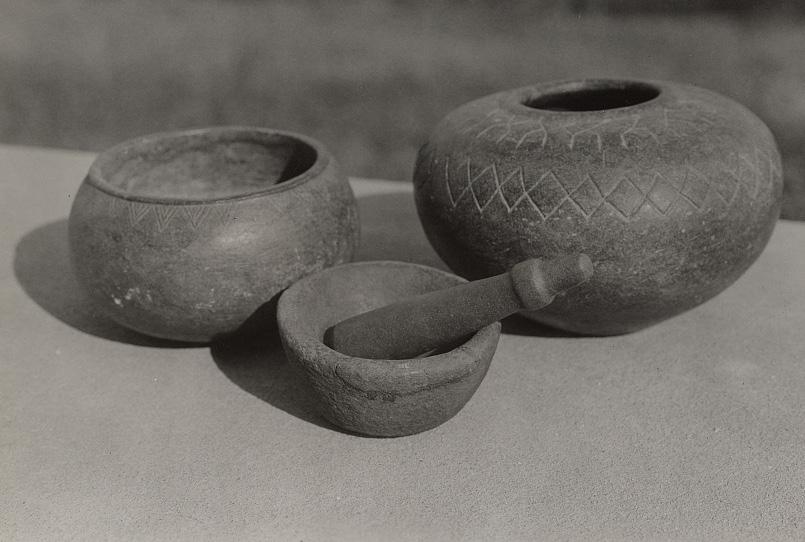

Tradition also created a stable plan for how the necessary work of a community would get done. This included leadership and selecting who would govern disputes among the community and with surrounding communities. Elder members were usu ally selected for this task. However, hunting and fighting would usually be led by a younger man skilled in that field. The Inuit tradition tells us that any leadership talent among the group was valued and encouraged. Every member might be needed as a leader, depending on the task at hand.
The symbolic crown of leadership was therefore passed to the one suited to it at the time. But the community could also take that role away. Leadership depended deeply on the community’s agreement, not on an individual’s successful power grab.
Gender Roles Were Important and Organized Gender roles for women were also different from the traditional European ideas of a male breadwinner and a housewife. These ideas were still common when Europeans arrived in the Americas. While Indigenous women generally managed the food for their family and society, they were also given respect and status for doing that. In many Indigenous cultures, young men moved into their wives’ homes, and those homes were owned by women. If men wanted to divorce, they might have to move out and fend for themselves.
Women, especially mothers, were usually included as elder consultants in tribal leadership. In some cases women had the very important task of choosing the tribal leader.
In contrast to European cultures, many Indigenous cultures accepted children who did not follow the traditional male or female gender roles. Those who could embrace the roles of both genders were seen as more spiritual people. They shifted into the other roles and tasks the tribe had laid out. An athletic female hunter or artistic male could be a two-spirit member of a tribe.
The first Europeans who encountered these cultural habits found them impossible to understand. They sought to change the behaviors they encountered and to erase any evidence of it from the record. Today, one more hurdle that historians face is navigat ing the prejudices of the past that early Europeans recorded. But by following the evidence as closely as a good detective would, they work to create a history that is as accurate as possible.
One of the most influential cultures in the Americas appeared around 1500 b.c.e. The Olmec are known for large carved heads with their chins just barely above ground. These remarkable heads were first discovered in the Mexican regions of Tabasco and Veracruz on the Mexican side of the Gulf of Mexico.
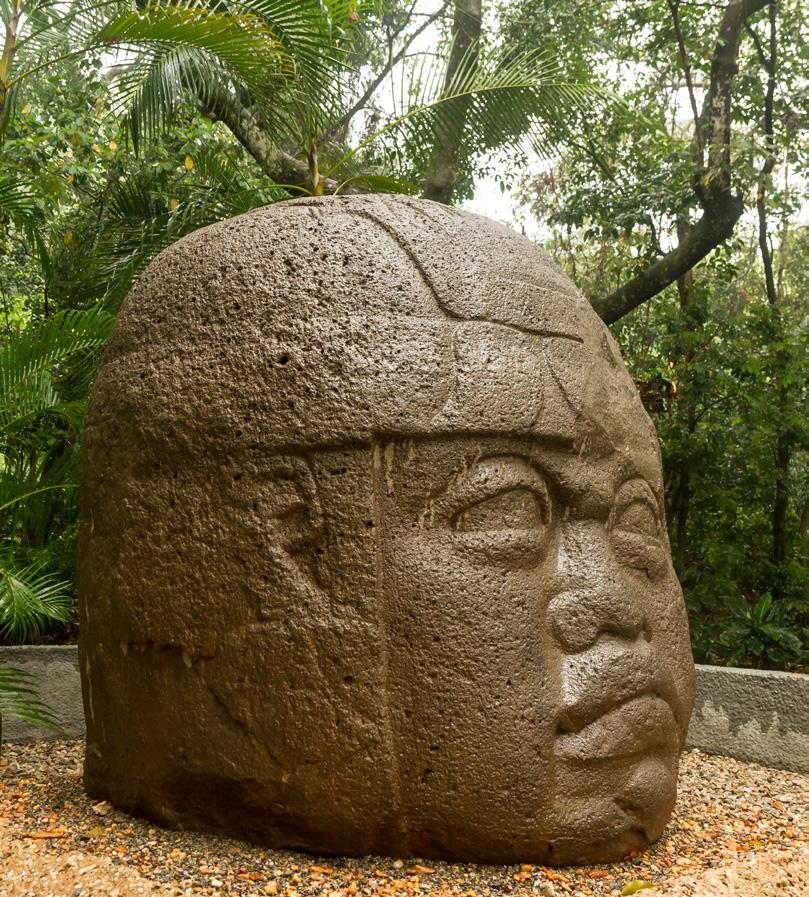
Many scholars believe that these heads were most likely carved to depict important rulers. But no names are attached to the heads, as is usual in other ancient statues of rulers around the world.
The Olmec civilization was based along Mexican coast of the Gulf of Mexico. Artifacts found there suggest that the Olmec were involved in wide-ranging trade with other societies. Some of the artifacts, such as those of valuable jade, were not native to the region.
Unlike societies that migrated with the seasons, such as those in North America, societies that developed the ability to grow crops on a large scale were able to save good harvests for the future. Their populations grew along with their food supply. The Olmec civilization also became wealthy and strong from their trade in ceramics, in luxury items of jade, and in tools made of obsidian, a hard dark stone.
Such wealth led to sharp divisions in their society. Elites (royalty, priests, and shamans) were supported by middle-class artisans and tradespeople as well as by farmers and people who were enslaved. Such sharp social divisions were different from smaller North American societies. Smaller societies tended to know the other members of their groups and to govern by consensus, or general agreement.
The largest Olmec centers, first at San Lorenzo and then at La Venta, give us further evidence about this society. Like many of the early cultures of America, the Olmec built ceremonial mounds. La Venta is also home to one of the earliest pyramids in the Americas. It still stands over 110 feet high two centuries later. Complex mosaic floors have been uncovered, providing evidence of the Olmec’s artistic skill.
Olmec art is unique and easy to identify. The Olmec downturned mouth can be seen in most statues of heads and in other artwork.
The Olmec civilization died out around 400 b.c.e. Although much is still unknown about the Olmec, researchers believe that some aspects of their culture were borrowed by later cultures of the region, such as the Maya civilization. This may include their writing in hieroglyphs, their calendar, and their basic urban plans.
hieroglyphs an early form of writing based on symbols
monumental architecture structures that are built to be very large, often to honor the power of the rulers of society or its gods
Evidence of the early stages of Maya civilization suggests that it may have begun around 2000 b c.e. co-existed with the Olmec in and near Central America before that older civilization died out. By 250 c.e., however, the Maya culture had reached its golden era. It covered much of the region in what are now the countries of Guatemala, Belize, El Salvador, Honduras, and parts of Mexico. Today, descendants of the Maya still live in those countries.
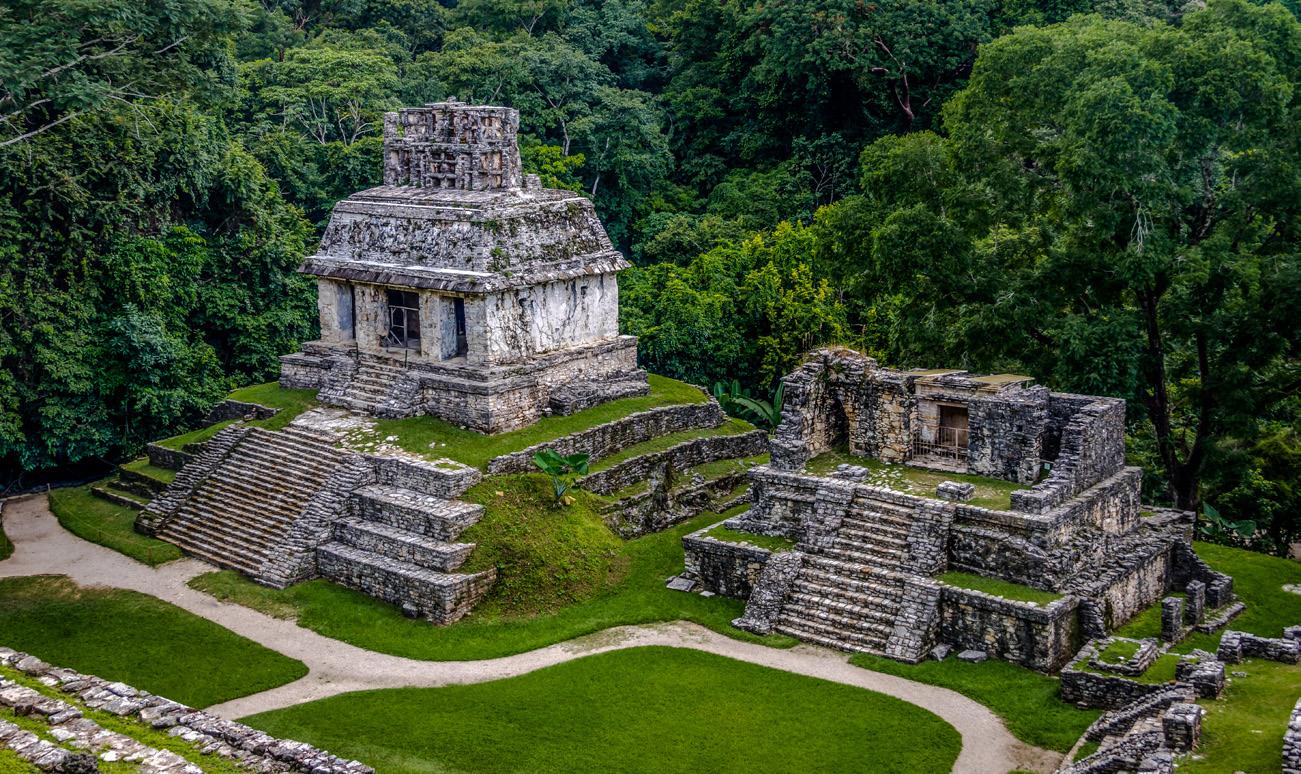
Raised temples set on platforms with steps leading to the top are typical of Maya culture.
Borrowing from the Olmec, the Maya devel oped the technologies of agriculture, architecture, and writing. All early societies have left evidence of studying the night sky, but the Maya made great strides in astronomy and also devel oped a complex calendar. That assisted them in knowing when to plant and harvest and also set the social rituals believed to be so important to a strong harvest. Living in a dryer climate than the Olmec, the Maya also developed successful irrigation methods.
Like so many of the civilizations of Central and South America, the Maya built pyramids. Evidence of this monumen tal architecture still exists throughout present-day Mexico and Central America. Monumental architecture involves large structures, often done to honor the power of the rulers of the society or its gods.
Similar to the Olmec and other societies around the world that developed agriculture in a way that allowed for a large popu lation, the Maya had a highly structured class system. In fact, the gap between ordinary farmers and rulers grew. Rulers were believed to be gods or semi-gods who had to be worshipped.
Religion played a very important role in Maya culture. They frequently held religous ceremonies, which centered around nature, especially the sky. Maya priests were very important in society and usually served as both religious leaders and rulers in Maya communities.
Although it has been difficult to find clear evidence about the roles of women in Olmec culture, this has been easier to discover about the Maya. There is some evidence that women may have had leadership roles, but mainly as substitute leaders. This might occur when their ruler husbands were away or when royal sons were too young to rule.
One of the advantages to successful agriculture for a society is that it allows time for some members of society to learn skills other than farming. In addition to the priests and shamans who knew the secrets of the night sky, other people learned to build complex rainwater reservoirs underground to prepare for droughts. Recent findings show that they developed complex technologies to produce salt. They also invented rubber, produced paper from tree bark, and developed more ways to use chocolate.
An interesting feature of the Maya civilization is that it was not led by a single ruler. Instead, each city had its own ruling elite, with the lower classes living farther away from the central ritual monuments, depending on their status in society. What the entire Maya civilization shared was a common culture and belief system. Various cities tended to rise and fall in importance and power, but any new power shared the same culture as the one it had replaced.
This large Maya pyramid stands in Chichen Itza, Yucatán State, Mexico.

This is a carving of the Maya calendar. The Maya believed that a different god ruled over each day of the Maya Calendar.

Historians believe that the Maya civilization began its roughly 100-year collapse around 800 c.e. Because the Maya were not governed by one central leader, the collapse hap pened over hundreds of years. Each city-state had its own ruler, so while one city-state might collapse, another city-state would flourish for a time. However, it is true that the Maya political system did eventually end as a whole.
There are various theories about why the Maya civiliza tion declined. Because it covered a wide territory with a number of different cities, there are likely many reasons that contributed to its final collapse. In fact, some parts of the civilization seemed to have been abandoned suddenly for some reason. Other regions continued for some time before declining as well.
Drought is likely one cause of the decline. Historians have examined caves throughout areas of the Maya civilization and found evidence of extreme drought starting around 800 c.e. This would likely have interfered with their irrigation system and led to failed crops. Other environmental factors, such as forest loss, have also been suggested as possible causes. Warfare between the Maya cities may also have disrupted the success of their civilization. As city-states rose and fell in power, it may have disrupted the political structure of the Maya civilization. Eventually, the fighting between different city-states may have weakened the overall civilization, contributing to its eventual decline.
Or it might have been simply that the civilization grew too large. The Mayan population may have grown to nearly 15 million people. The farmlands outside the cities may simply not have been able to feed so many people, especially with the drought conditions they were surely facing.
But unlike many ancient civilizations, the Maya themselves did not die out. It is estimated that about six to eight million people identify as descendants of the Maya today. They are the largest group of Indigenous people in North America today. In Guatemala, for example, 40 percent of the popula tion today are descendants of this civilization. Other areas of Mexico and Central America also have a large number of Maya descendants.
In present-day Peru, one of the oldest civilizations of the Americas has been discovered just recently. It existed from around 3700 b.c.e. to about 1800 b.c.e. Archaeologists had been aware of the remains of the civilization, but they had not given it much attention. It was the curiosity and persistence of Ruth Shady Solis, an archaeologist from San Marcos University in Peru that brought the civilization’s importance to world attention.
The Caral Discovery For many years, historians had not been interested in studying the remains of the civilization in part because of its location in the desert of Peru. A desert is not typi cally a promising place for a rich civilization. It also contained no pottery remains, which archaeologists usually interpret as a sign that a site does not date back a significant amount of years. This lack of pottery caused many archeologists to conclude that it was a fairly recent civilization, and therefore not worthy of further study. However, Shady theorized that the lack of pottery could mean quite the opposite: perhaps the civilization was even older than the invention of pottery.
Shady turned out to be right. She sent material discovered in the foundation of the ruins for radio carbon dating. The results, returned in the year 2000, showed that the material was 4,600 years old. This evidence placed the civilization as far back as any ancient culture in the world, including ancient Egypt.
Because so much new evidence has been uncovered recently, the origins of Caral are currently uncertain. But a key question has not been solved. It is not clear why this urban culture devel oped in the first place. Why would a highly complex civilization be built on a massive scale in a desert region when the ocean, and all its life-giving resources, was so nearby?
The mountaintop civilization of Caral included pyramids, residential areas, and wide plazas.
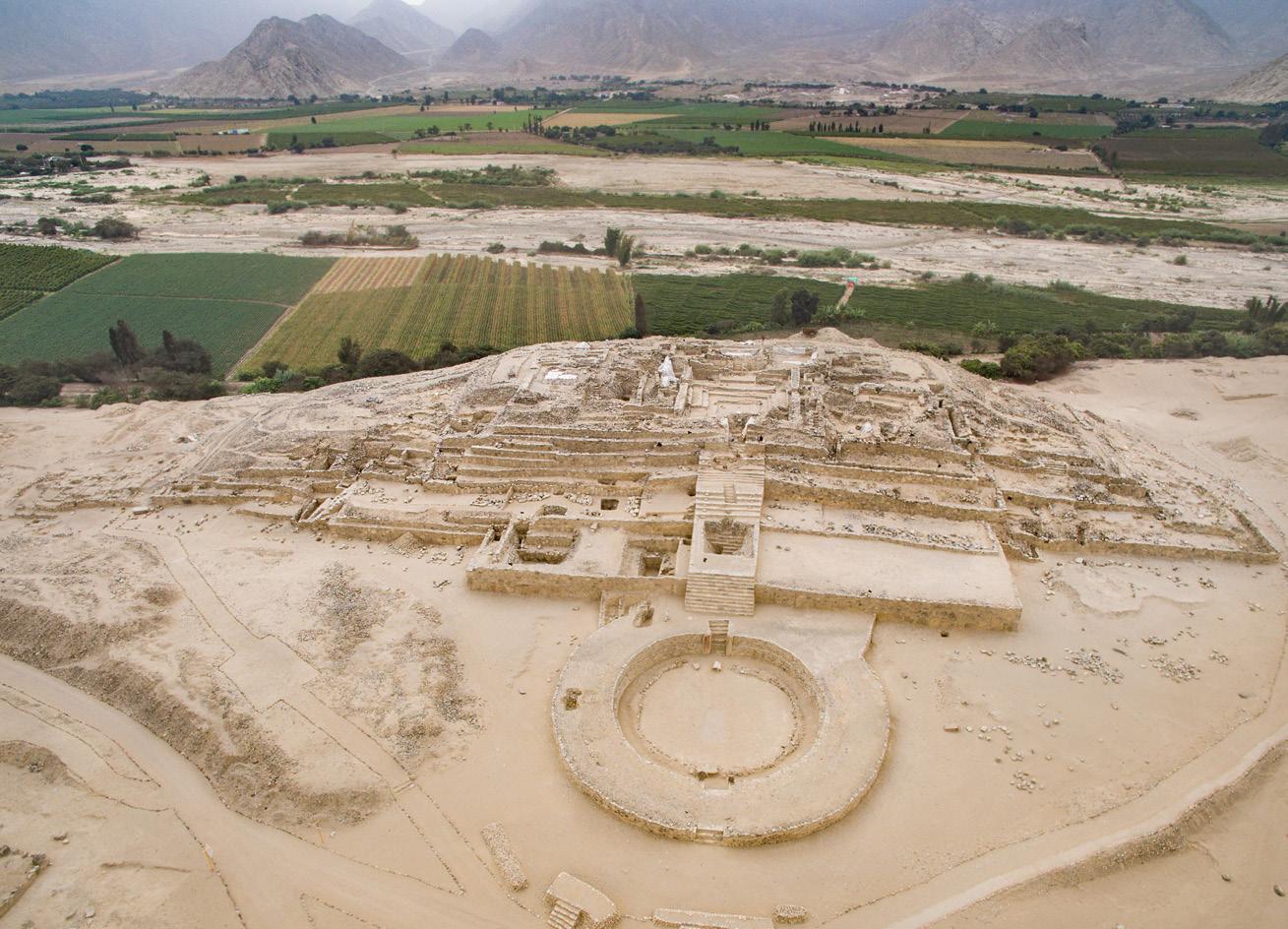
Caral’s amphitheaters were able to hold hundreds of people at community and ritual events.
A favored theory is that Caral functioned as a large-scale trading center. Thousands of workers, experts, and artisans would have been required to construct the many pyra mids, circular staircases, and amphitheaters found in the Caral complex. Trade would also have allowed the necessary food to be imported in order to support the civilization’s large population.

The urban design of Caral indicates a sophisticated city complex. Like many other similar civilizations, the pyramids point to a highly stratified society that practiced complex rituals and ceremonies dedicated to the success of its ruling classes and its social structure. Shady and her team have discovered large comfortable rooms towards the top of pyramids, suitable for the elite. Living quarters suitable for craftspeople were found at the ground level, while poorer-quality huts discovered further away from the pyramids probably housed workers.
Flutes made of pelican and condor bones were discovered in the floor of an amphitheater. These suggest that a highly devel oped musical culture was also enjoyed by this civilization.
Caral Decline
No clear evidence has yet been found to explain just why this civilization eventually died out about a thousand years after it was established. There is no indication of earthquakes or dramatic changes in weather. Political instability creating social breakdown is one possibility.
In North America, the Mississippian civilization began around 800 c.e. Indigenous groups living along the Mississippi River shifted from hunting and gathering lifestyles and began to build settlements. As their agricultural success grew, their settlements also became larger and more complex.
The Mounds of Cahokia show a similarity to the mound building of other civilizations in MesoAmerica and South America.
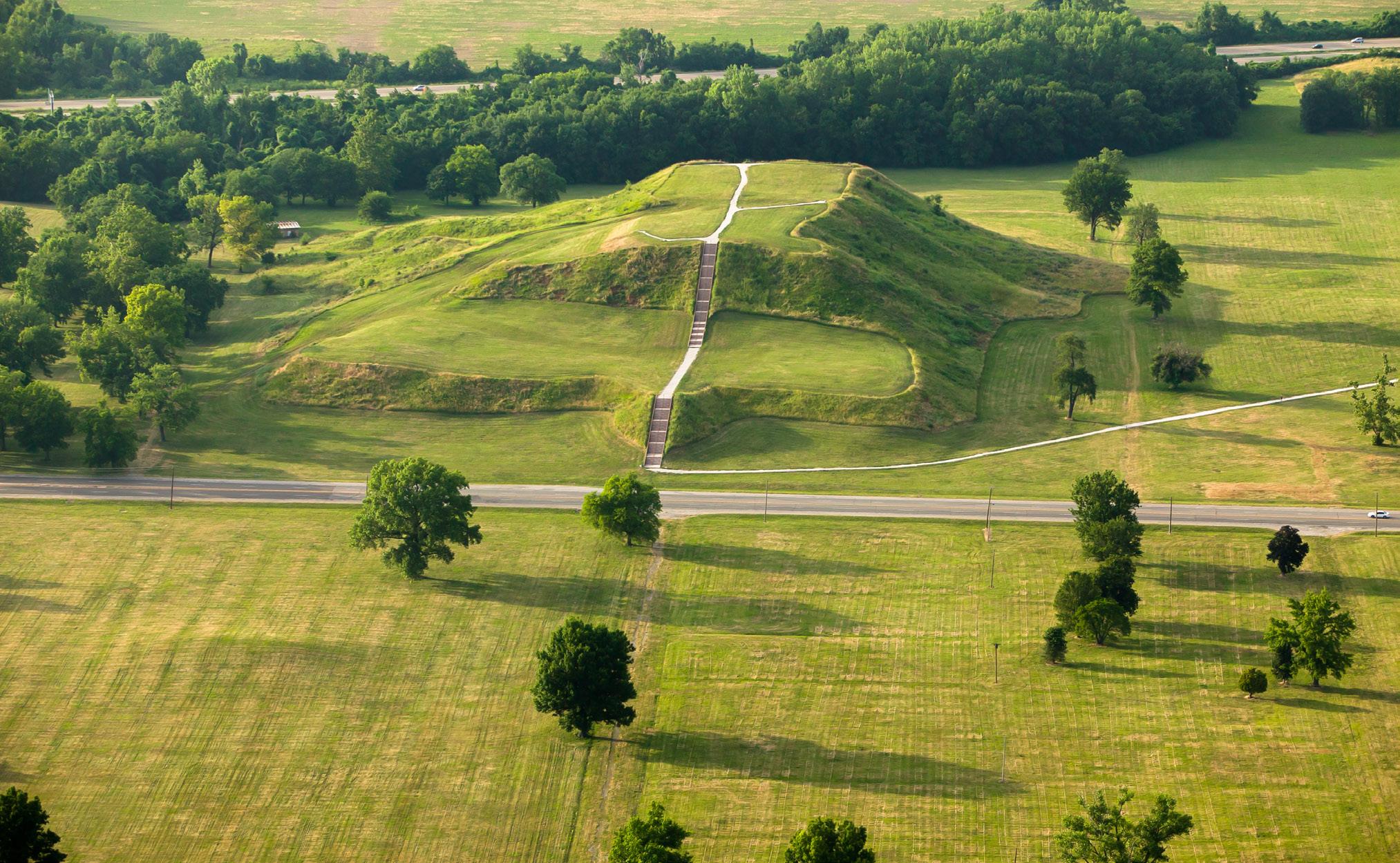
Mississippian Culture
An interesting feature of Mississippian civilization is that it spread into much of the present-day United States and influenced cultures in Canada as well. The last of the ancient civilizations to develop in the Americas, it was one of the most widespread geographically. From its origins along the Mississippi River, it stretched north along the Great Lakes, from the Rockies to the mid-Atlantic, and southwest to the Gulf of Mexico. Recently, new evidence has found that the Spiro group, located on the border of Arkansas and Oklahoma, had developed a society as complex and large as any in the Americas.
The example of the Spiro group reminds us of a key point. Although Mississippian culture was dominant during its time and place, it did not have a single ruler, as the smaller Caral civilization likely had. Instead, like the Maya, this civilization included a large number of independent groups, each with their own ruler and society. However, we can identify many cultural features that all Mississippian groups shared.
Mississippian pottery and ceramics reveal tattoos of the civilization. These artifacts show a great amount of attention paid to detail.
All the branches of these cultures were different from their ancestors who had once migrated. Like other large civilizations in the Americas, they built mounds when the settled. Usually, they built their houses upon the mounds, perhaps to protect them from river flooding or flooding from heavy rain.
The recent excavations at the Spiro group’s area confirm that sometimes leaders built their homes on top of the homes of previous leaders. In this way, it would be easy to broadcast to society who the most recent and important ruler was. He was the one who lived on top of the highest mound.
In addition to that symbol of leadership, we see that these cultures established a hierarchical society in which there was a ruler assisted by an elite that supported and protected his power. This contrasts from the looser forms of power we see in the hunting cul tures of the Inuit. Those communities relied on a level of discussion and agreement in the decision-making process of their close-knit extended family groups.
Mississippian cities survived by cultivating large-scale crops of corn, squash, and beans. Still successfully grown in much of the Americas today, corn (or maize) agriculture allowed Mississippians time to specialize in other crafts and trades, like pottery.
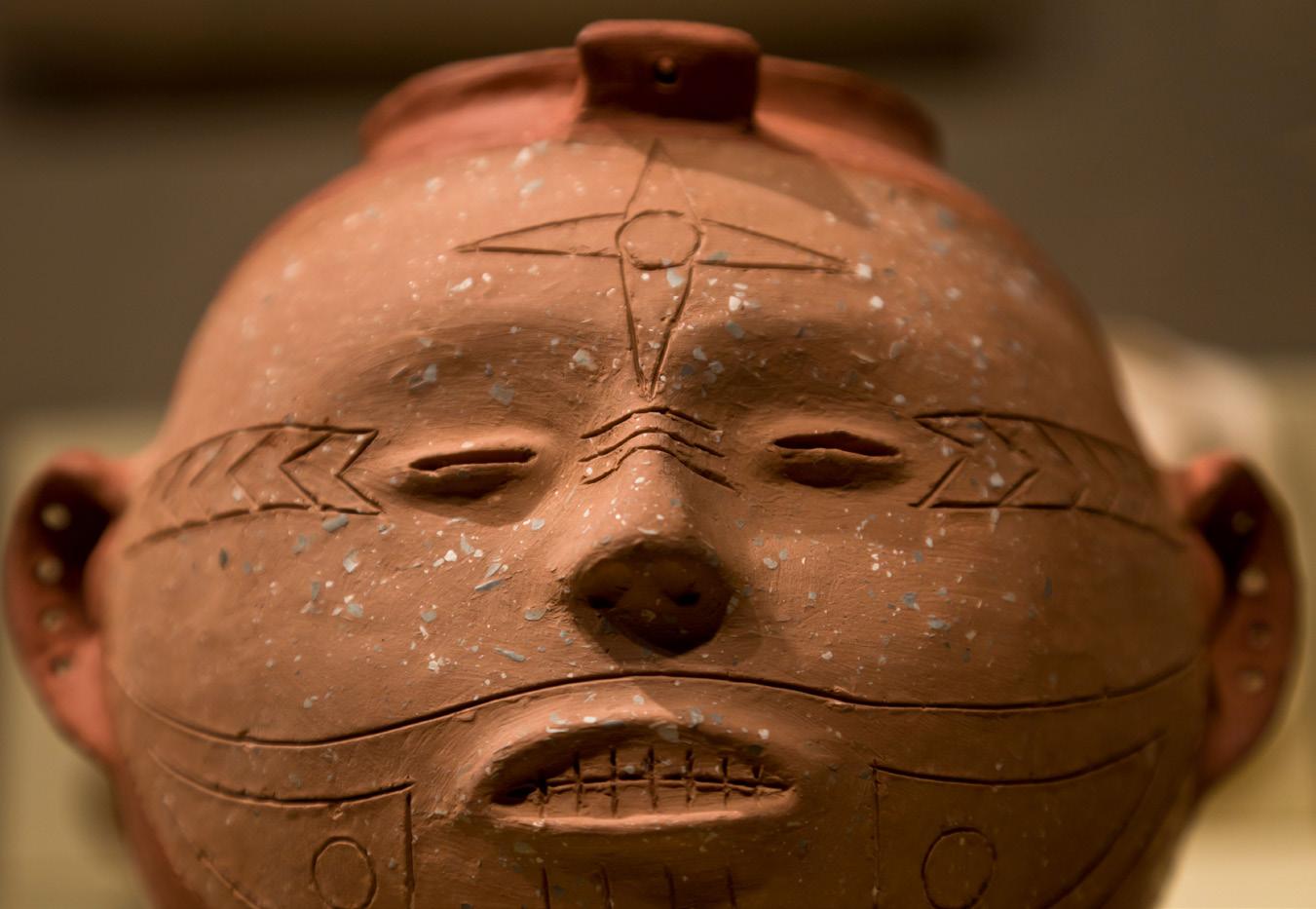
Earlier cultures that needed to migrate to find food specialized in weaving light baskets to carry their belongings. However, because of the success of agriculture, Mississippians could settle in one area. This allowed them to develop the ability to create heavier, tougher containers for their food supplies. Mississippian groups created all kinds of clay and ceramic pots, jars, and jugs. They would often decorate them or shape them into highly creative forms.

The recent findings about the Spiro group also confirm what historians have long suspected. Excavations from the Spiro mound include shell cups from Florida, copper from Lake Superior, and beads from as far away as the California coast.
Mississippian Decline
The Mississippians were still thriv ing when Europeans arrived on the continent in the 15th century c.e. Contact with Europeans impacted the cultures along the Atlantic coast first. Diseases like smallpox, which Mississippians lacked immunity to, destroyed populations. After a few genera tions of chaotic, forced migration, they never knew that their ancestors built this complex civilization.
The ancient civilizations of the Americas are as rich and intriguing as any in the world. Historians are continuing to learn more about them as new evidence is uncovered.
Early Indigenous Cultures The earliest Americans arrived from Asia, although it is uncertain how long ago this happened. Crossing into present-day Alaska, they migrated throughout the continent, most likely following the food supply. They adapted to the diverse environments they encountered. Some settled into farming communities. Several societies developed into large and highly complex civilizations.
Traditions of Early Societies The traditions of these societies enforced their beliefs. The stories they passed down explained nature, their world, and their place in it. Members were valued for the work they contributed and leadership usually required the agreement of the community.
Olmec One of the most influential Central American civilizations was located along the Gulf of Mexico. Like many large, complex societies, the Olmec were much more highly stratified than the smaller hunting and gathering communities. They appear to have grown rich from trade and to have honored their rulers by building large statues of their heads.
Maya This civilization seems to have borrowed many features from the Olmec. It built pyramids and developed writing based on hieroglyphs. The Maya mastered astronomy, creating a calendar that guided the year. They were also skilled engineers, as can be seen from their irrigation and salt-producing systems.
Caral The importance of this civilization has only recently been discovered. Much older than originally estimated, Caral may have been a trading center. The pyramids and amphitheaters they left behind required great technical skill and the labor of thousands to build.
Mississippian This civilization stretched across North America and was composed of several independent groups. Although these societies each had their own leadership and governing structures, they shared several cultural similarities. They lived from large-scale agriculture and trade.
Gather evidence by studying these sources—along with the other sources listed in the Unit Inquiry Project—as you prepare to write an argument answering the unit’s compelling question.

Historians do not know for certain when literature began or the true identity of the first writer to ever exist. However, recent findings suggest that the first named poet in history was a priestess from the Sumerian city-state of Ur named Enheduanna. She was the daughter of the king of the Mesopotamian city Akkad, and is said to have been alive around 2300 b.c.e. As priestess of the Sumerian moon god Nanna, Enheduanna is said to be mentioned in temple hymns dedicated to the moon god. Some historians believe that this could be evidence of Enheduanna’s authorship of the hymns. Below is a translated excerpt from “The exaltation of Inanna” in which Enheduanna asks the great goddess for help after political exile.
I, En-hedu-ana, will recite a prayer to you. To you, holy Inana, I shall give free vent to my tears like sweet beer! I shall say to her “Your decision!” Do not be anxious about Acimbabbar. In connection with the purification rites of holy An, Lugal-ane has altered everything of his, and has stripped An of the E-ana. He has not stood in awe of the greatest deity. He has turned that temple, whose attractions were inexhaustible, whose beauty was endless, into a destroyed temple. While he entered before me as if he was a partner, really he approached out of envy. . . .
Most precious lady, beloved by An, your holy heart is great; may it be assuaged on my behalf! Beloved spouse of Ucumgal-ana, you are the great lady of the horizon and zenith of the heavens. The Anuna have submitted to you. From birth you were the junior queen: how supreme you are now over the Anuna, the great gods! The Anuna kiss the ground with their lips before you. . . . My lady beloved of An, may your heart be calmed towards me, the brilliant en priestess of Nanna!
It must be known! It must be known! Nanna has not yet spoken out! He has said, “He is yours!” Be it known that you are lofty as the heavens! Be it known that you are broad as the earth! Be it known that you destroy the rebel lands! Be it known that you roar at the foreign lands! Be it known that you crush heads! Be it known that you devour corpses like a dog! Be it known that your gaze is terrible! Be it known that you lift your terrible gaze! Be it known that you have flashing eyes! Be it known that you are unshakeable and unyielding! Be it known that you always stand triumphant! . . .
The powerful lady, respected in the gathering of rulers, has accepted her offerings from her. Inana’s holy heart has been assuaged. The light was sweet for her, delight extended over her, she was full of fairest beauty. Like the light of the rising moon, she exuded delight. Nanna came out to gaze at her properly, and her mother Ningal blessed her. The door posts greeted her. Everyone’s speech to the mistress is exalted. Praise be to the destroyer of foreign lands, endowed with divine powers by An, to my lady enveloped in beauty, to Inana!
King Hammurabi of Babylonia created a code of laws to keep order in his empire. He wanted to make sure he brought justice to all of his people. He brought together existing laws from each Mesopotamian city-state he conquered. He displayed the code publicly in a temple and appointed royal judges to decide cases. A person was innocent until proven guilty. Once found guilty, a person was punished according to the code. The punishments ranged from fines to death.
Below are selections from the Code of Hammurabi. Notice especially Number 196, “eye for an eye,” and Number 200, “tooth for a tooth.” These are the most well-known of the laws. As you read the excerpts, think about these questions: What other crimes are identified? What are some of the punishments used? Are the punishments the same for everybody?
2. If any one bring an accusation against a man, and the accused go to the river and leap into the river, if he sink in the river his accuser shall take possession of the house. But if the river prove that the accused is not guilty, and he escape unhurt, then he who had brought the accusation shall be put to death, while he who leaped into the river shall take posssession of the house that had belonged to his accuser.
3. If any one bring an accusation of any crime before the elders, and does not prove what he has charged, he shall, if it be a capital offense [punishable by death] . . . , be put to death.
5. If a judge try a case, reach a decision and present his judgment in writing; if later error shall appear in his decision, and it be through his own fault, then he shall pay twelve times the fine set by him in the case, and he shall be publicly removed from the judge’s bench, and never again shall he sit there to render judgment.
6. If any one steal the property of a temple or of the court, he shall be put to death, and also the one who receives the stolen thing from him shall be put to death.
14. If any one steal the minor son of another, he shall be put to death.
22. If any one is committing a robbery and is caught, then he shall be put to death.
55. If any one open his ditches to water his crop, but is careless, and the water flood the field of his neighbor, then he shall pay his neighbor corn for his loss.
195. If a son strike his father, his hands shall be hewn [chopped] off.
196. If a man put out the eye of another man, his eye shall be put out.
200. If a man knock out the teeth of his equal, his teeth shall be knocked out.
202. If any one strike the body of a man higher in rank than he, he shall receive sixty blows with an ox-hide whip in public.
203. If a free born man strike the body of another free born man of equal rank, he shall pay one gold mina [a weight of 1.25 pounds].
205. If the slave of a freed man strike the body of a freed man, his ear shall be cut off.
“The Code of Hammurabi: King of Babylon (About 2250 B.C.), Parts I, II, and III in The Independent. Pt. I Vol. LV, NY, Thursday, January 8, 1903, No. 2823, p. 67; Pt. II, Vol. LV, NY, Thursday, January 15, 1903, No. 2824, p. 127; Pt. III, Vol. LV, NY, Thursday, January 22, 1903, No. 2825, p. 183. Entire Selection: https://books.google.com/books?id=yrbPAAAAMAAJ&pg=PA67&dq

Every state has traditions about how someone becomes the ruler. In the United States, there are elections. In many countries with monarchies, it is often the ruler’s oldest child or oldest male child who ascends the throne when the ruler dies.
In the Achaemenid Empire of ancient Persia, the general custom was for the ruler to appoint someone from his family to follow him. Darius I was not, as far as anyone knew, related to Cyrus II and his son Cambyses I. Yet Darius became the king of Persia in 522 b.c.e. after the death of Cambyses.
Darius claimed that he was a descendent of Achaemenes and that Cyrus was as well. But Cyrus, it seems, was not actually related to Darius.
You will examine a primary source by Darius, who wrote to defend his right to be king. In this translation of Darius’s royal inscription at Behistun, he explains the actions, choices, and circumstances that prove his right to claim the throne.
The relief sculpture that you see here accompanies the inscription at Behistun. It shows Darius I standing and holding a bow, a symbol of kingship, with his foot on the chest of Gaumata the usurper, whose arms are raised in supplication. Facing Darius are men who led revolts against him after he took the throne, as recorded in the inscription. Behind Darius stand Gobryas, his spear-bearer, and Aspathines, who holds his bow. Darius doesn’t mention them. According to Herodotus, they were two of his co-conspirators in his plot to attain the throne.
This relief sculpture at Behistun is surrounded by Darius’s inscriptions.

(9) Darius the King proclaims: Auramazda [Auramazda] bestowed this kingship on me; Auramazda gave me his help until I gained the kingship; by the favour of Auramazda I possess this kingship.

(10) Darius the King proclaims: This is what was done by me after I became king: the son of Cyrus, by name Cambyses, of our family, he was king here; this Cambyses had a brother, by name Bardiya; he had the same mother, the same father as Cambyses; then Cambyses killed that Bardiya; when Cambyses killed Bardiya, the people did not know that Bardiya had been killed; then, Cambyses went to Egypt. When Cambyses had gone to Egypt, then the people became disloyal; and the Lie grew among the people, both in Persia and Media, and among the other peoples.
(11) Darius the King proclaims: Then there was a man, a magus, Gaumata by name; he rebelled. . . . fourteen days of the month Viyakhna had gone (11 March 522), when he rebelled. He lied thus to the people: ‘I am Bardiya, son of Cyrus, brother of Cambyses.’ Then all the people became rebellious against Cambyses; they went over to [Gaumata, whom they thought was Bardiya], both Persia and Media, as well as the other peoples. He seized the kingship; nine days of the month Garmapada had gone (1 July 522), then he seized the kingship. After that, Cambyses died his own death.
(12) Darius the King proclaims: This kingship which Gaumata the magus took away from Cambyses, this kingship had belonged for a long time to our family. After that, Gaumata the magus took it away from Cambyses; he took to himself Persia, Media, as well as the other peoples/countries; he made them his own; he became king.
(13) Darius the King proclaims: There was no man, neither a Persian, nor a Mede, nor anyone of our family, who could take the kingship away from that Gaumata the magus. The people were very much afraid of him, (thinking that) he would kill many people who had known Bardiya previously. Here is the reason that he might have killed people: ‘Lest they know that I am not Bardiya, son of Cyrus.’ No one dared to say anything about Gaumata the magus until I came. Then I invoked Auramazda. Auramazda brought me help. Ten days of the month Bagayadis had passed (29 September 522), then I, with a few men killed that Gaumata the magus, and his foremost followers. A fortress, by name Sikayahuvati, a district by name Nisaya, in Media, that is where I killed him. I took the kingship away from him; with the help of Auramazda, I became king; Auramazda granted me the kingship.
(14) Darius the king proclaims: The kingdom which had been taken away from our family, I re-established it, I put it back in its place. In accordance with what had been previously, I made the cult-centres [places of worship] that Gaumata the magus destroyed. I restored to the people, the pastures and herds, the household slaves and the houses/domains, which Gaumata the magus took away from them. I re-established the people on its foundation, Persia, Media and the other peoples. In accordance with what had been previously, I brought back what had been taken away. By the favor of Auramazda, this is what I did.
Bisitun Inscription of Darius paragraphs 9–14 in The Persian Empire: A Corpus of Sources from the Achaemenid Period by Amélie Kuhrt. NY: Routledge, 2007. pp. 143–4. Used by permission of Amélie Kuhrt.

About 4000 b c e
First Cities
Ancient Mesopotamians establish the city of Ur along the Euphrates River.
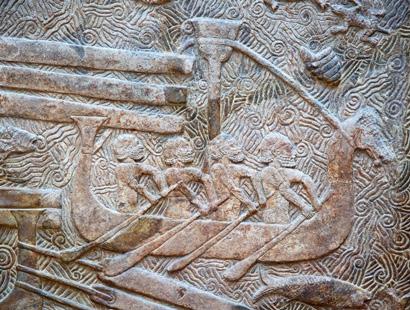

About 3500 –3000 b.c.e. Sumerians Create City-States Sumerians use irrigation to provide a stable food supply, enabling villages to grow into powerful city-states.
About 2400 b.c.e.
Cuneiform
Sumerians develop a written language, called cuneiform, to record information about trade.
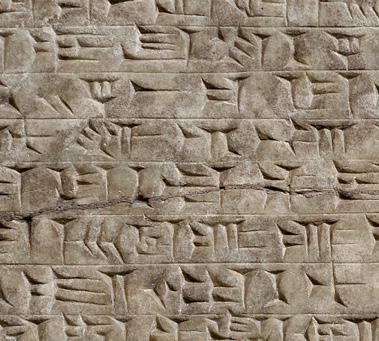
About 3700–1800 b.c.e.
The oldest known civilization of the Americas, the Caral culture, is established in the area of modernday Peru. It is theorized that Caral was a center for large-scale trade.
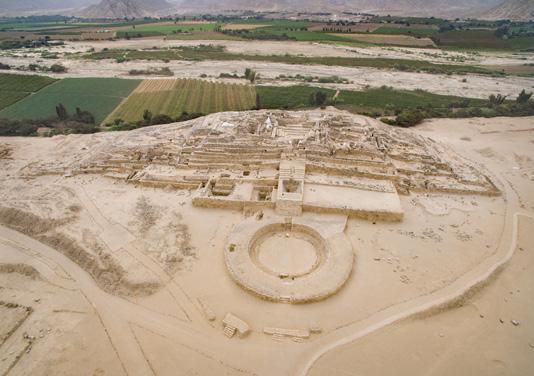
About 2300 –2100 b c e Akkadian Empire
Akkadians build the world’s first empire in the Fertile Crescent region.
About 1792–1750 b c e
Code of Hammurabi
King Hammurabi creates a code of laws to unify and preserve order in the Babylonian Empire.

Challenge
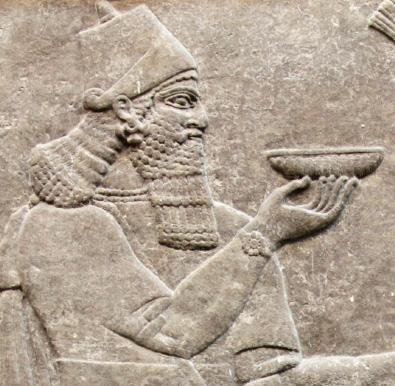
1500–400 b.c.e.
The Olmec
Established on the Mexican coast of the Gulf of Mexico, the Olmec are widely known for large sculptures of male heads believed to depict important rulers.
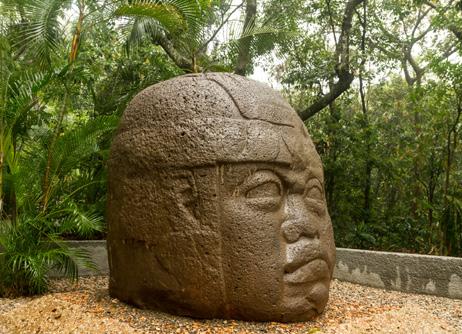
2000 b.c.e.–900 c.e.
The Maya
The Maya, established in Central America, develop technologies of agriculture, architecture, and writing that lead them to their “golden era” by 250 c

About 224–650 c.e.
The Sasanian Empire
Ardashir I, King of Parsa, conquers territories along the Persian Gulf and modern day Iran to establish the last Persian empire.
About 605 539 b.c.e.
The Neo-Babylonians make advances in the fields of mathematics and astronomy.
About 510–490 b.c.e. Persian Bridges and Canals Darius I and Xerxes have temporary bridges built to cross the Hellespont during the Greco-Persian Wars.
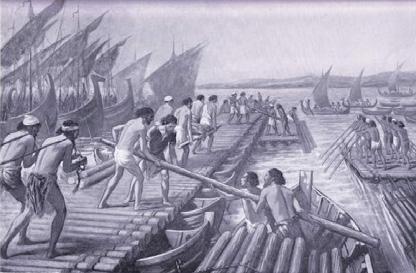
About 500–330 b c e
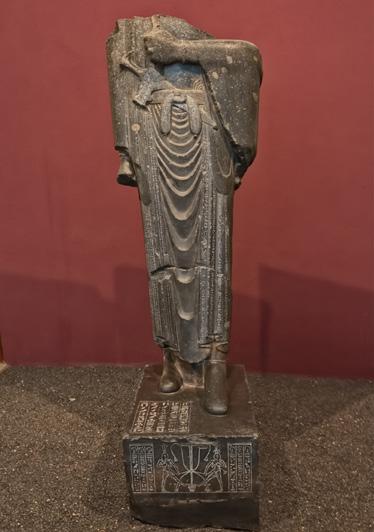

The First Persian Empire
The Achaemenid Empire is the first empire established in Persia north of the Persian Gulf, founded by Darius I.
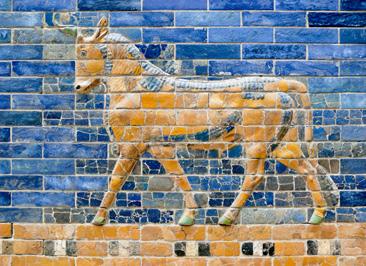





links to below to explore each component.